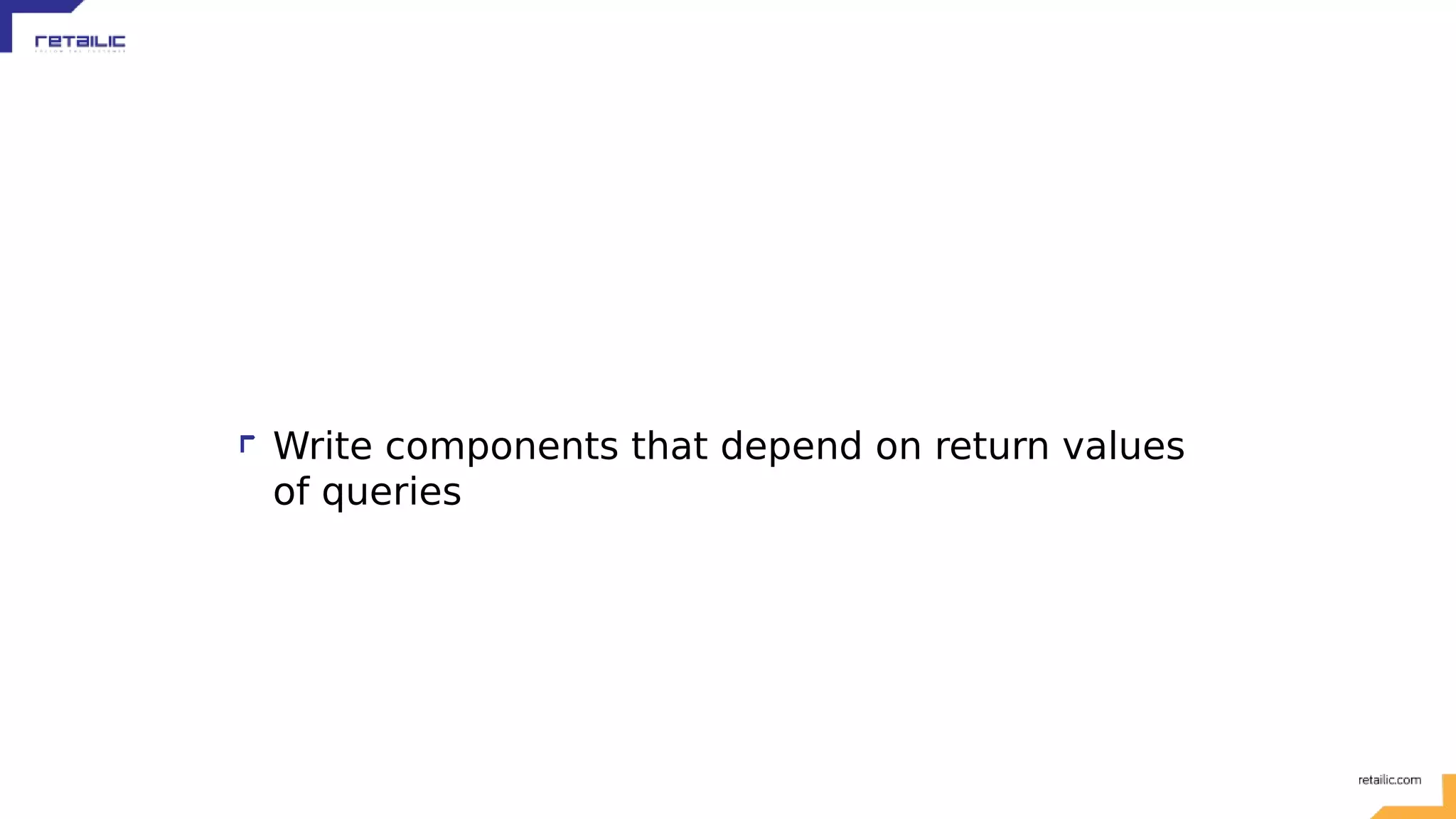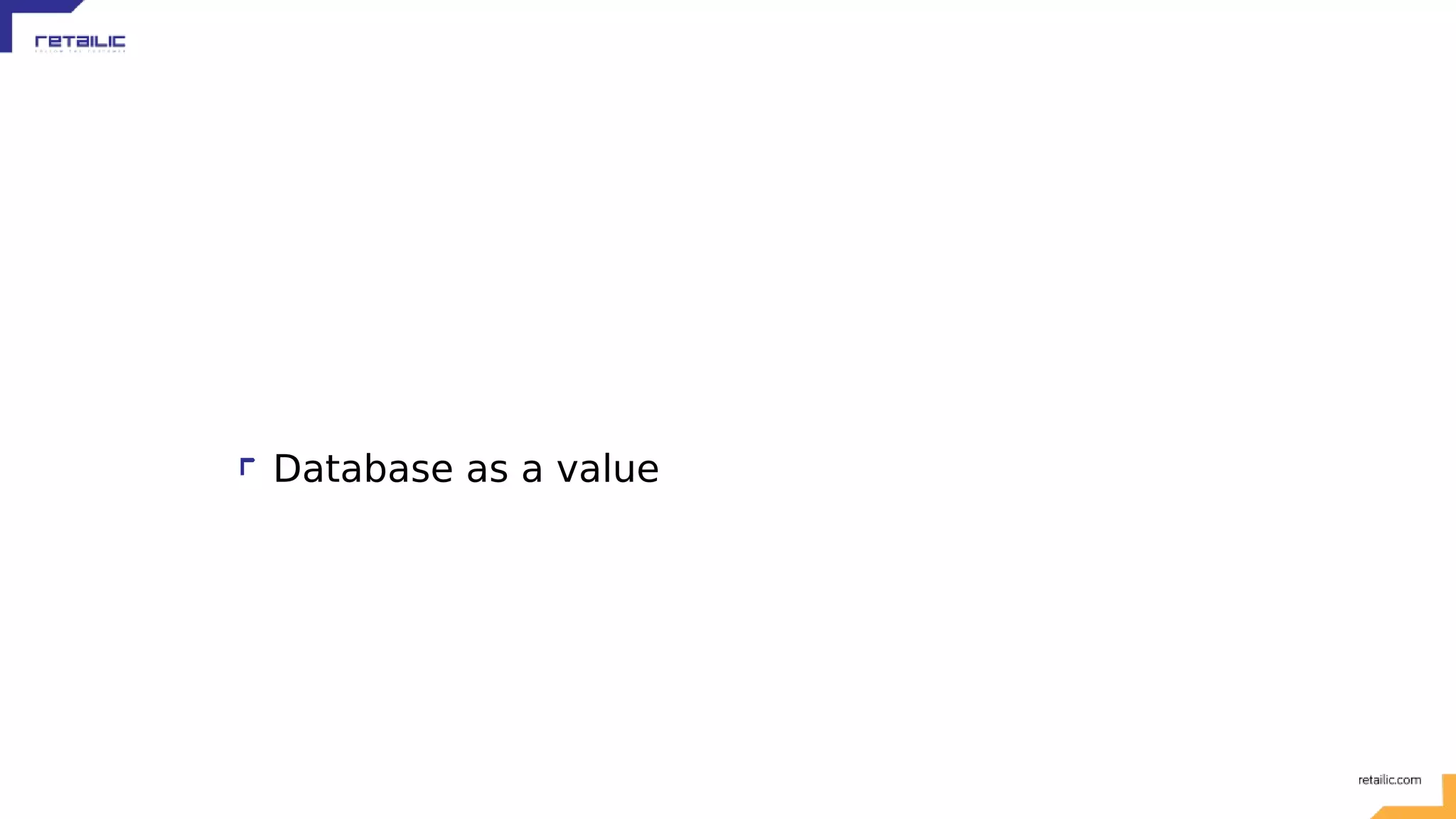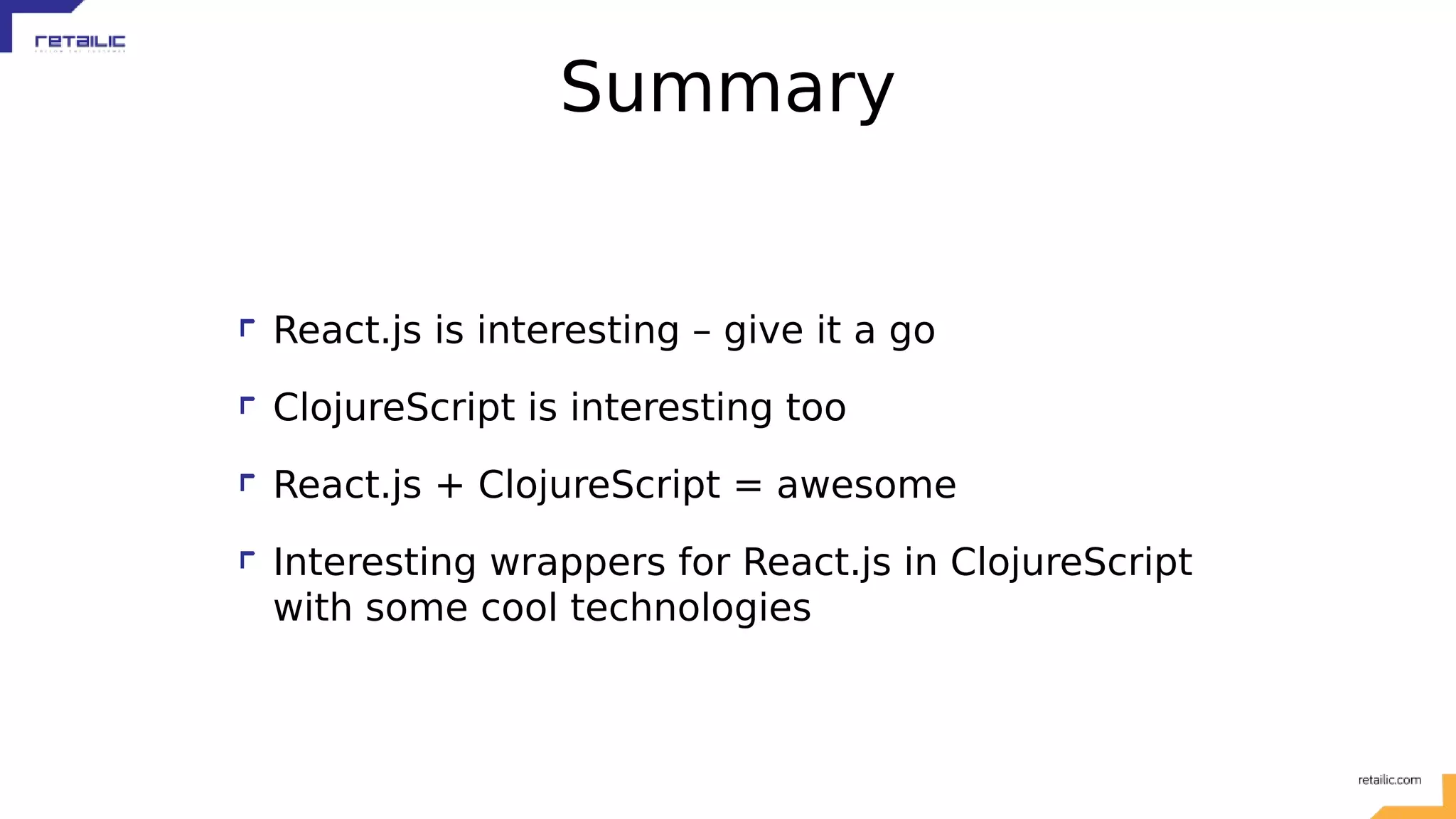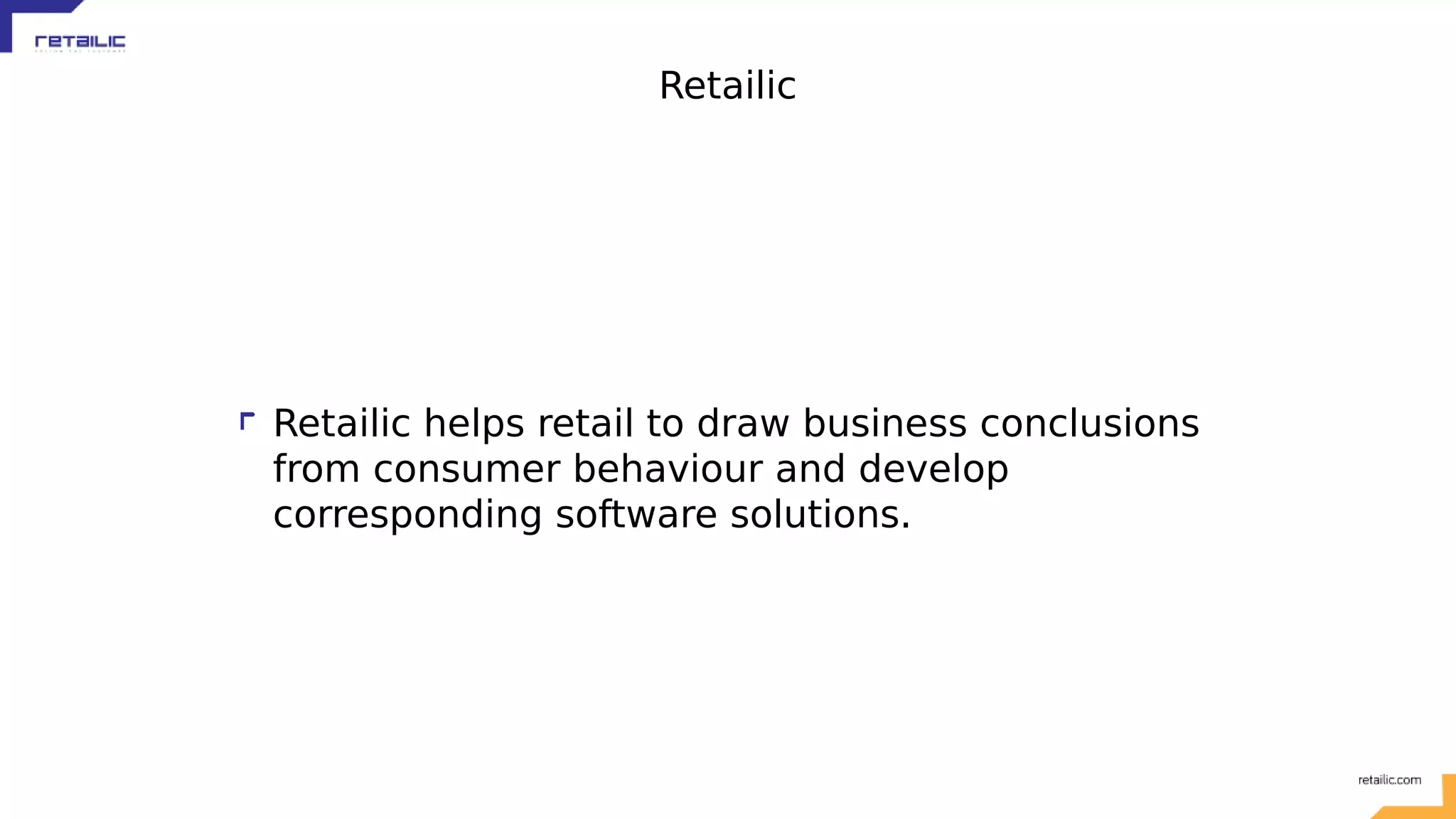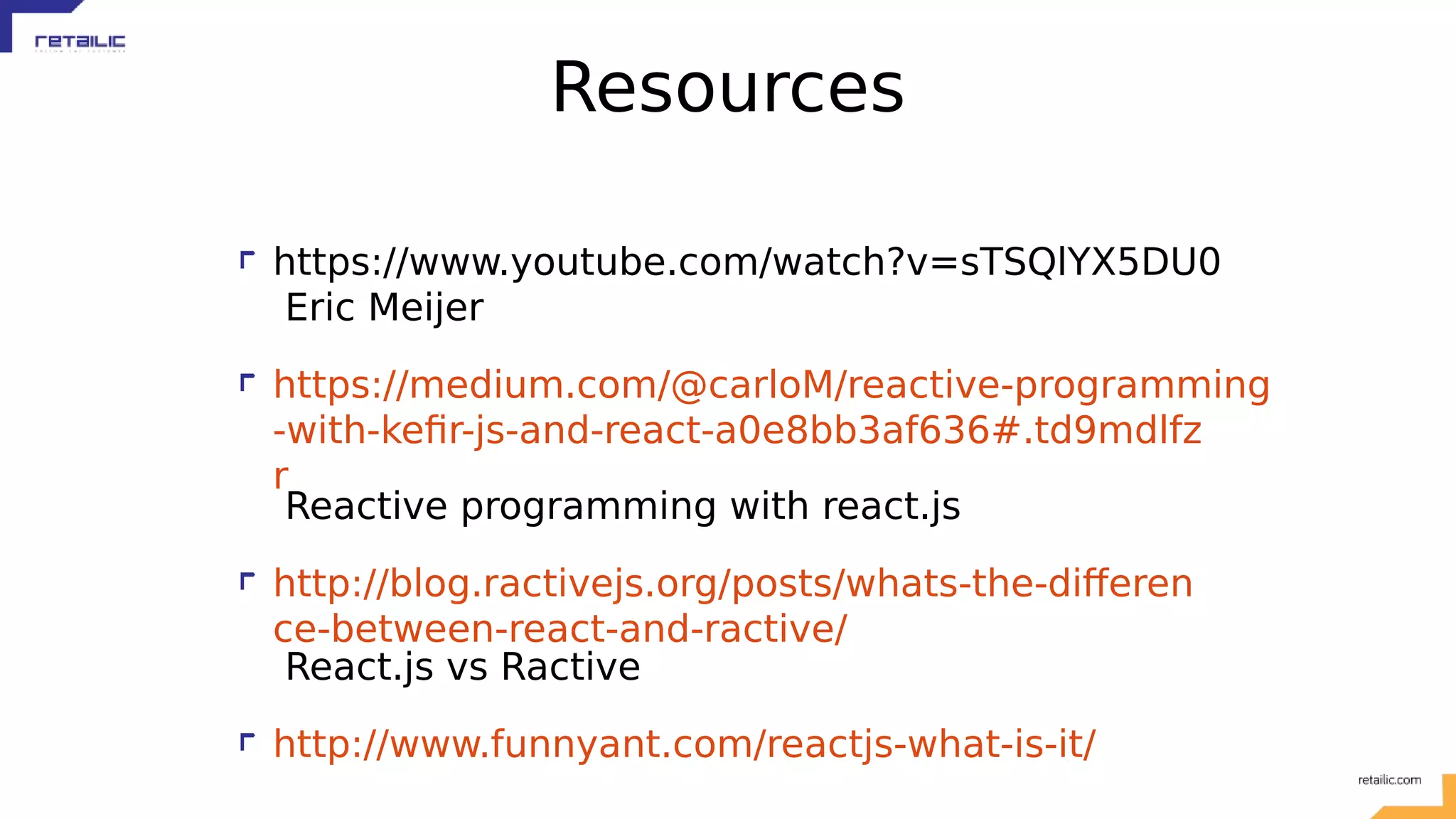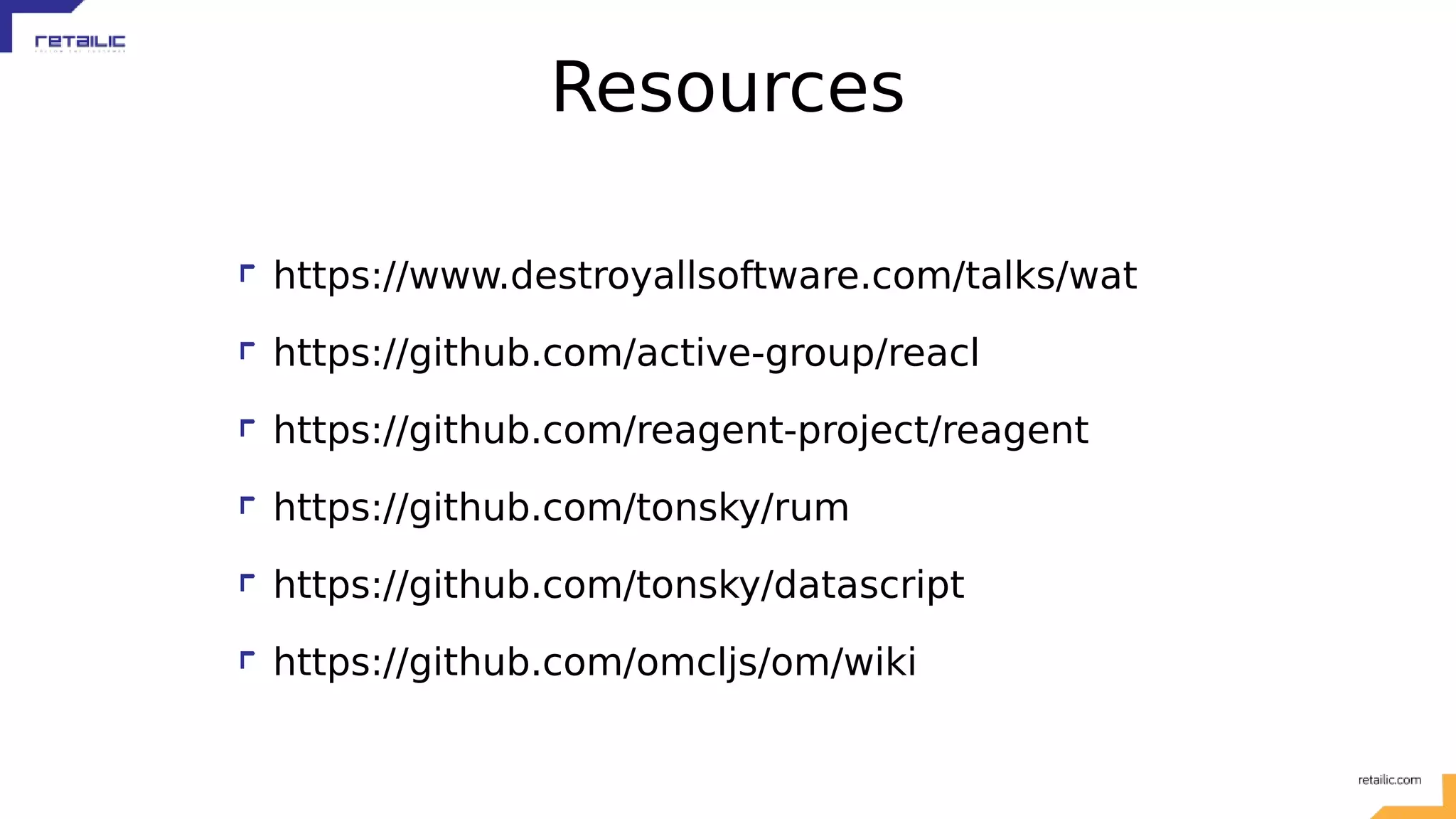This document summarizes a talk on reactive programming in ClojureScript using React.js wrappers. It discusses the state of web development, plain JavaScript, frameworks like jQuery and MVC, and React.js. It then covers what reactive programming means, how components react to events and state changes, and how frameworks help address issues with DOM manipulation. Rum and other ClojureScript wrappers for React.js are described as leveraging immutable data structures and providing component mixins. Om.next is discussed as taking inspiration from other systems and focusing on queries over cursors to navigate graph-like data. Datascript is presented as an immutable in-memory database with Datalog querying that can be used to centrally manage application state

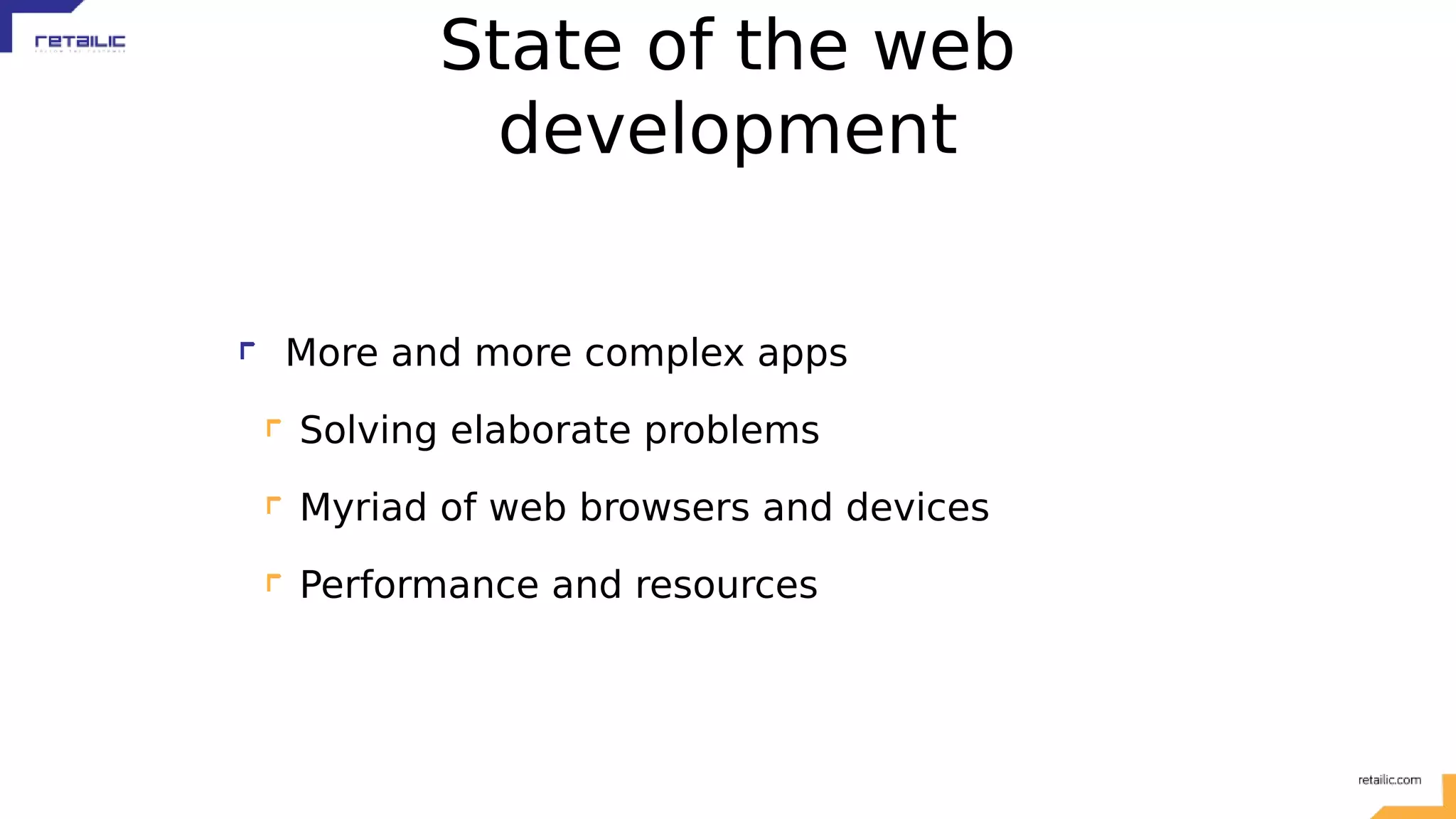
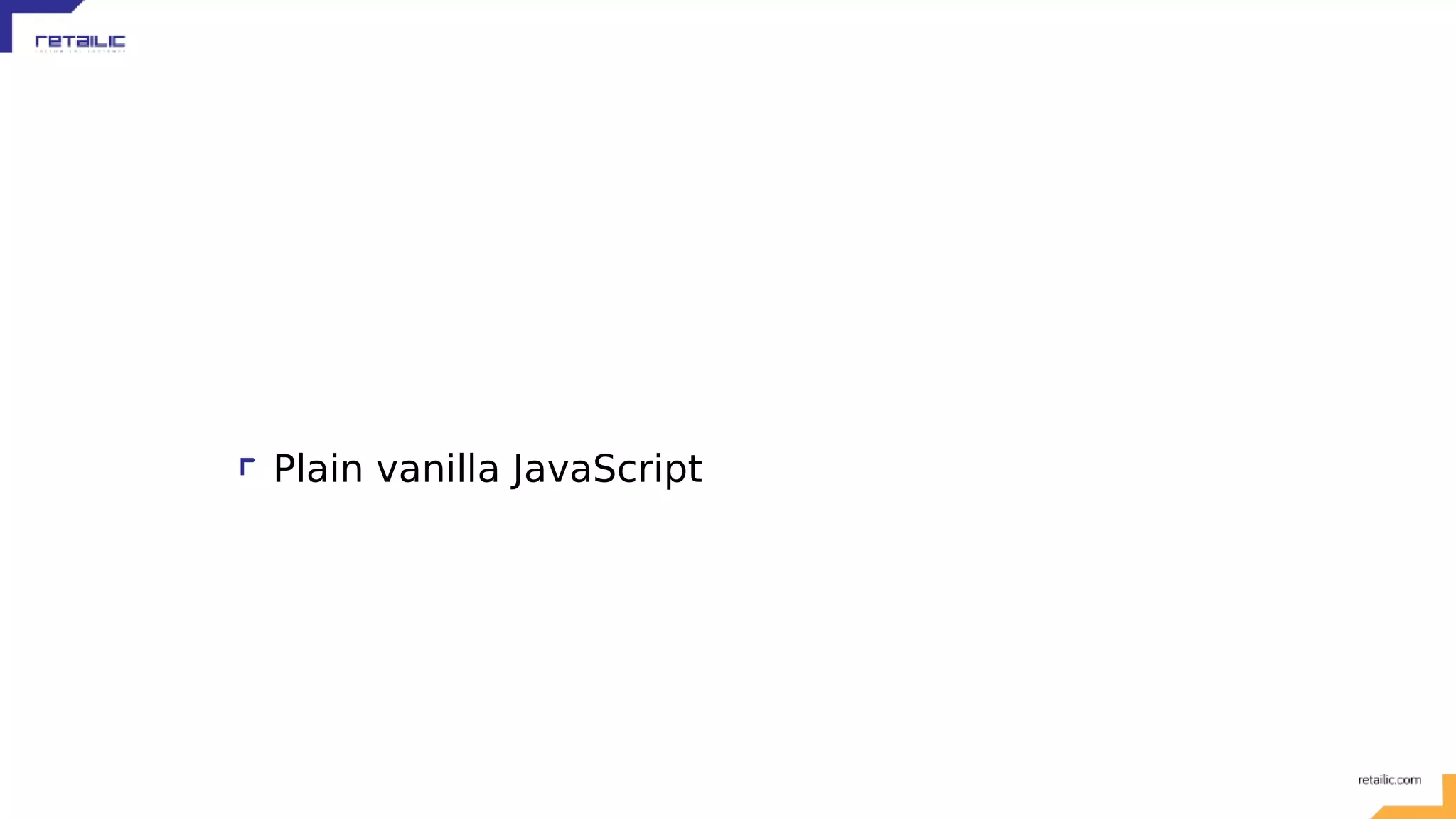


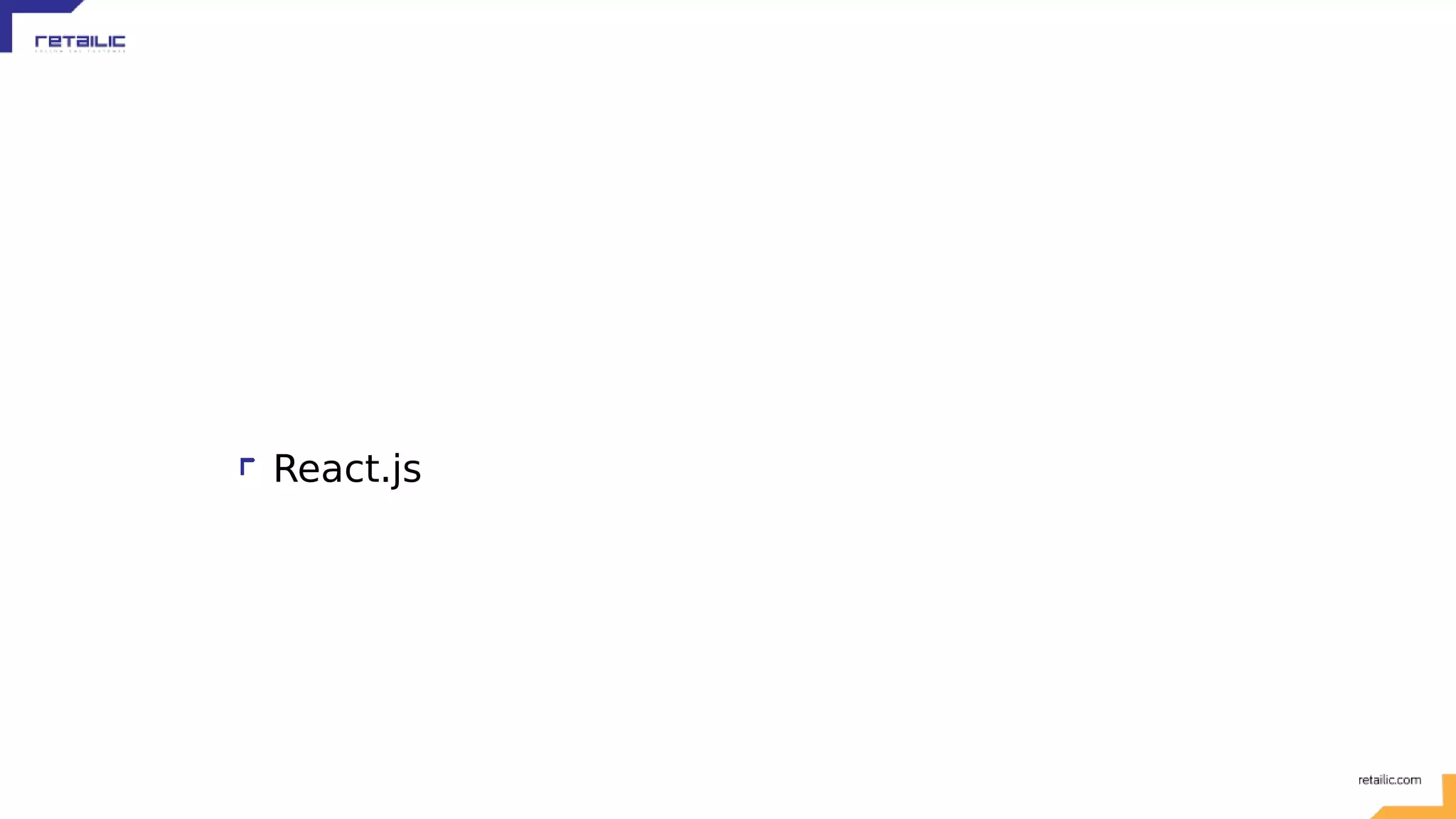
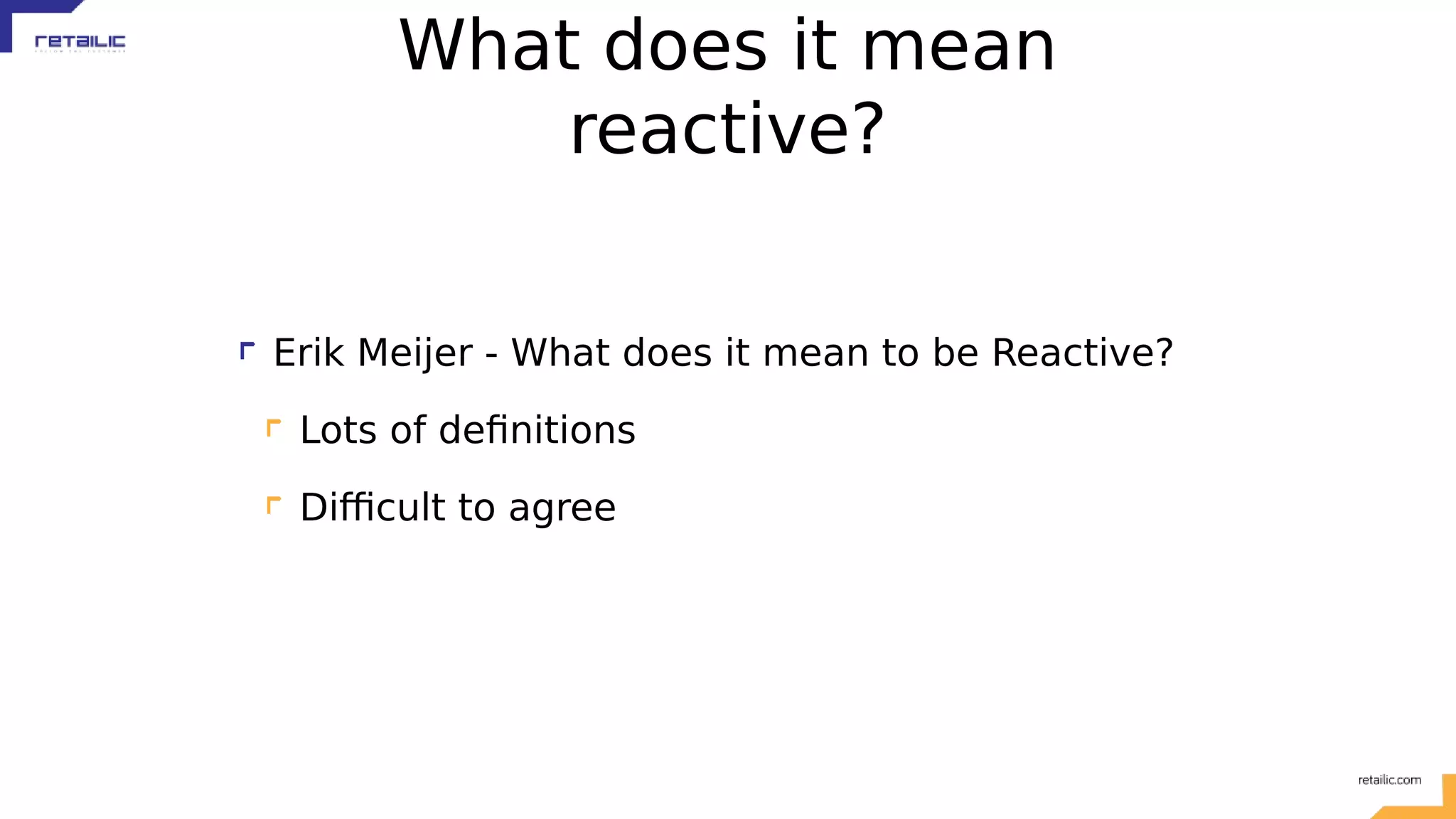
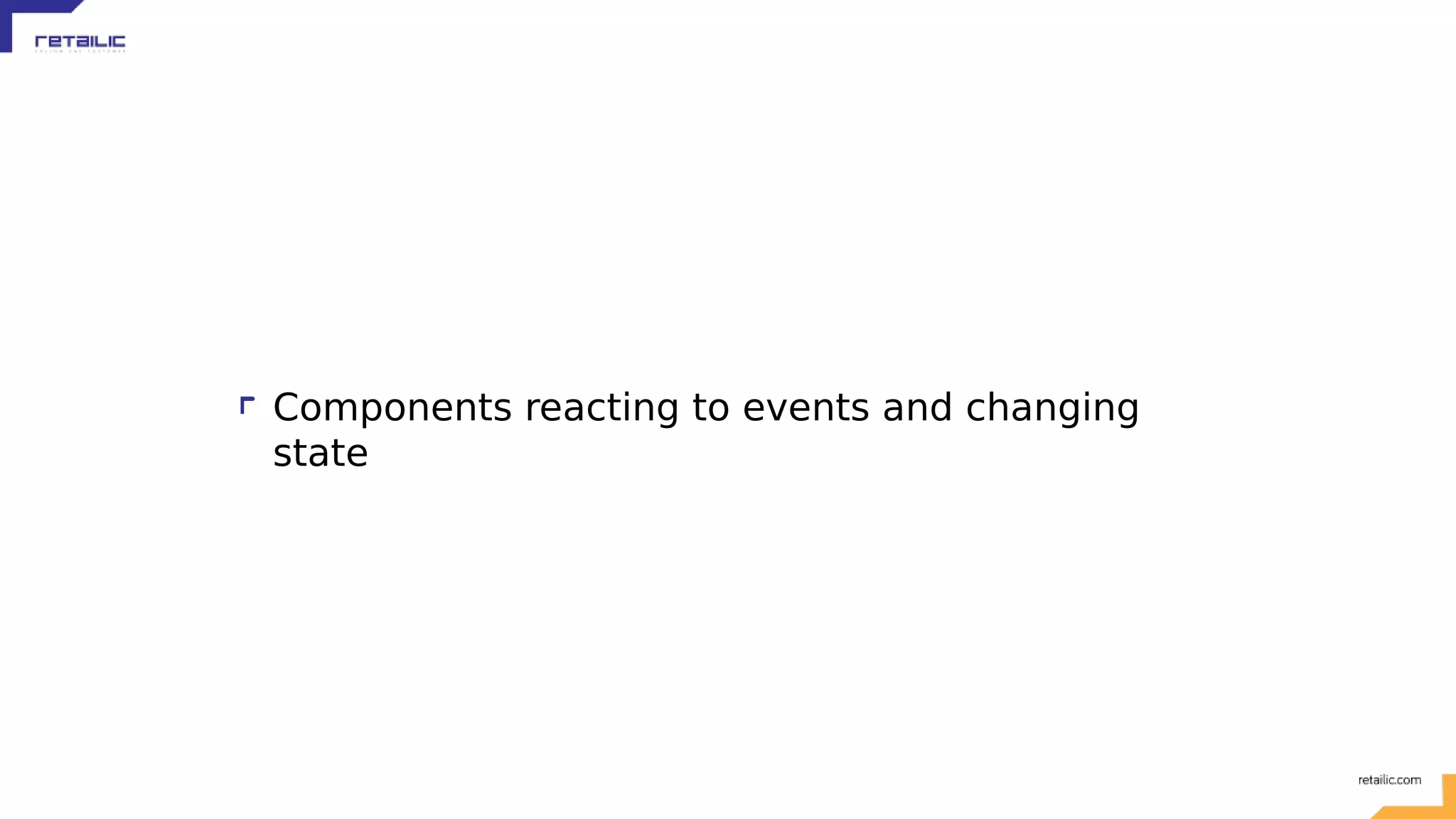
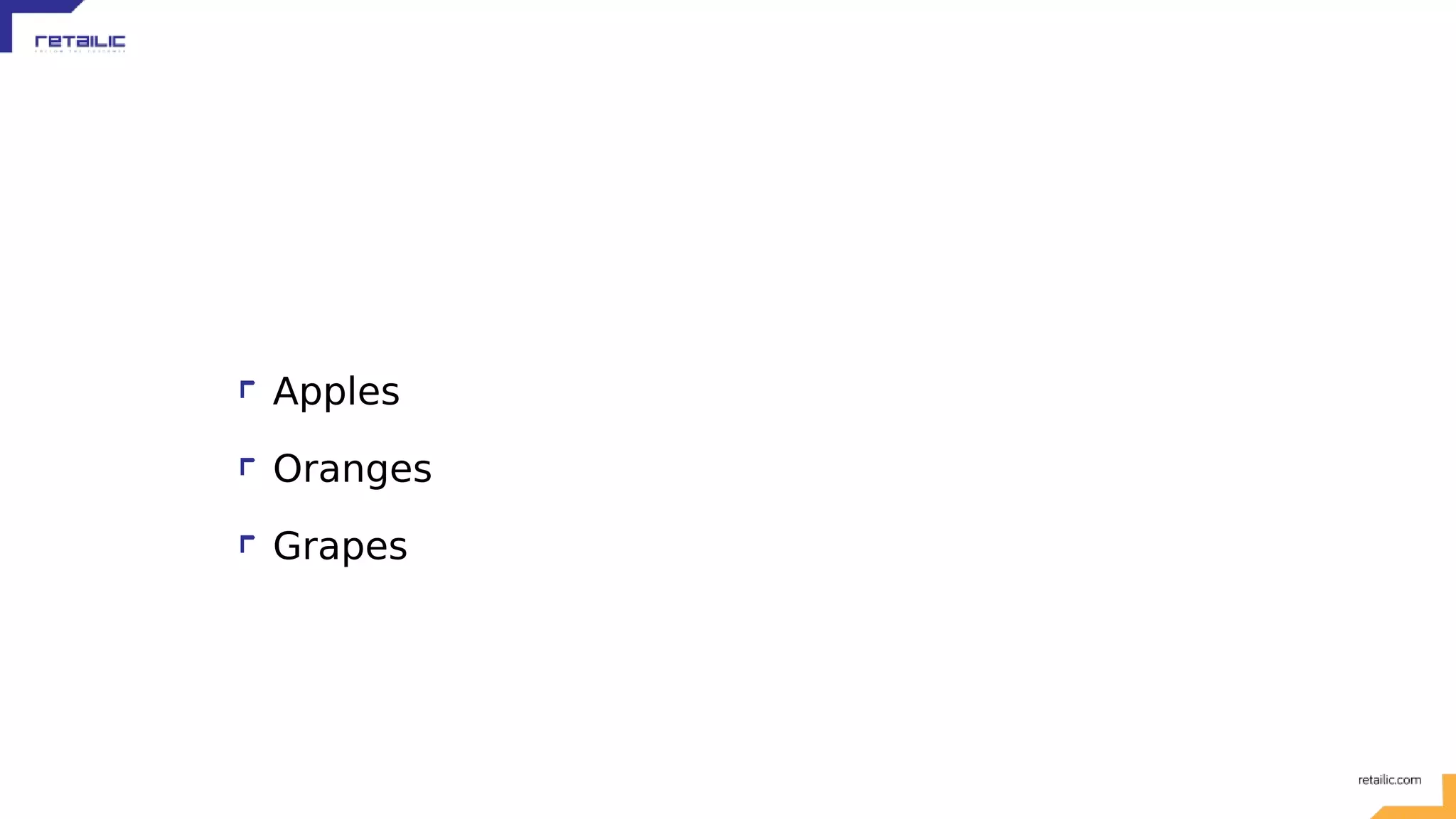
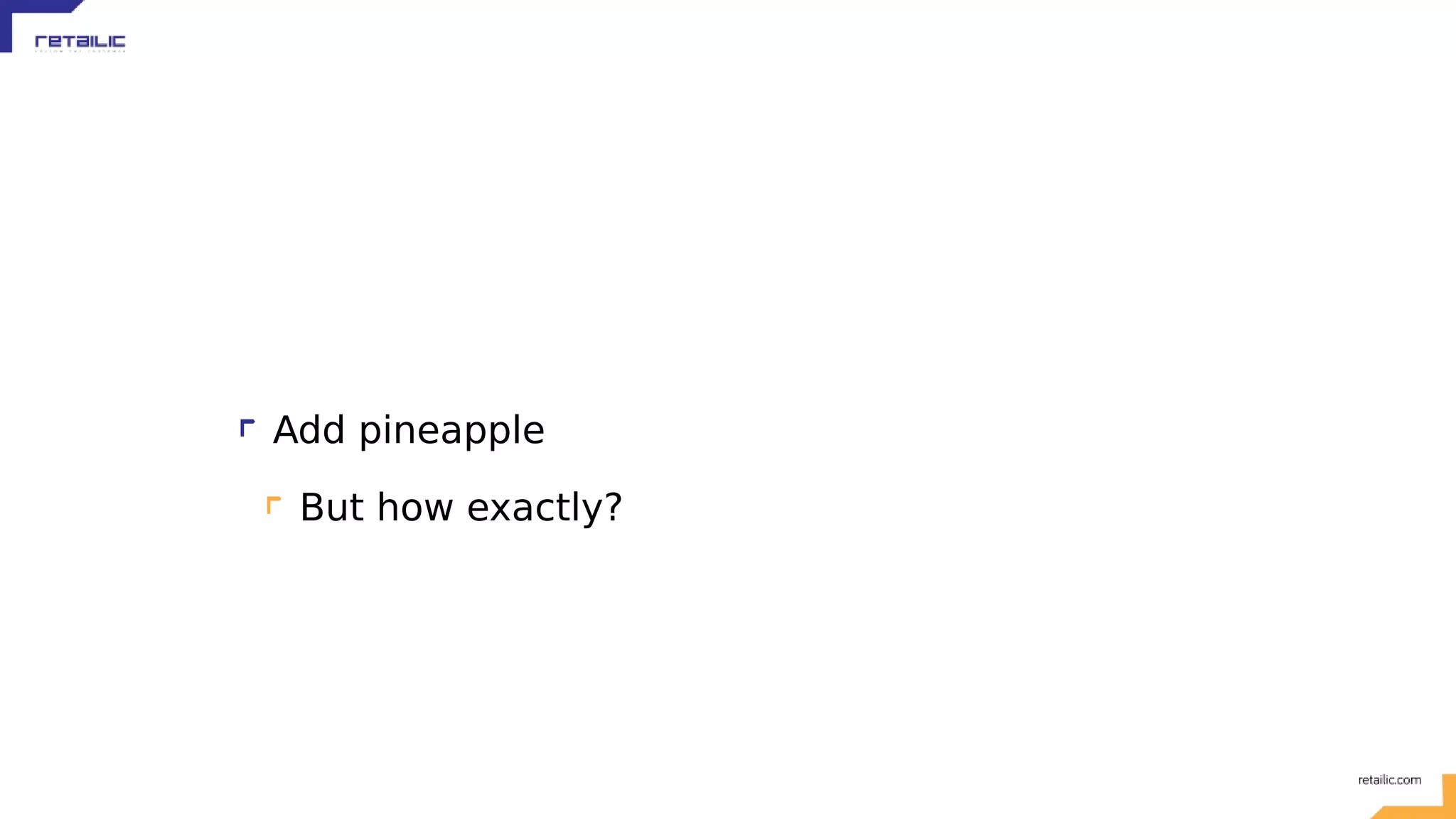
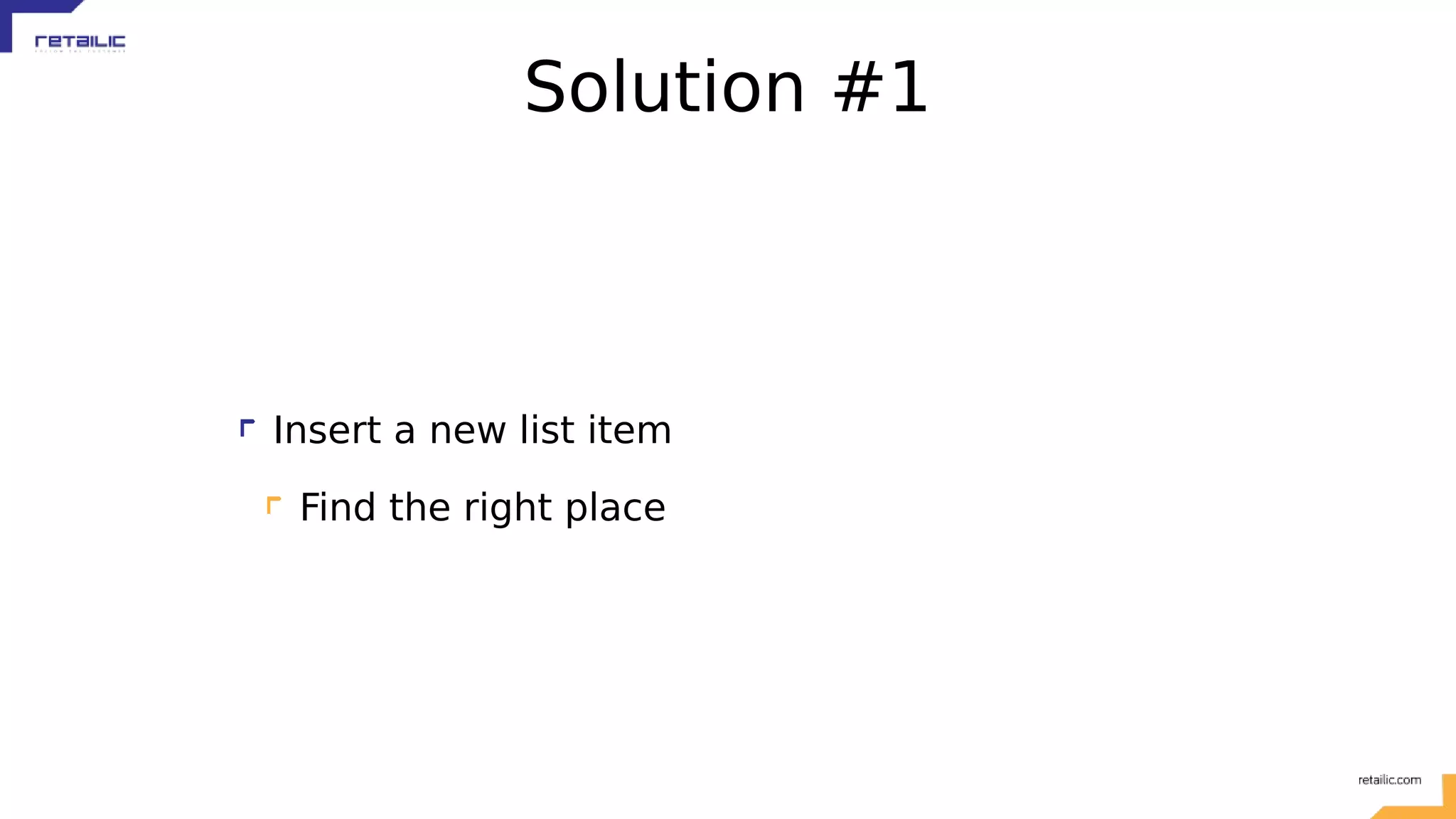
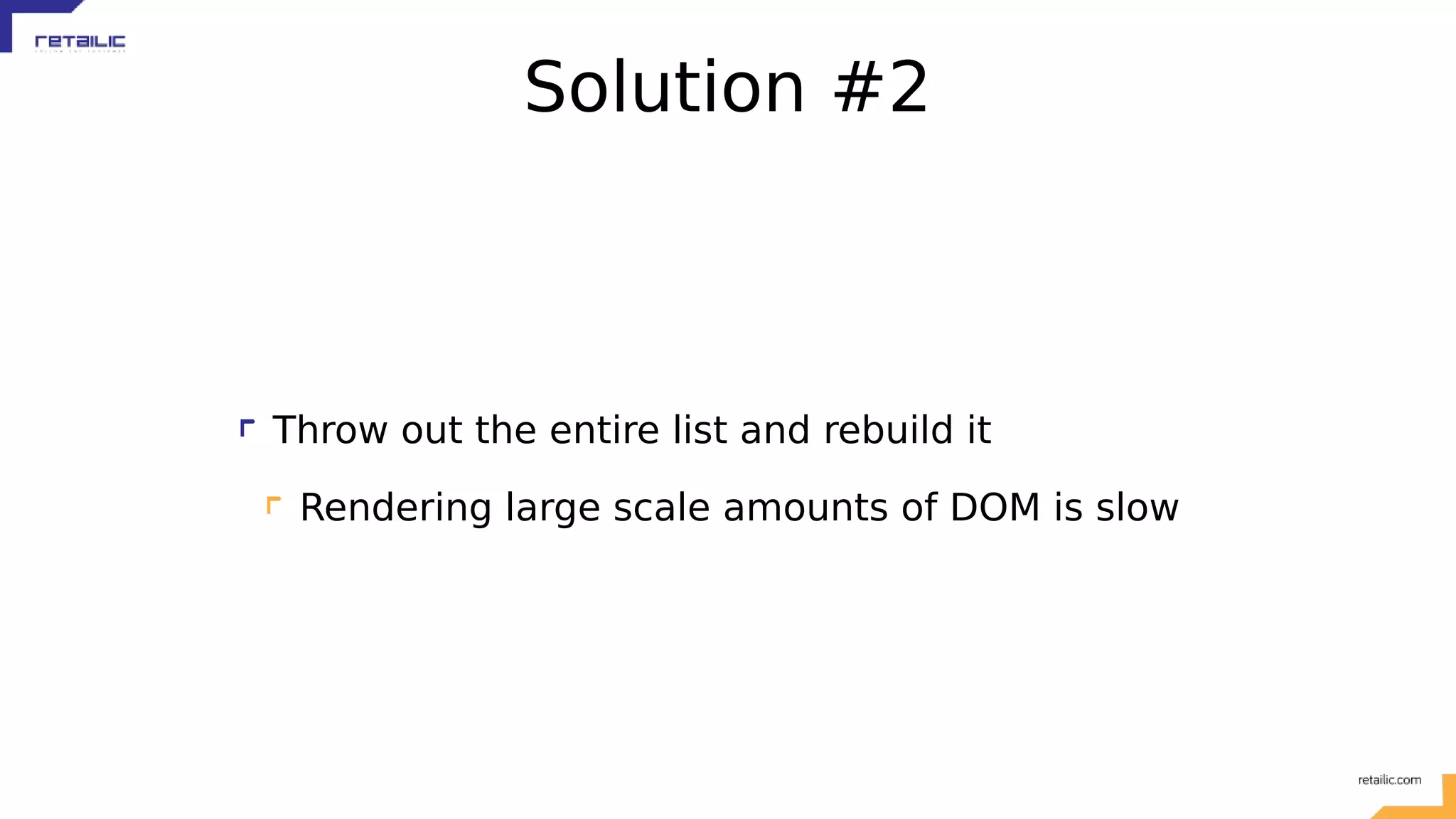
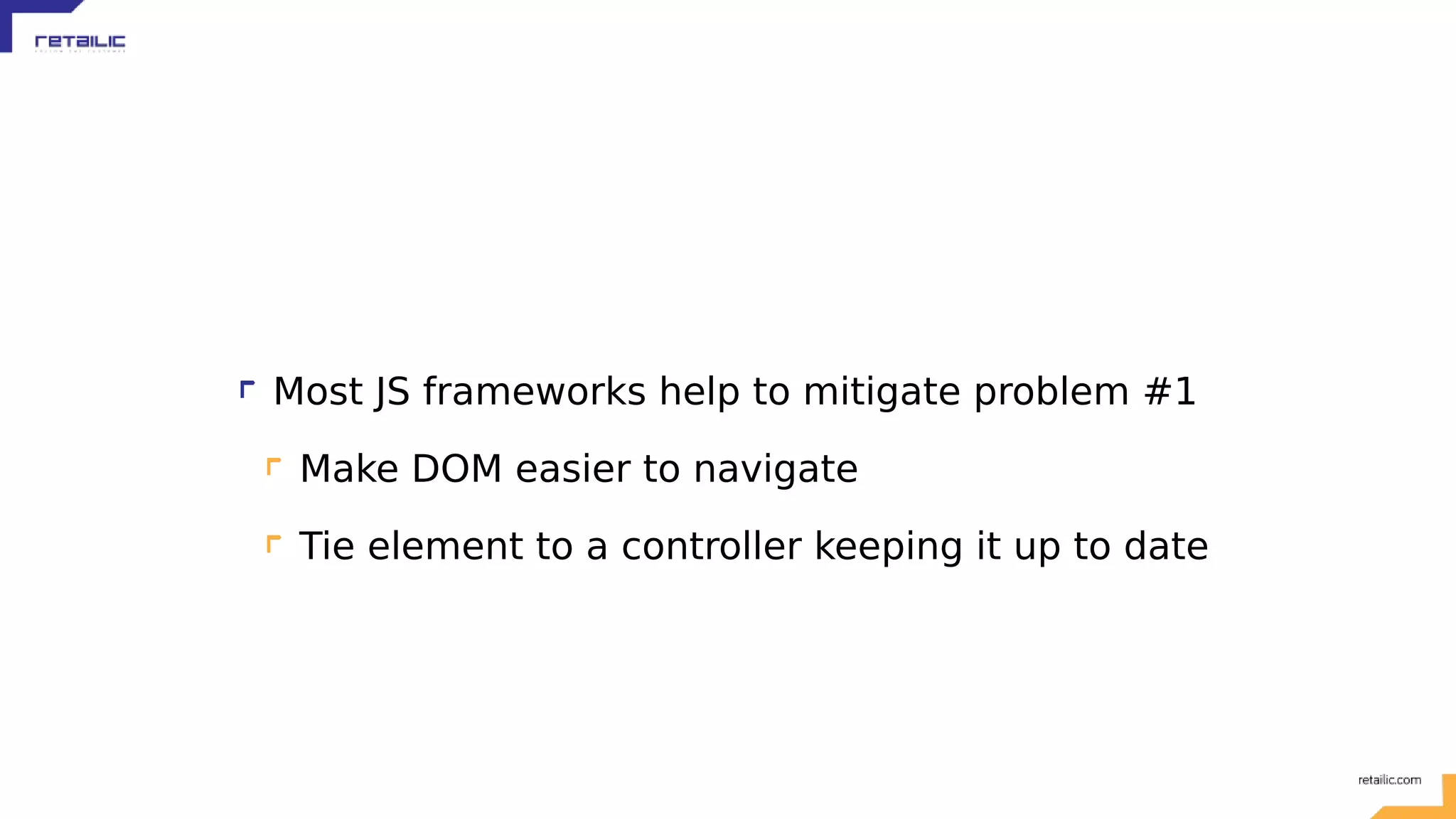
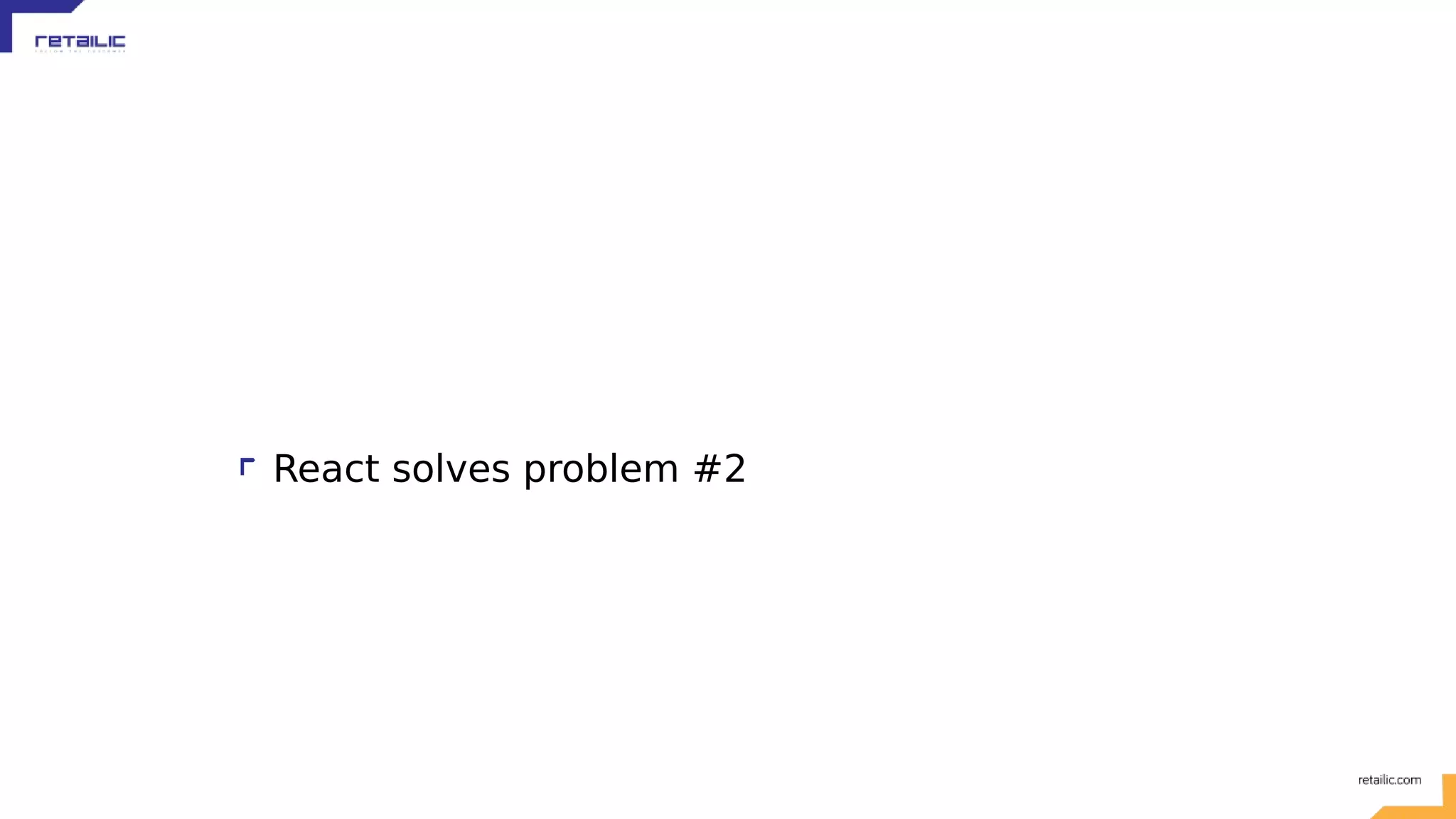
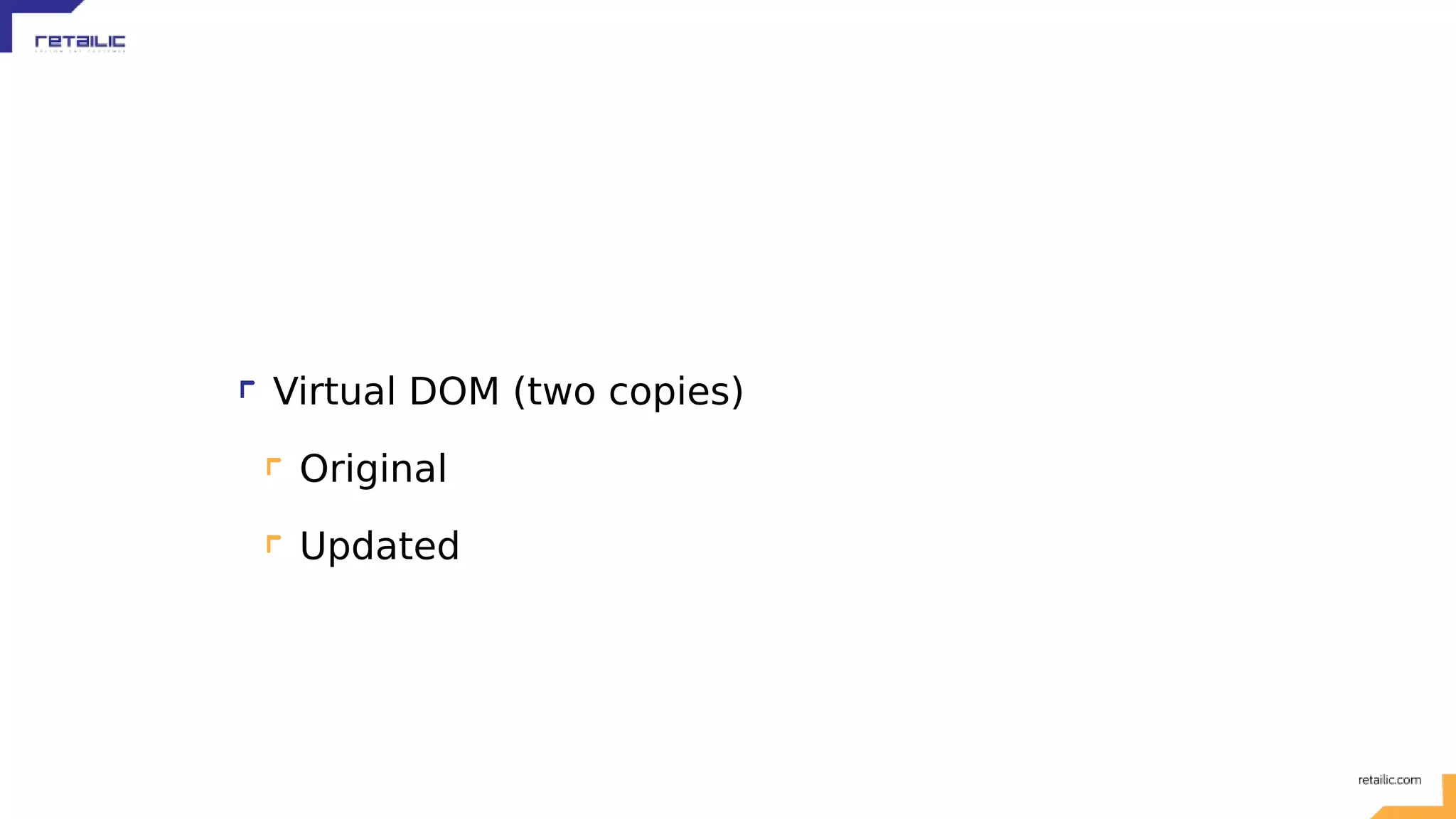
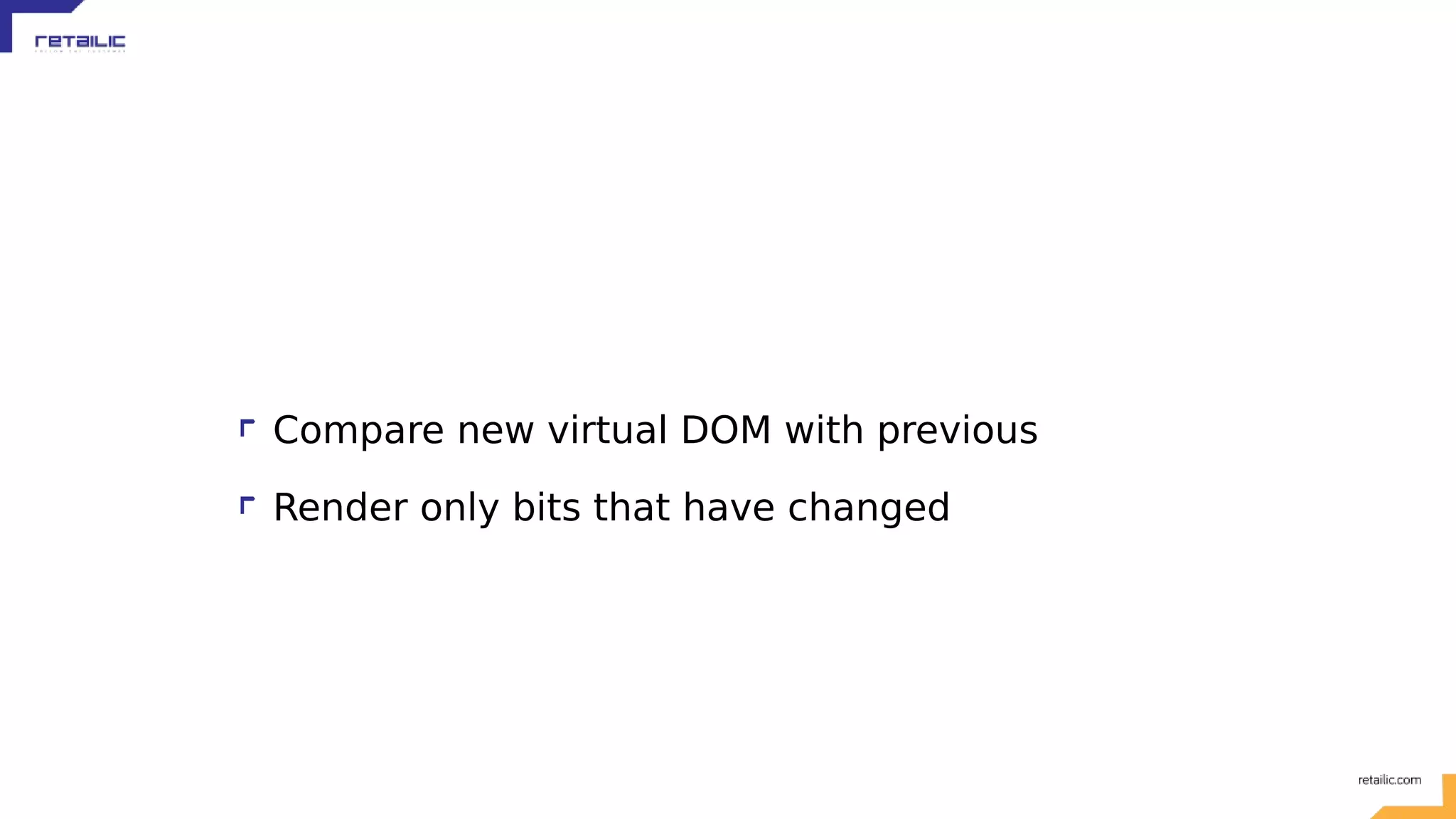
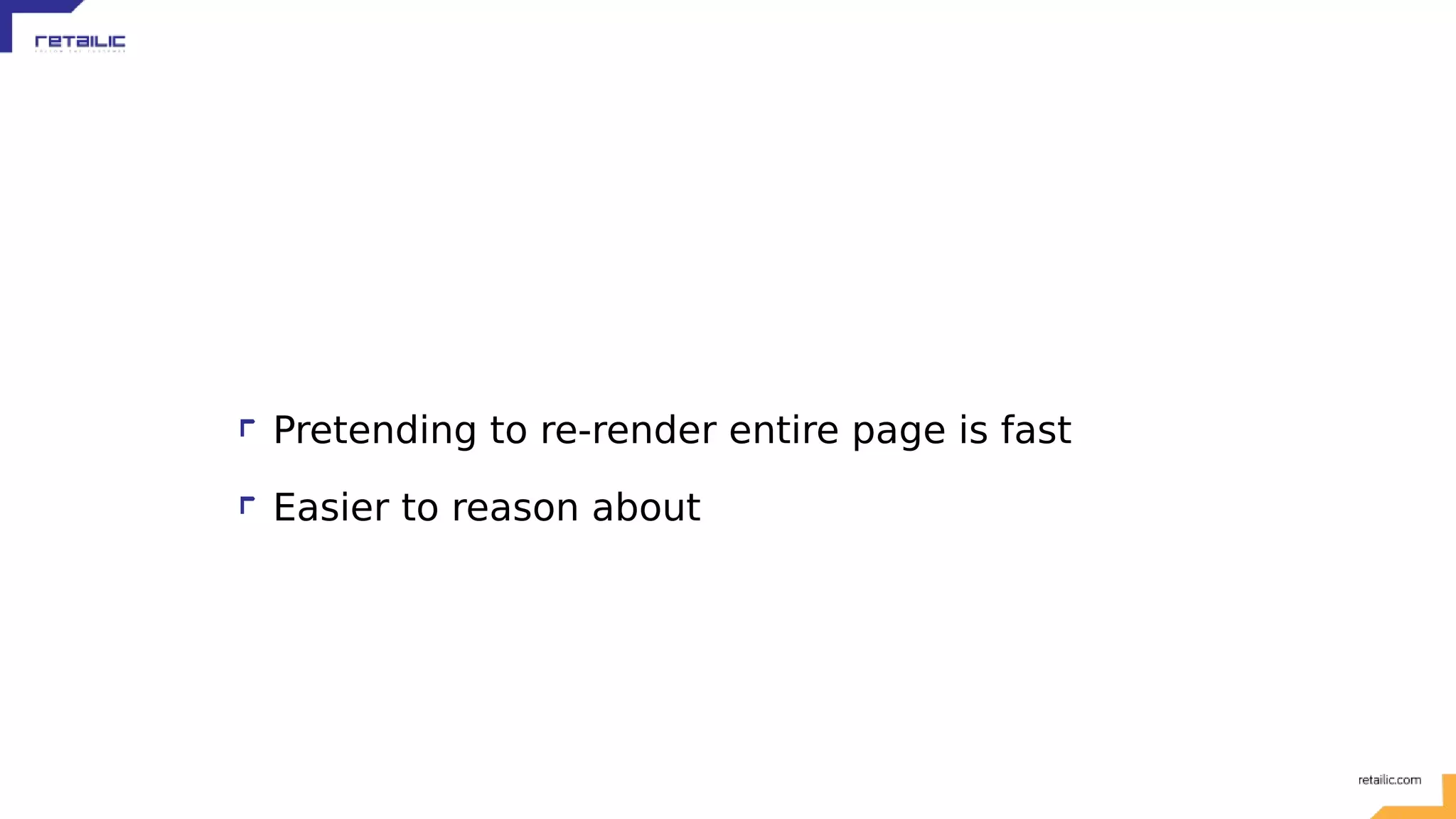
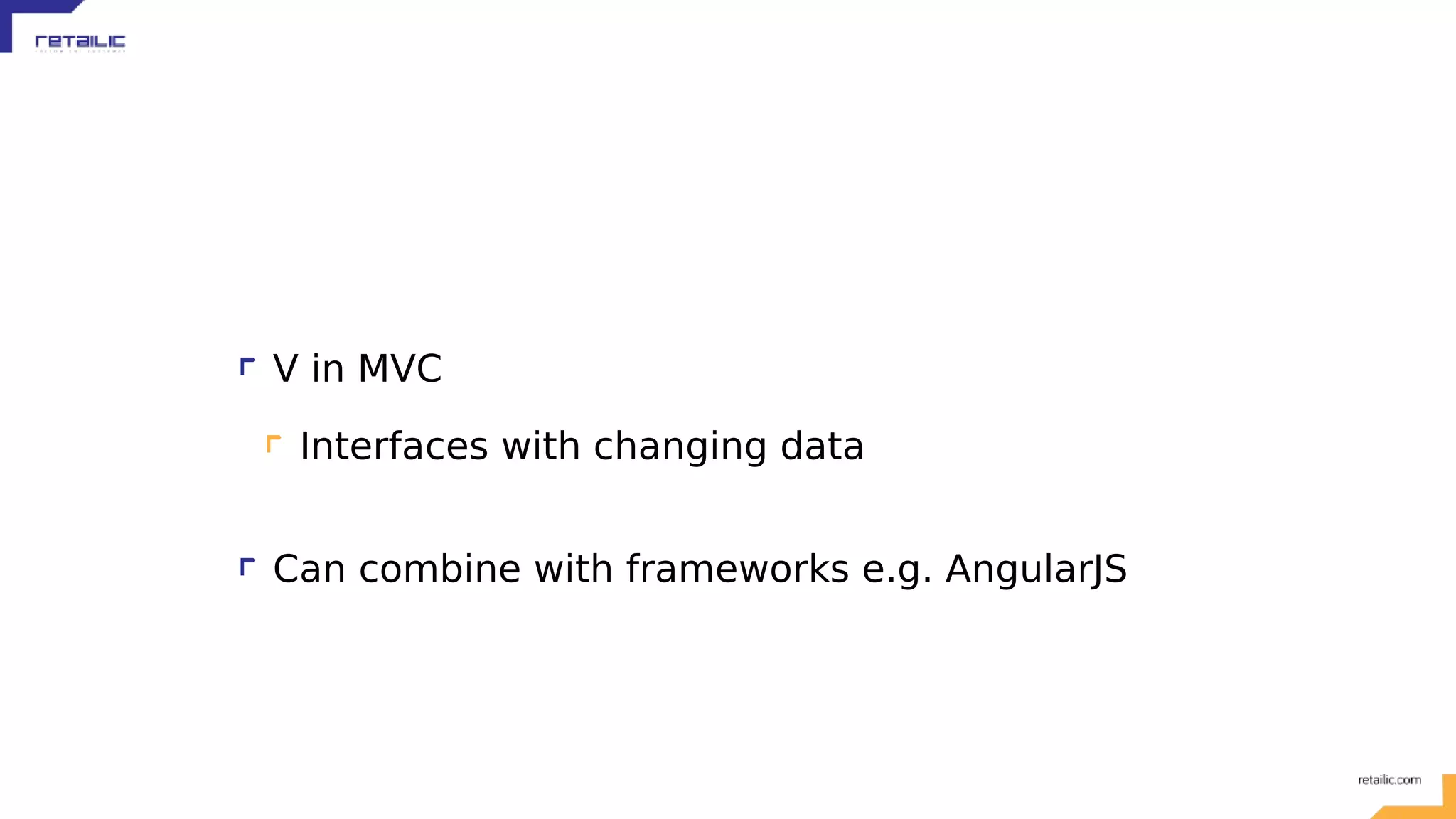
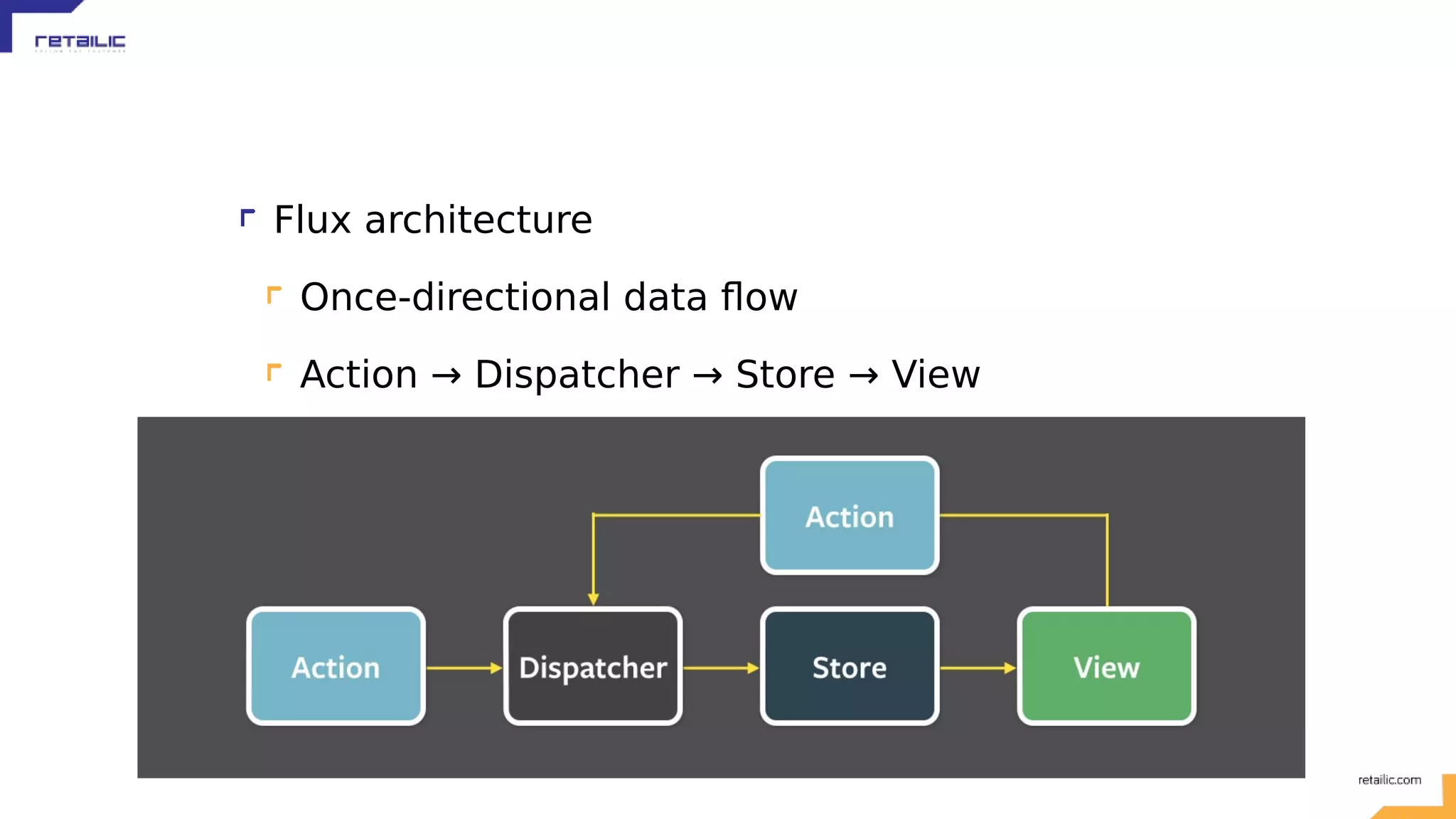
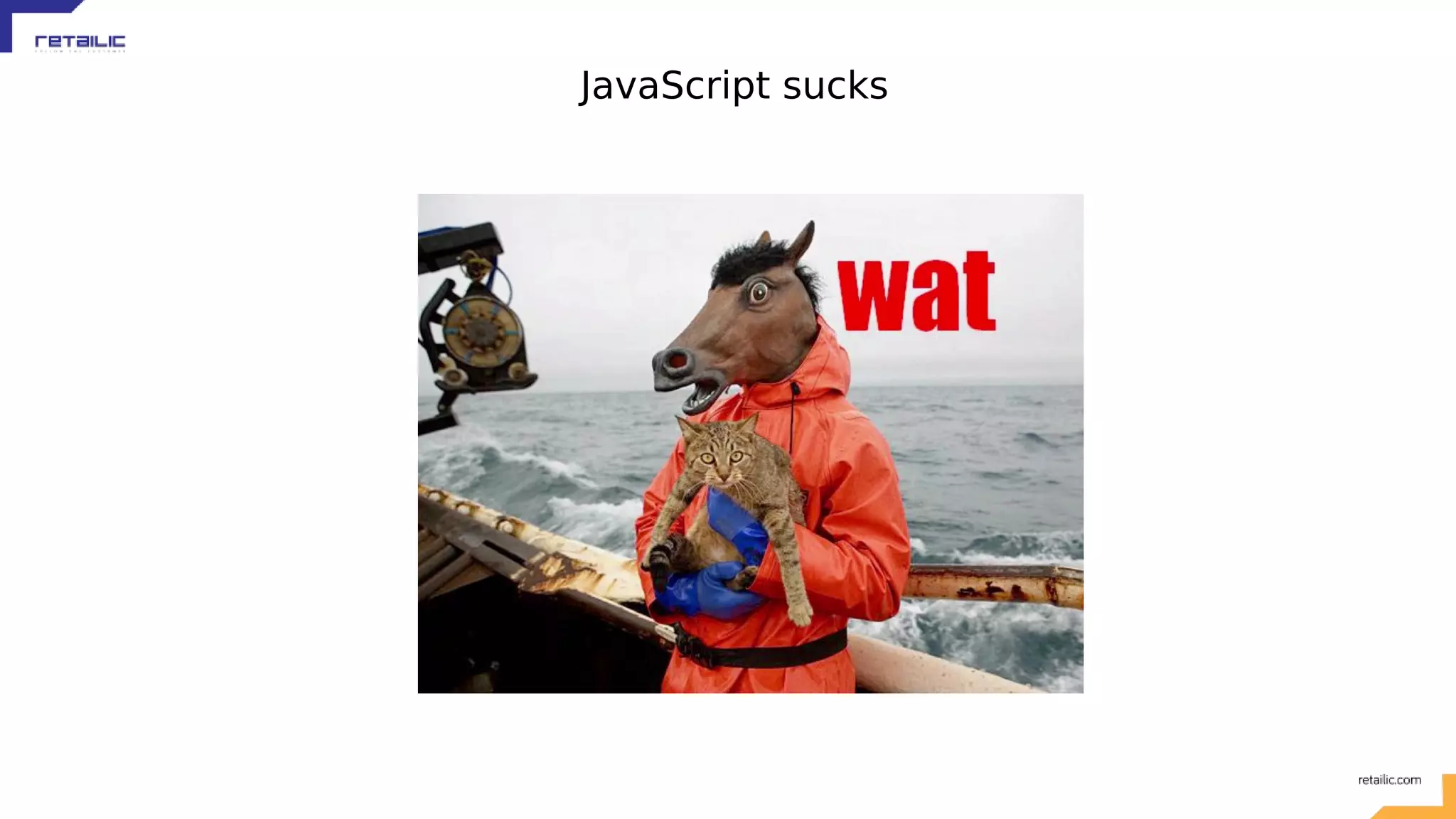
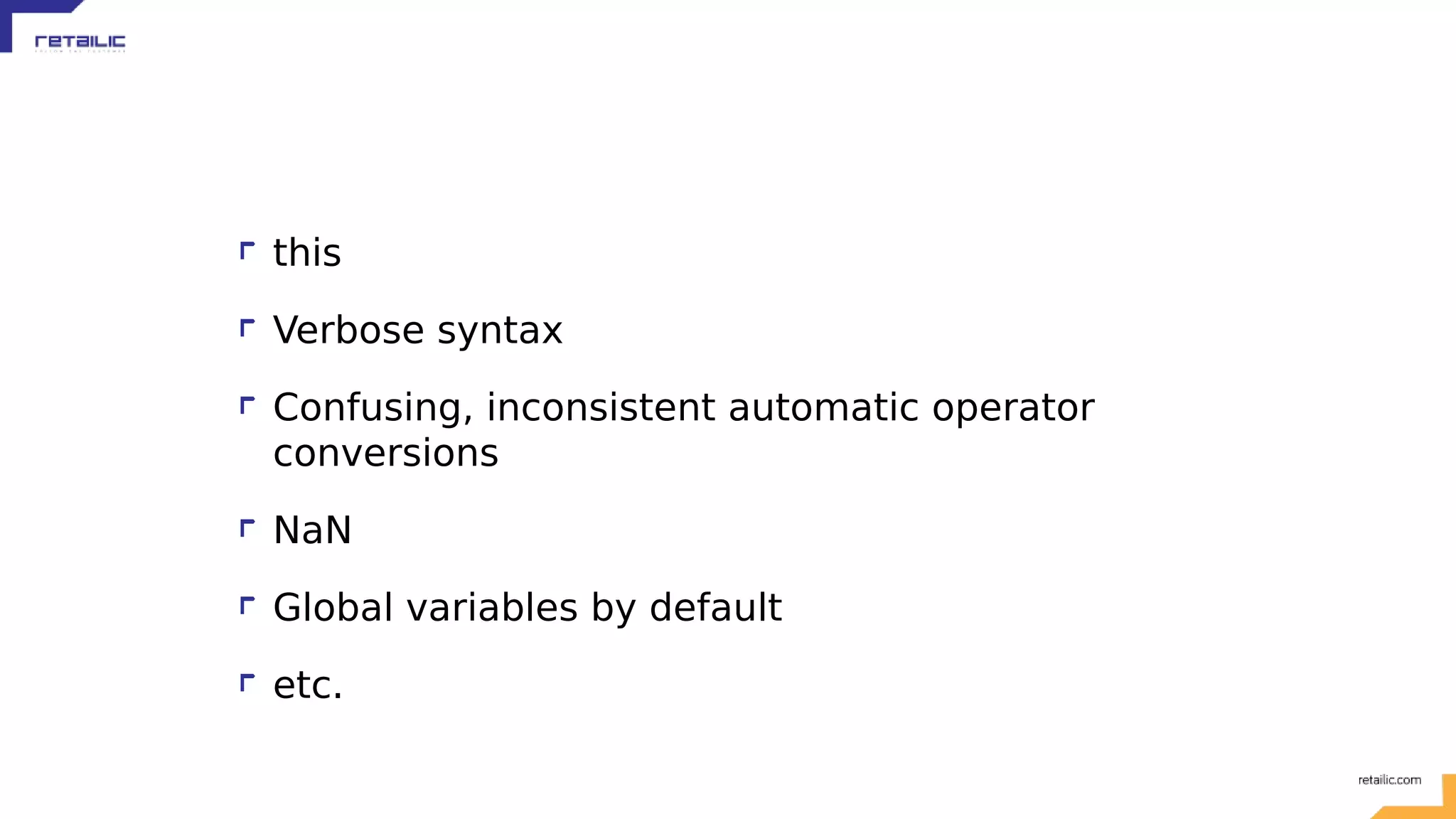
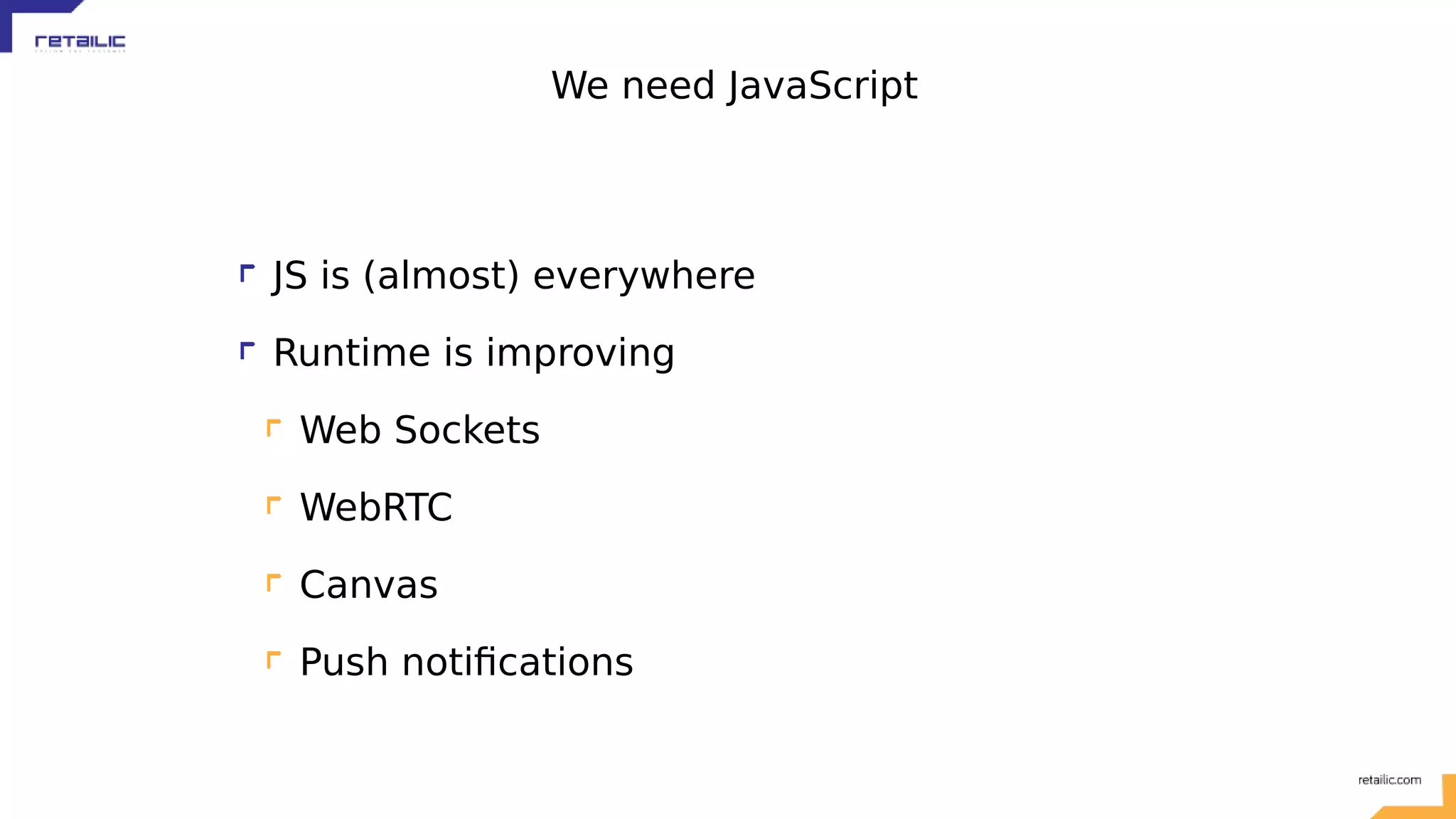
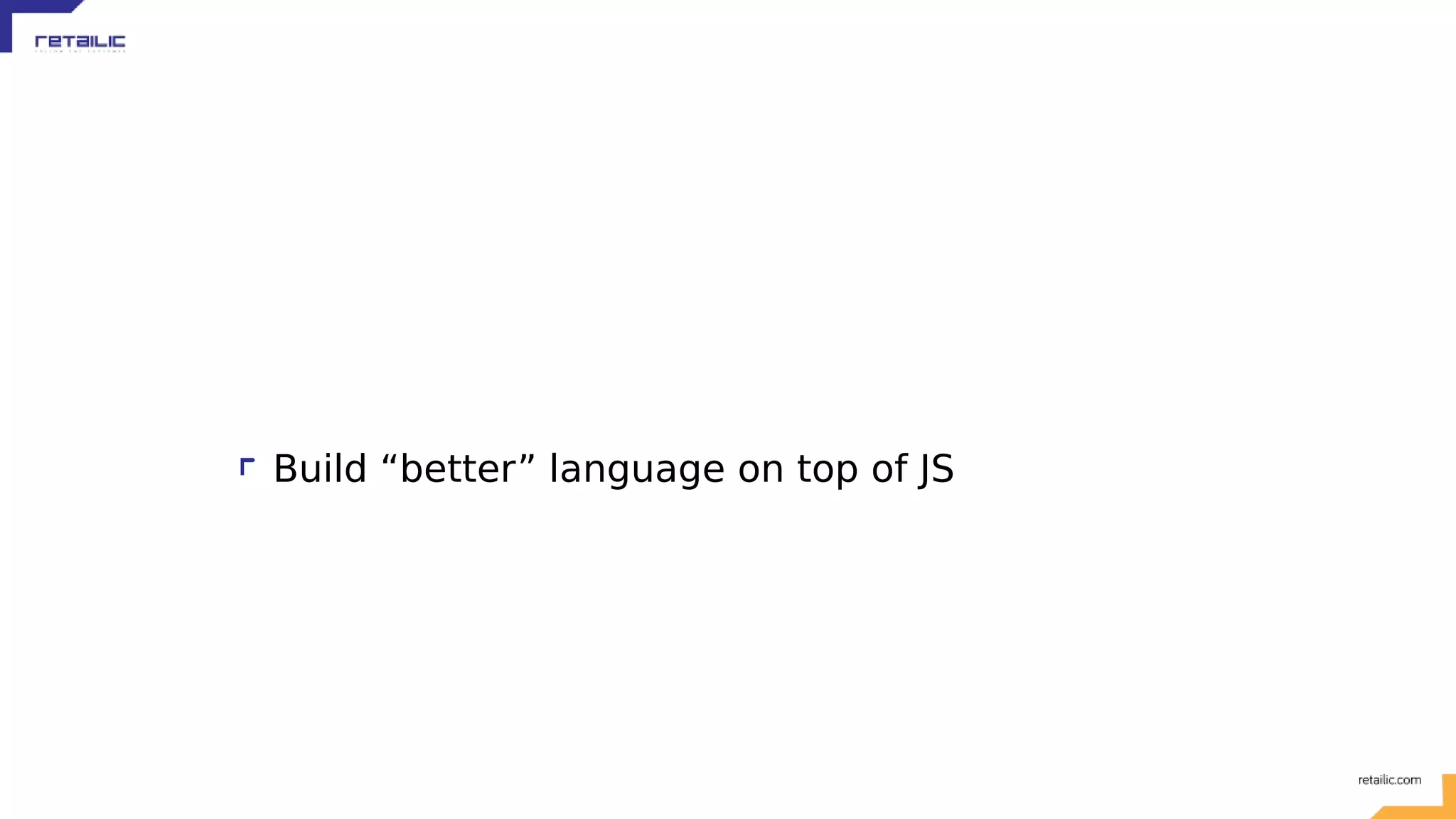
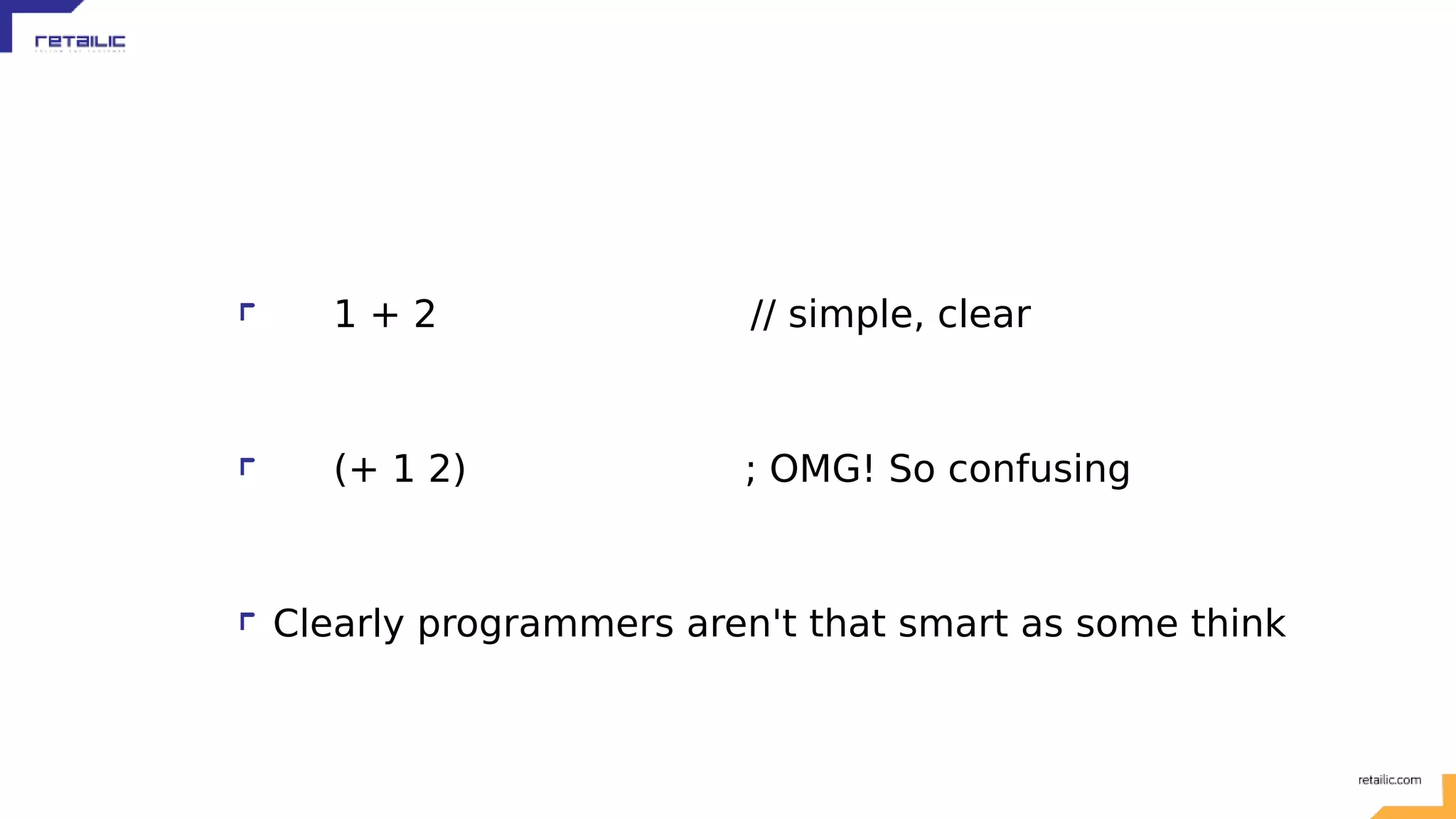
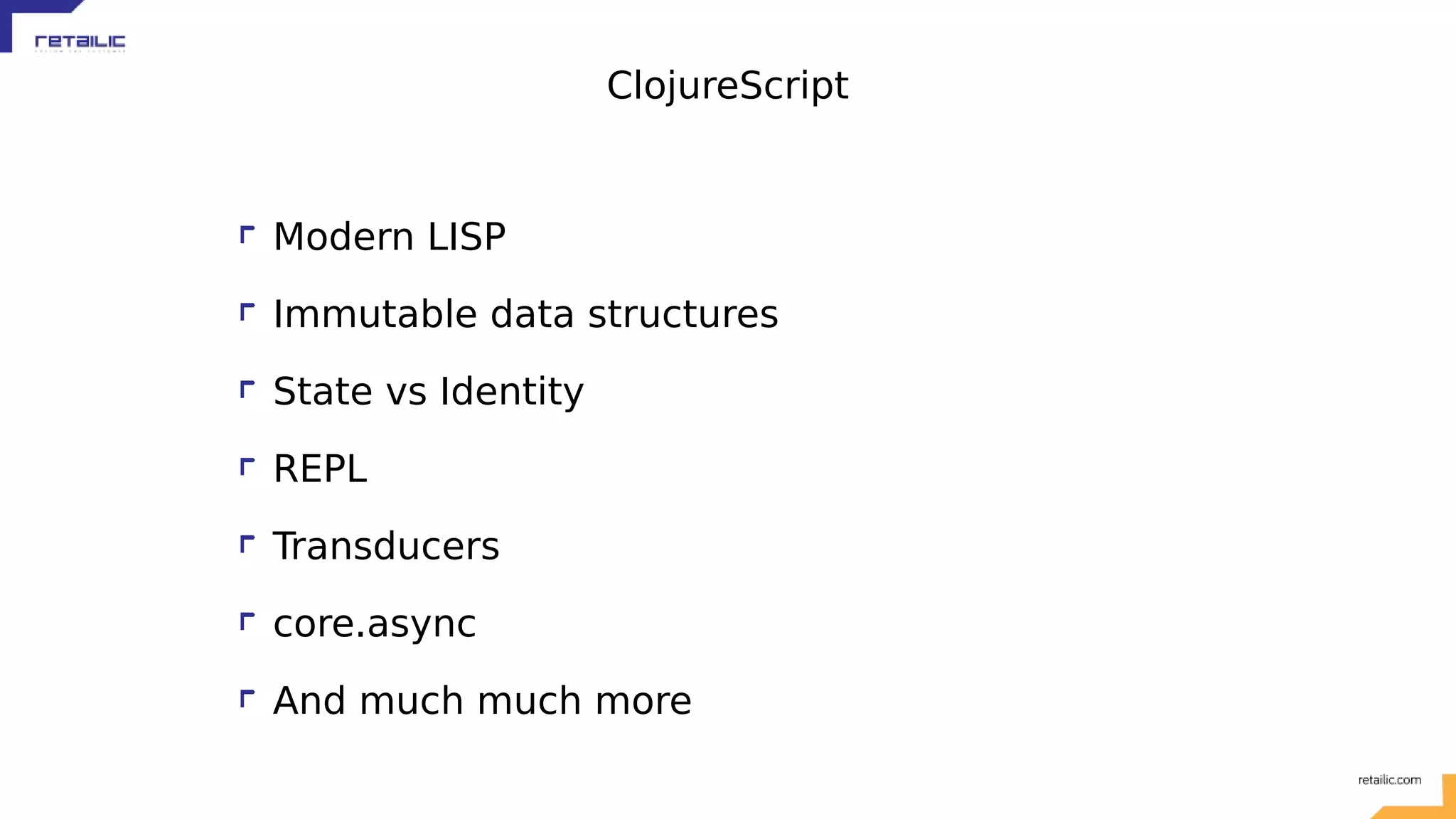
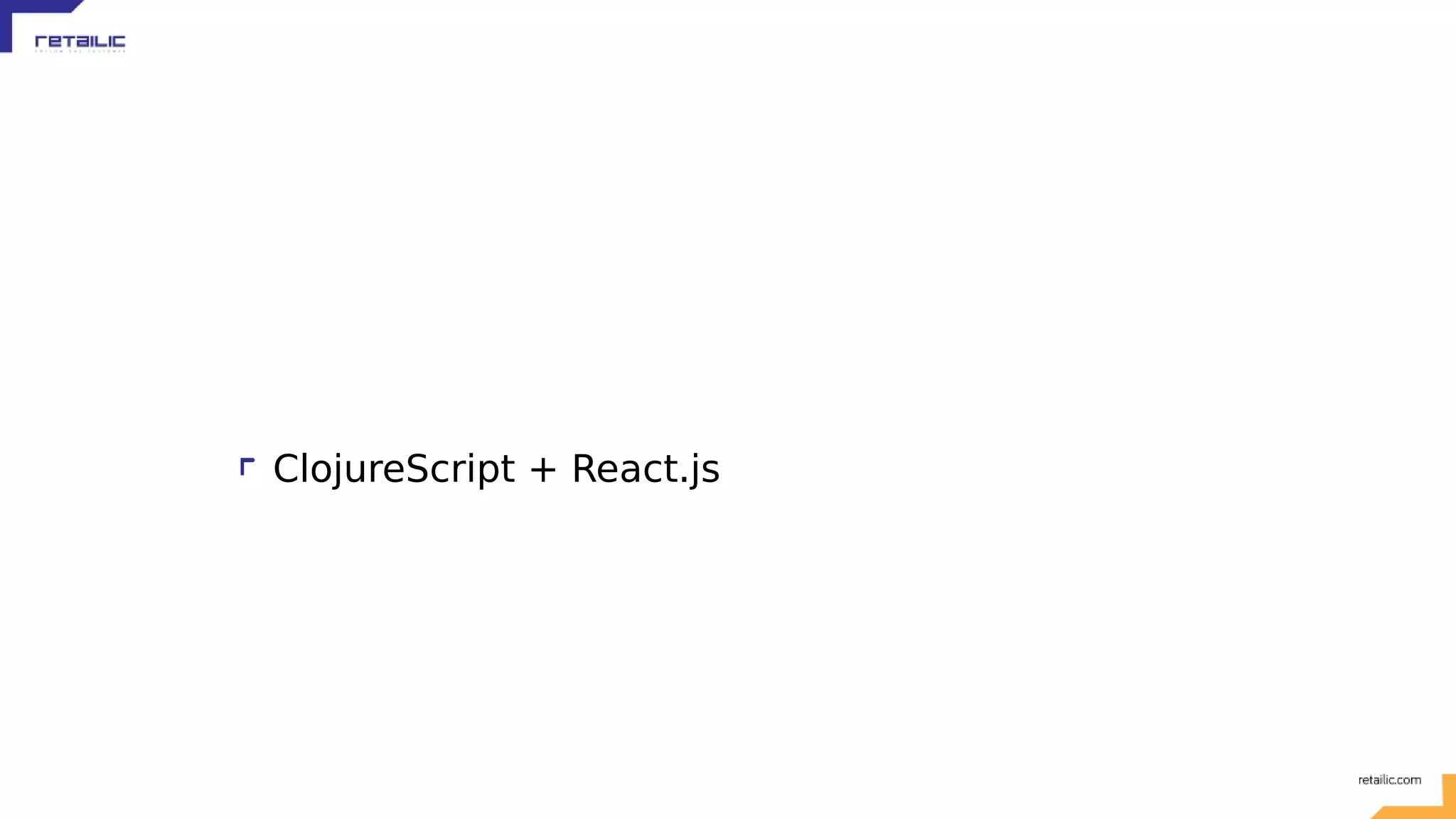
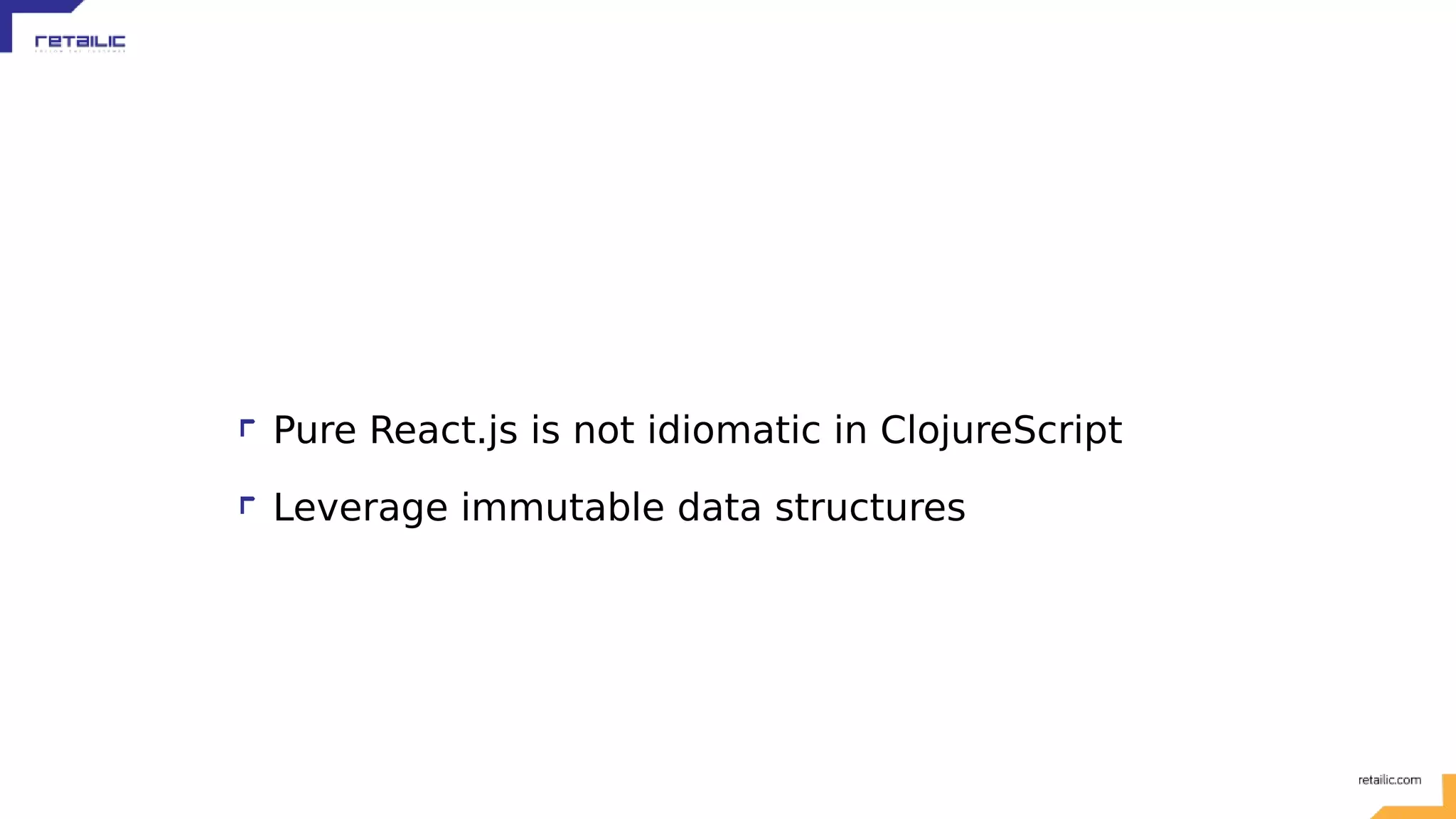
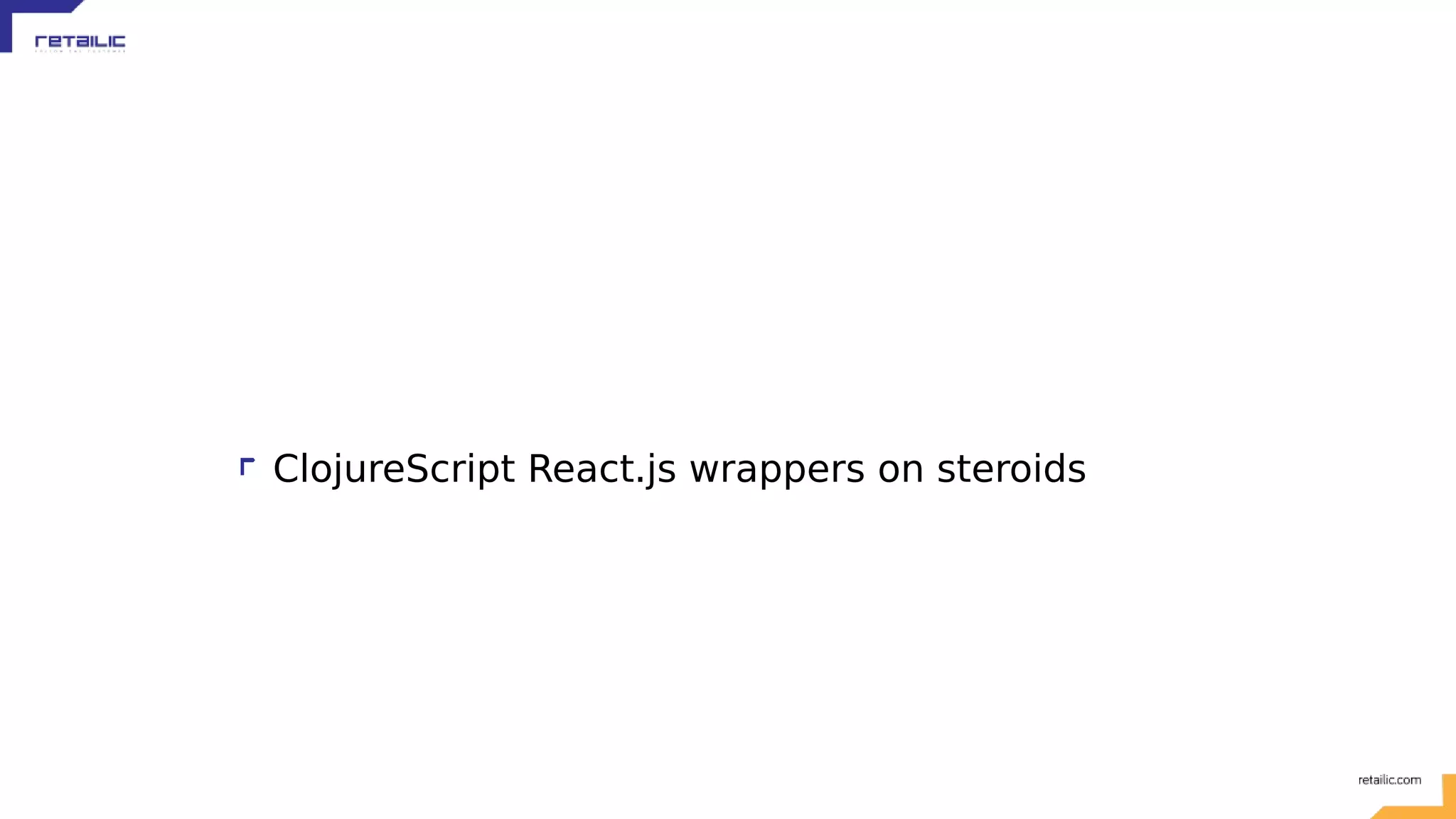
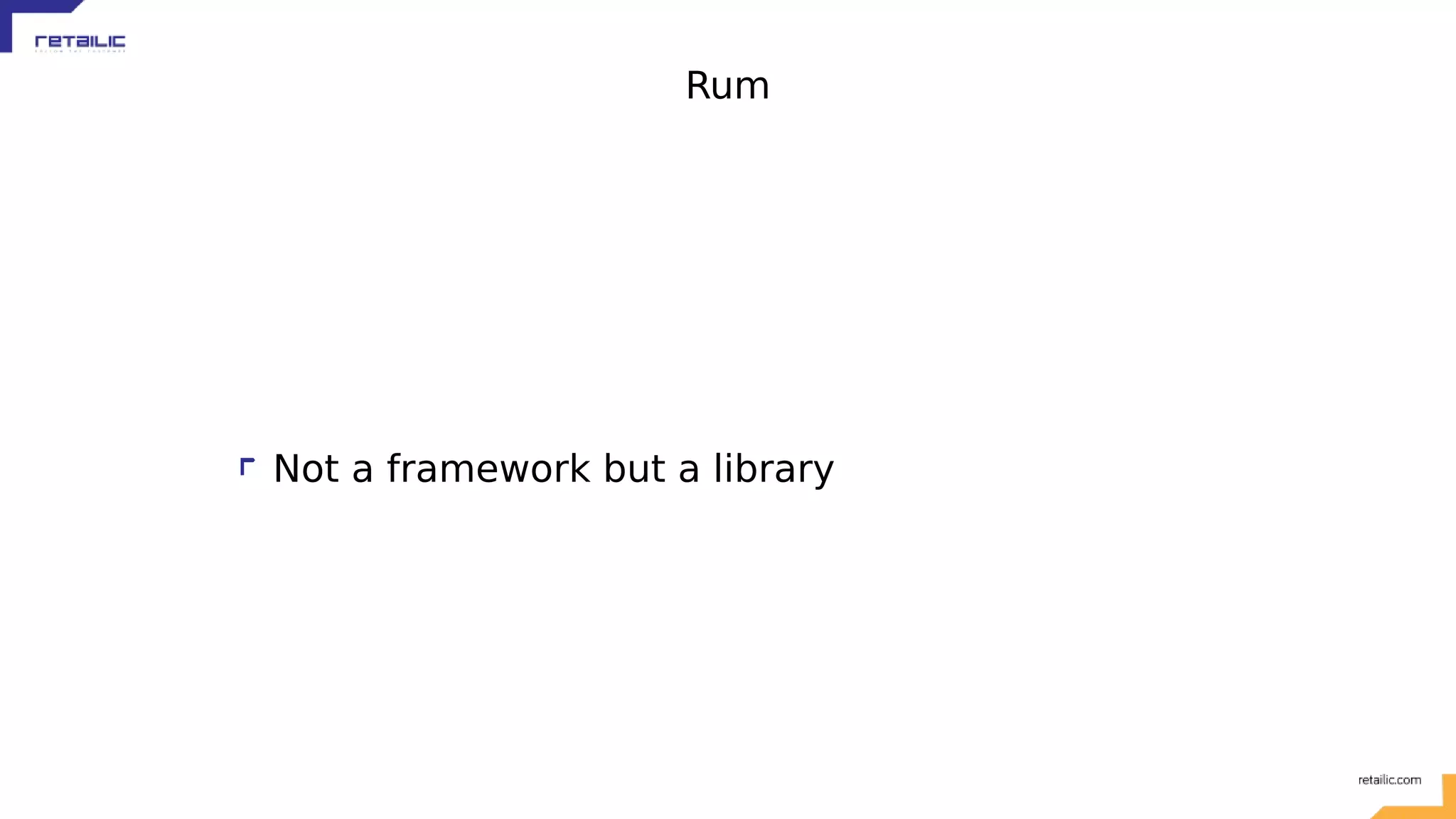
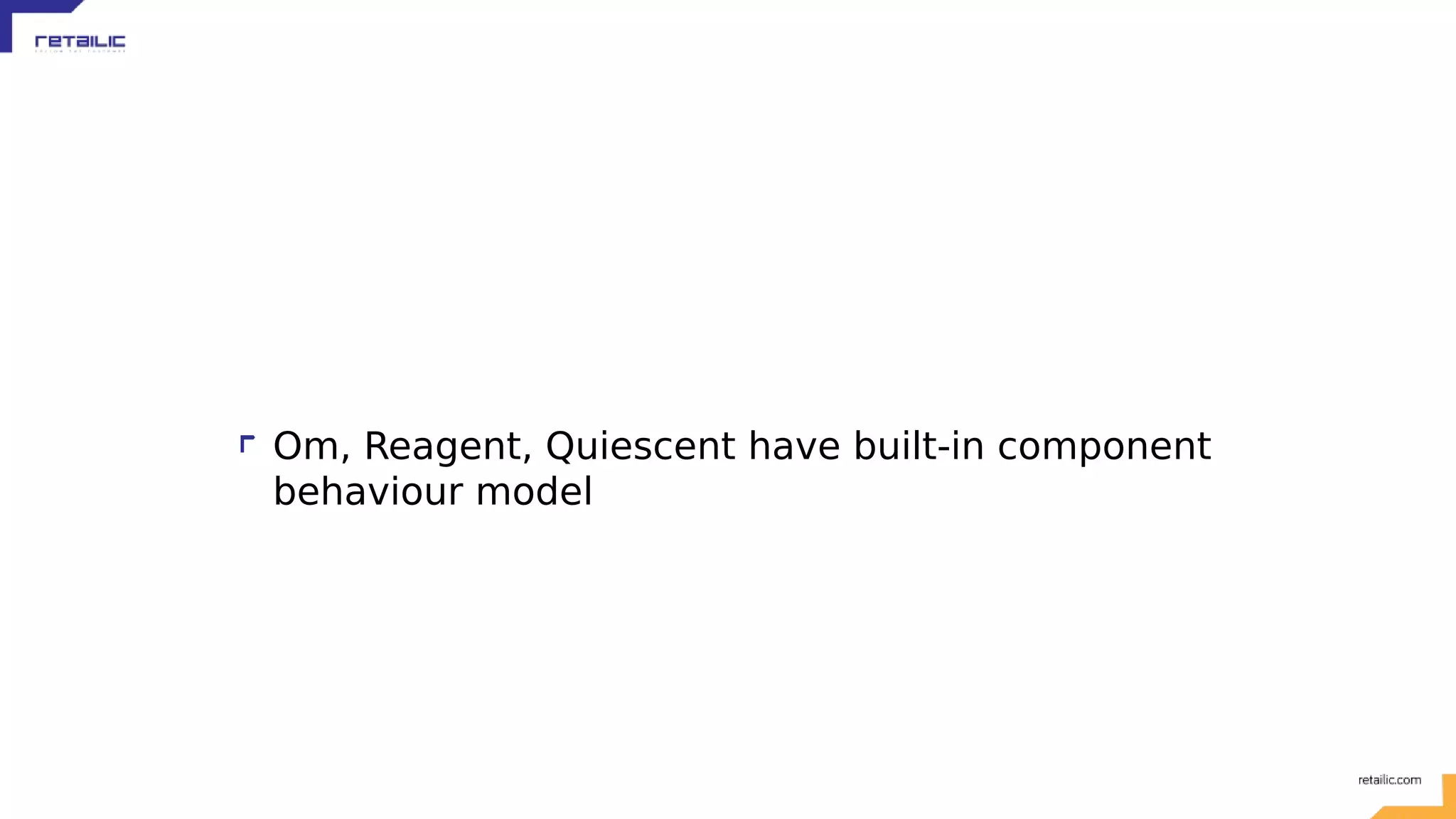
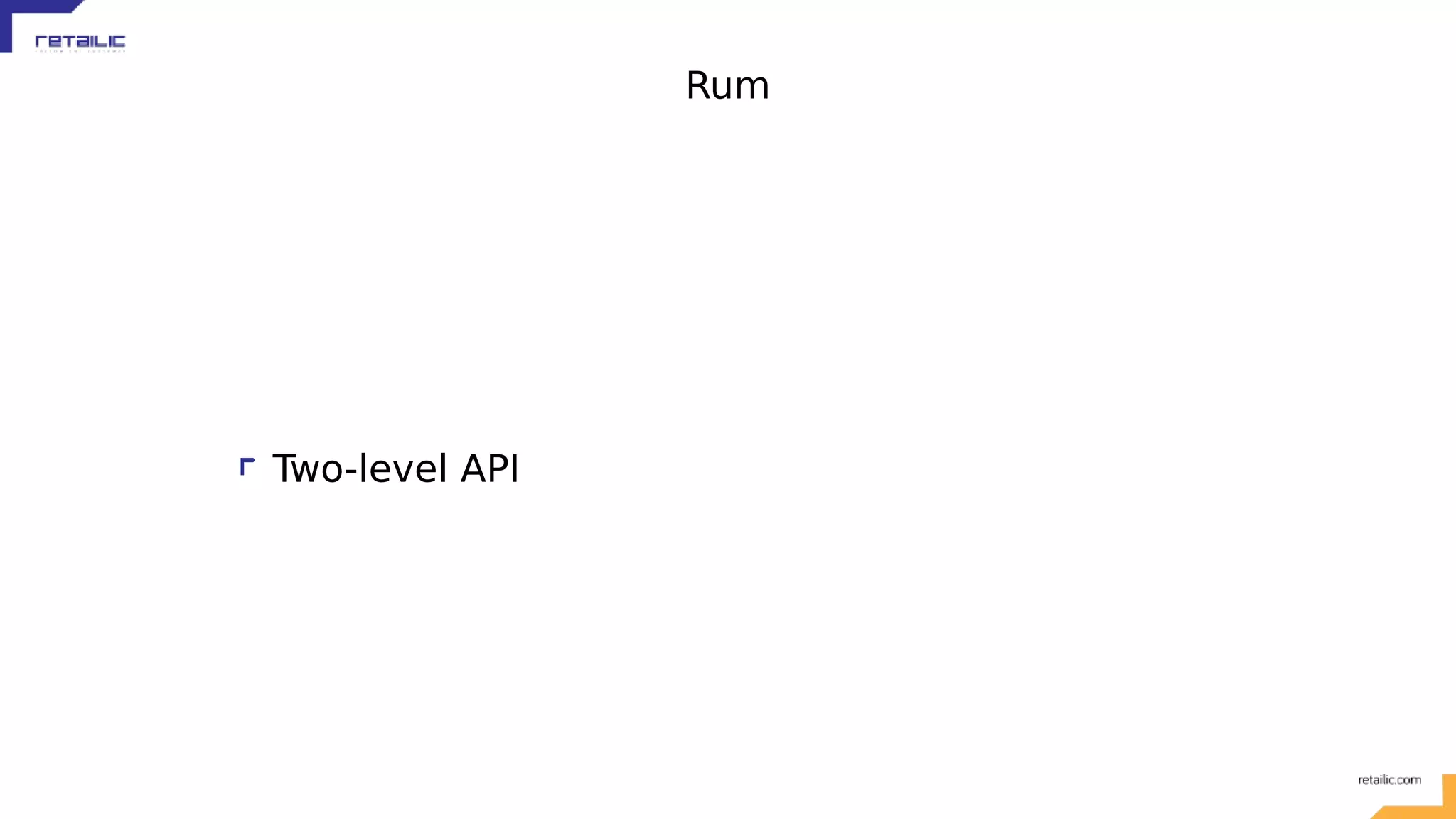
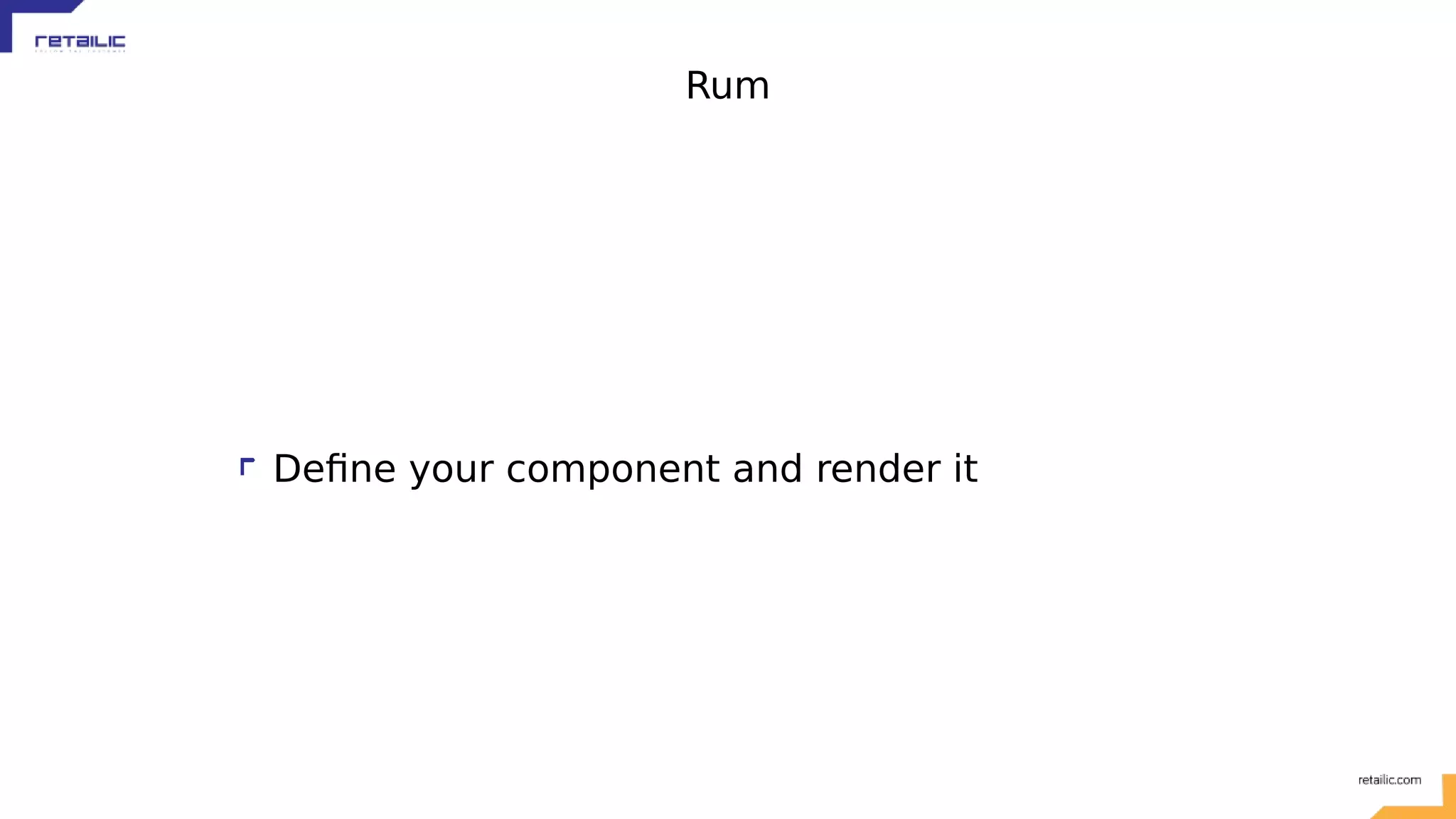
![(rum/defc name doc-string? [params*] render- body+)](https://image.slidesharecdn.com/reactiveprogramminginclojurescriptusingreactjswrappers-160221140934/75/Reactive-programming-in-clojure-script-using-reactjs-wrappers-33-2048.jpg)
![(rum/defc h1 [text] [:h1 text]) (rum/mount (h1 "important") js/document.body)](https://image.slidesharecdn.com/reactiveprogramminginclojurescriptusingreactjswrappers-160221140934/75/Reactive-programming-in-clojure-script-using-reactjs-wrappers-34-2048.jpg)
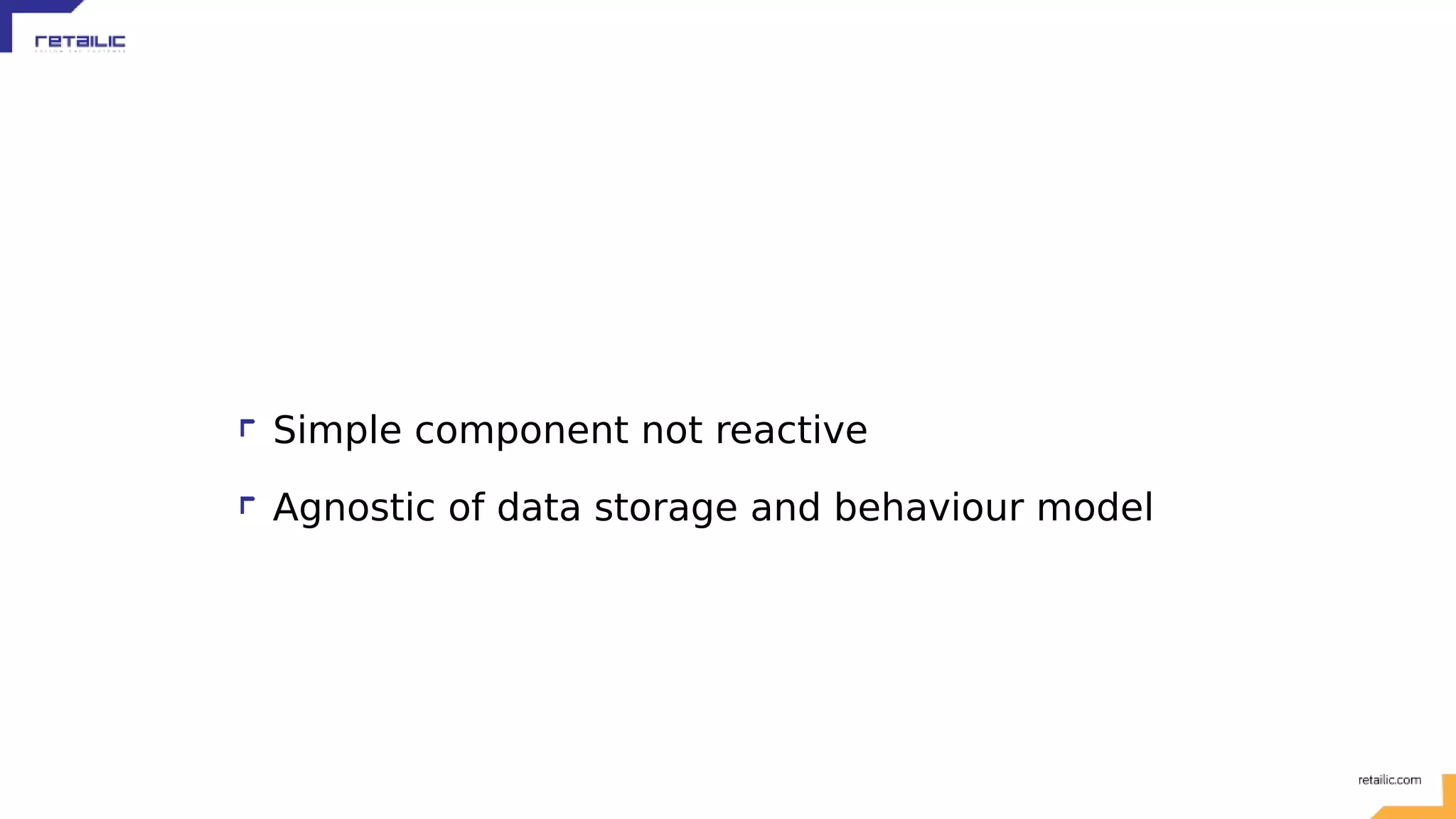
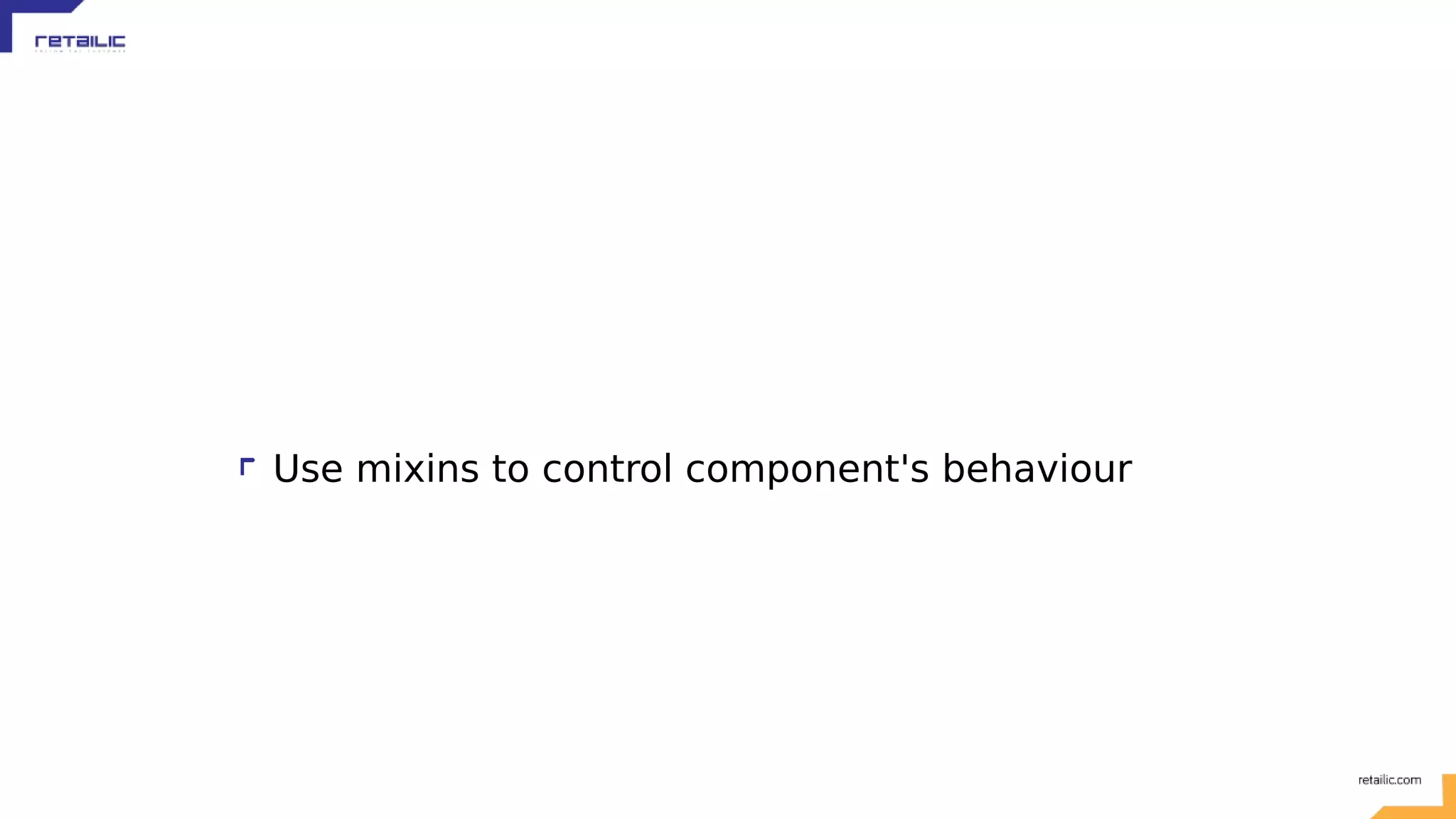
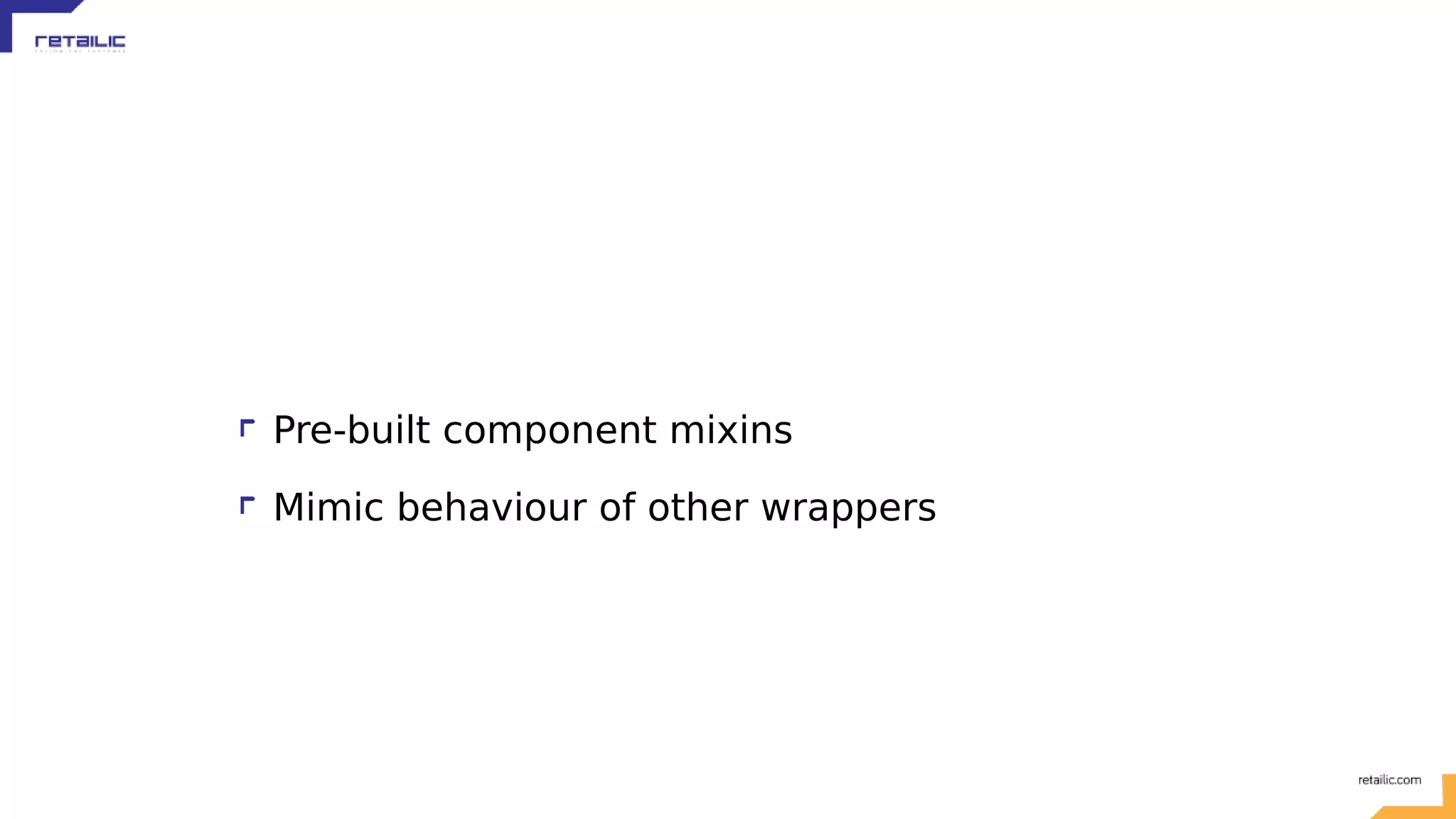
![(rum/defc name doc-string? [< mixins+]? [params*] render-body+)](https://image.slidesharecdn.com/reactiveprogramminginclojurescriptusingreactjswrappers-160221140934/75/Reactive-programming-in-clojure-script-using-reactjs-wrappers-38-2048.jpg)
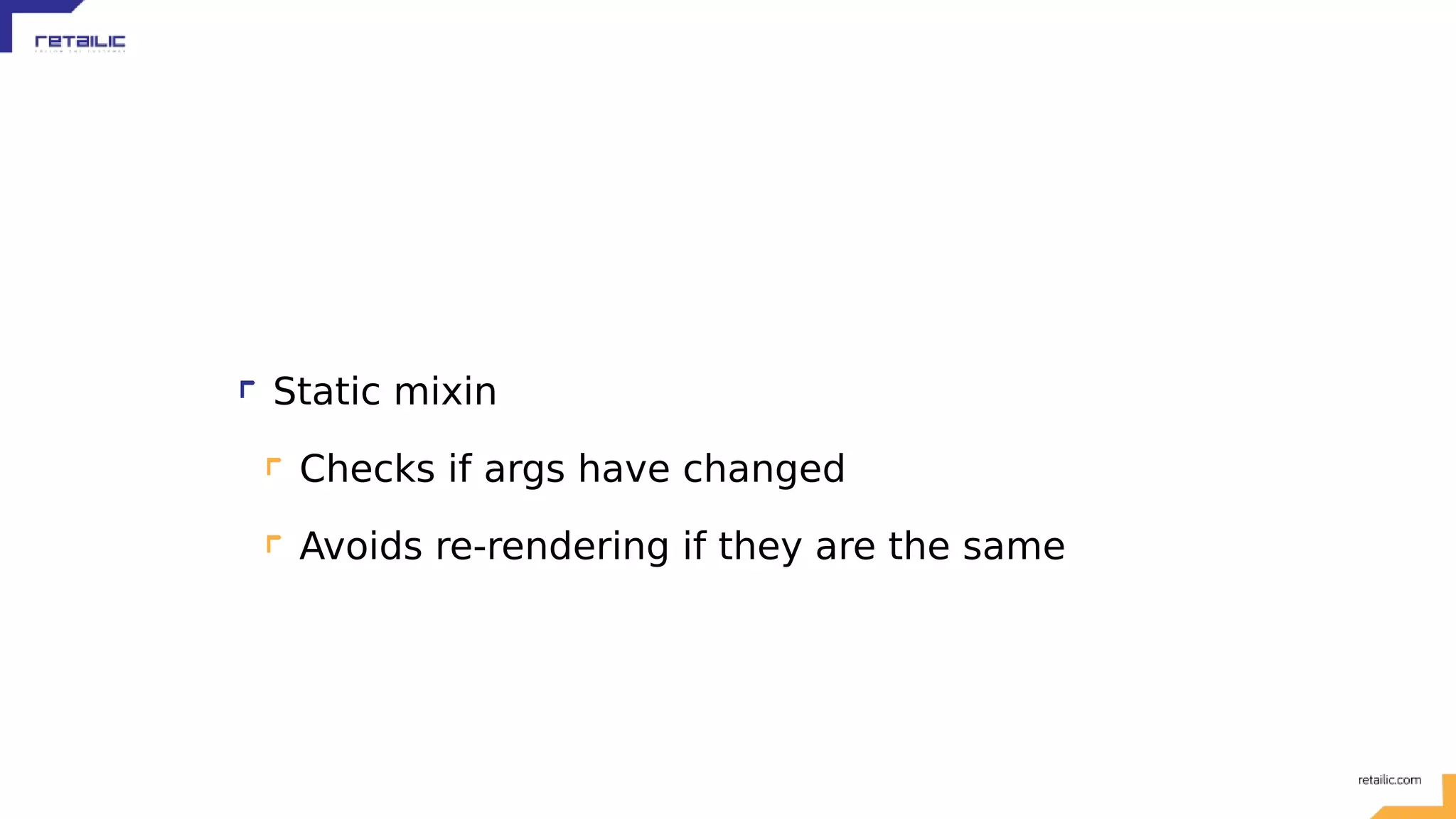
![(rum/defc h1 < rum/static [text] [:h1 text])](https://image.slidesharecdn.com/reactiveprogramminginclojurescriptusingreactjswrappers-160221140934/75/Reactive-programming-in-clojure-script-using-reactjs-wrappers-40-2048.jpg)
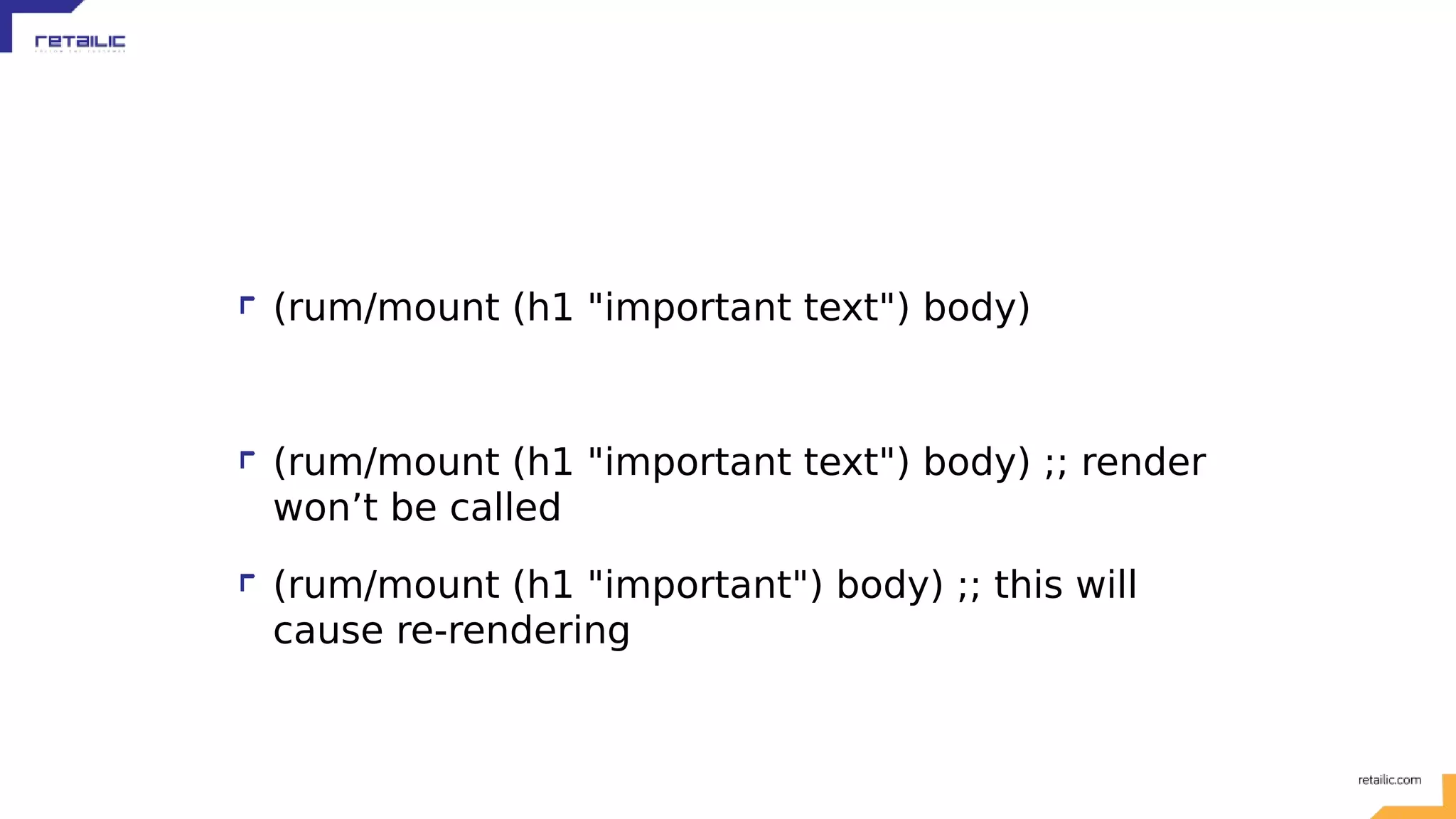
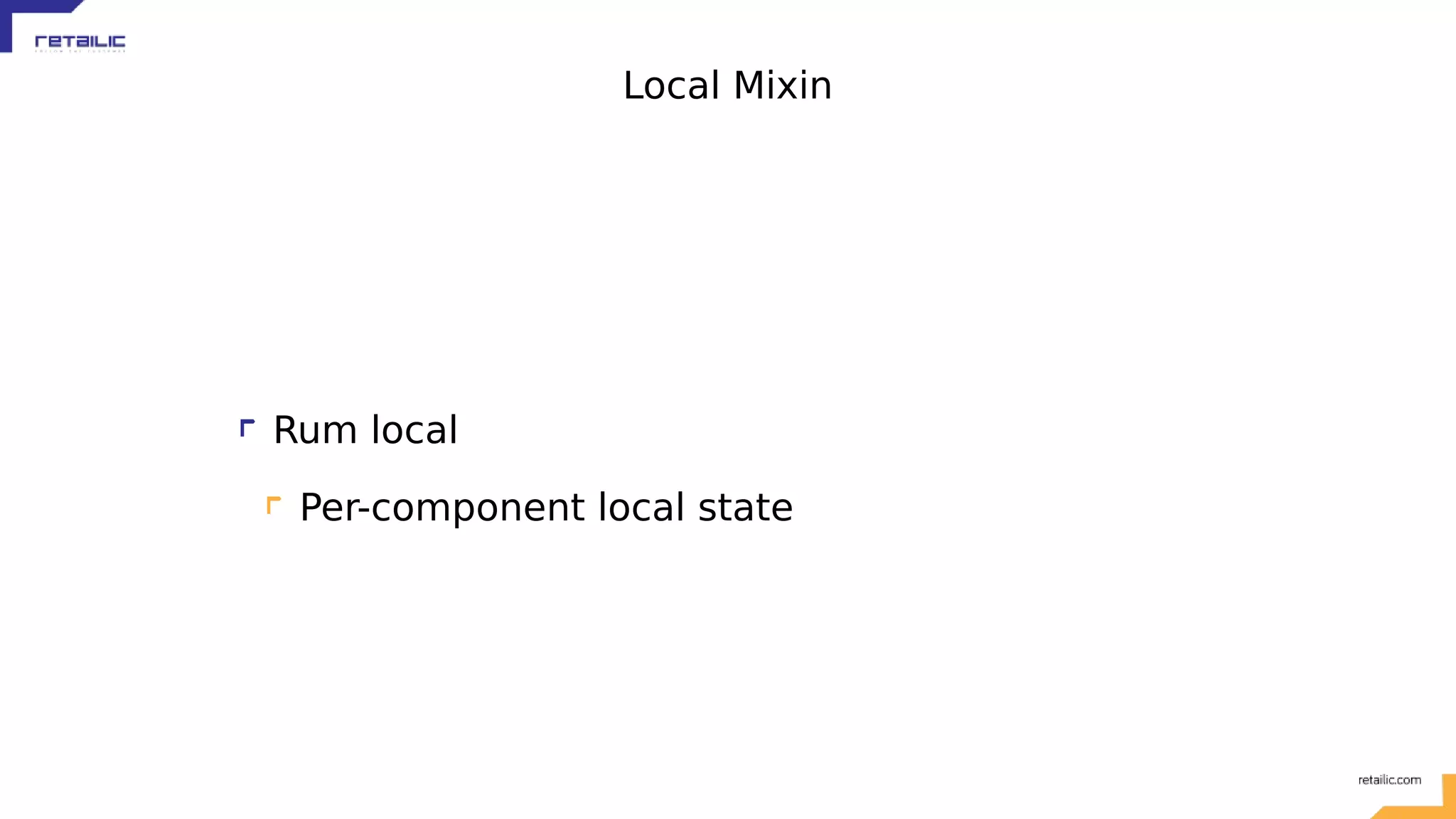
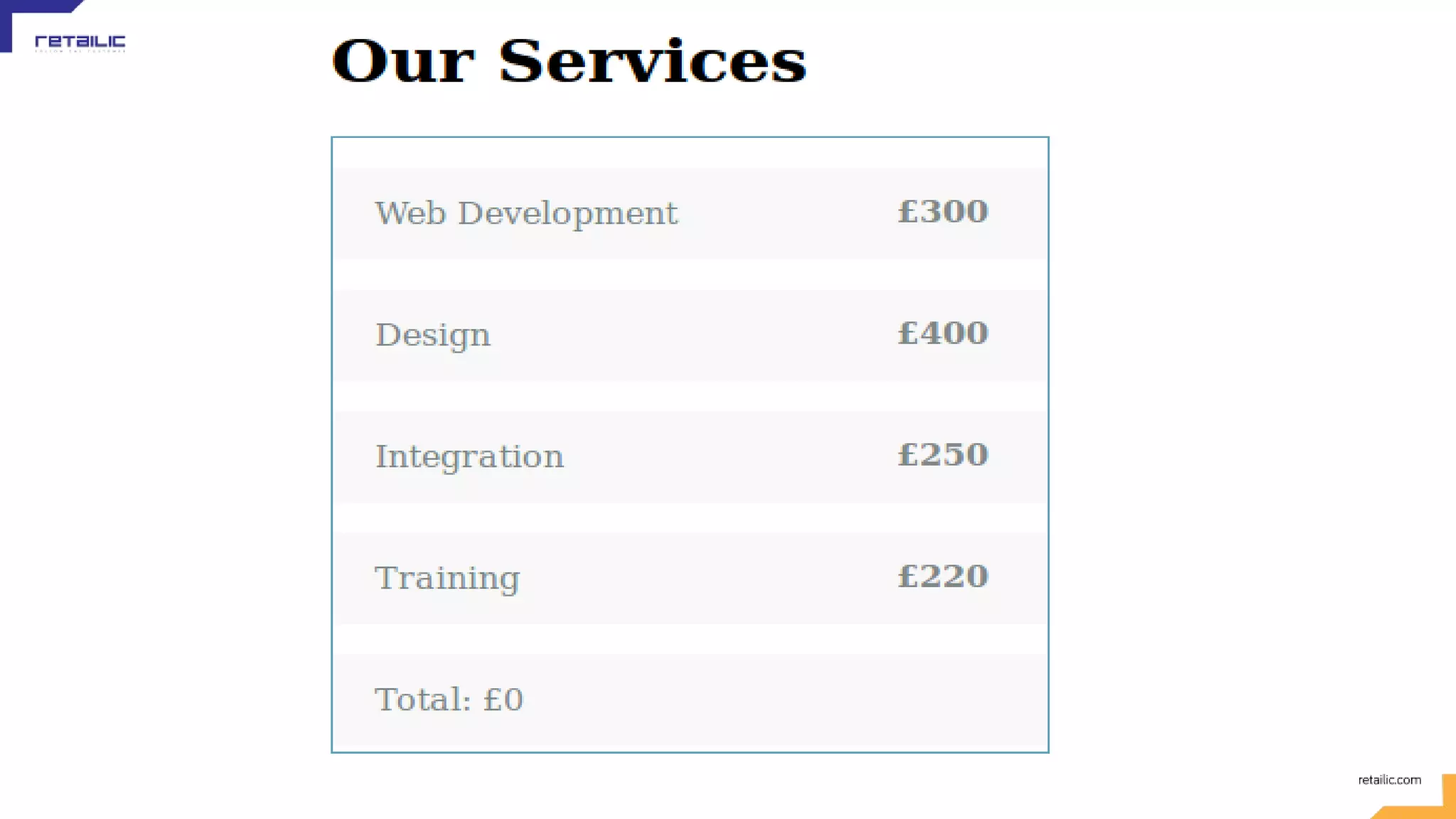


![(rum/defcs make-service < (rum/local "") [state service] (let [local (:rum/local state)] [:p {:class @local :on-click (fn [_] (swap! local toggle-class service))} (:name service) [:b (str " £" (:price service))]]))](https://image.slidesharecdn.com/reactiveprogramminginclojurescriptusingreactjswrappers-160221140934/75/Reactive-programming-in-clojure-script-using-reactjs-wrappers-46-2048.jpg)
![(defn toggle-class [current-class service] (let [price (:price service)] (if (= current-class "active") (do (swap! order-form-total - price) "") (do (swap! order-form-total + price) "active"))))](https://image.slidesharecdn.com/reactiveprogramminginclojurescriptusingreactjswrappers-160221140934/75/Reactive-programming-in-clojure-script-using-reactjs-wrappers-47-2048.jpg)
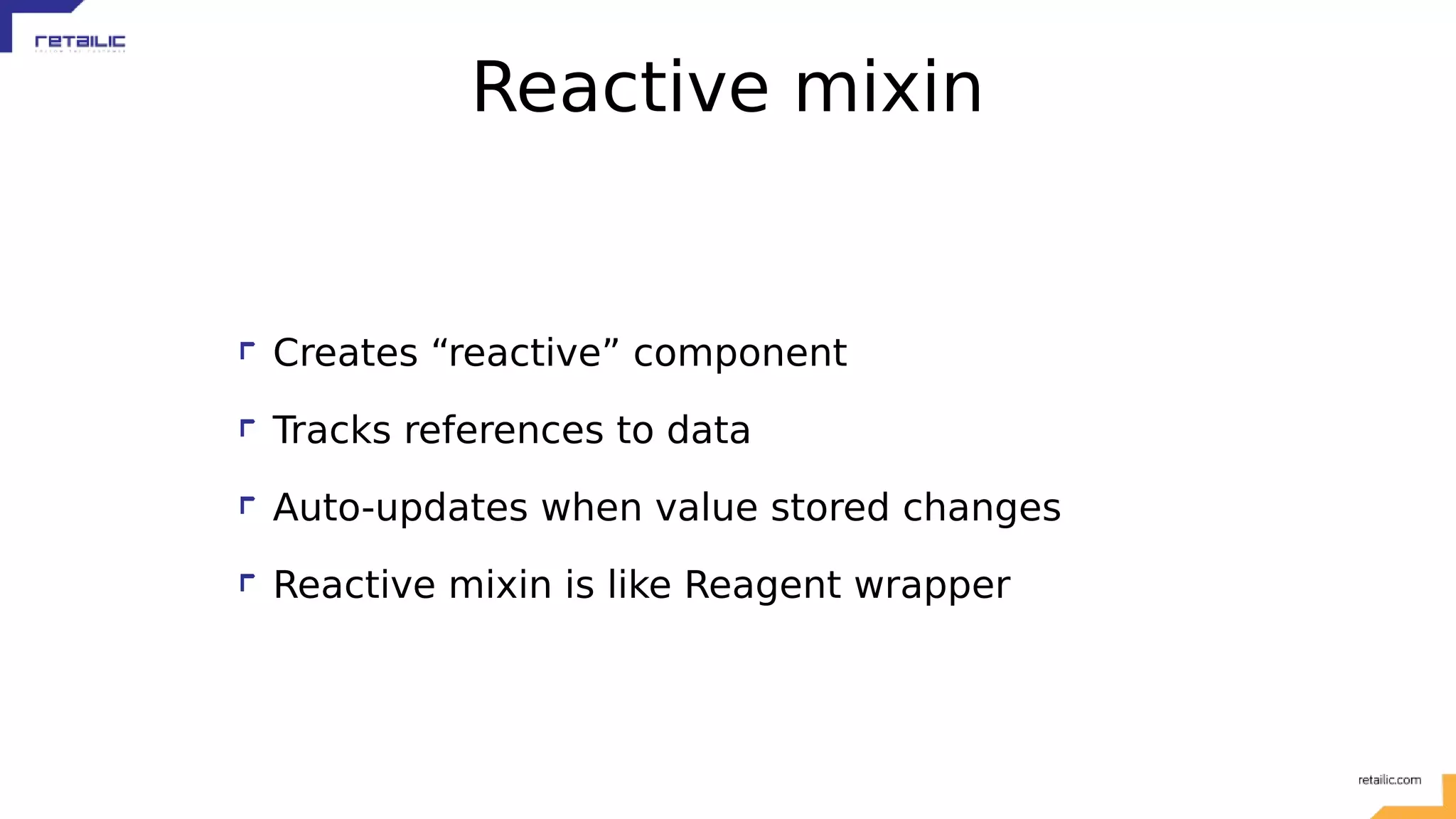

![(def order-form-total (atom 0)) (rum/defc total-sum < rum/reactive [] [:p {:id "total"} (str "Total: £" (rum/react order-form-total))])](https://image.slidesharecdn.com/reactiveprogramminginclojurescriptusingreactjswrappers-160221140934/75/Reactive-programming-in-clojure-script-using-reactjs-wrappers-50-2048.jpg)
![(defn toggle-class [current-class service] (let [price (:price service)] (if (= current-class "active") (do (swap! order-form-total - price) "") (do (swap! order-form-total + price) "active"))))](https://image.slidesharecdn.com/reactiveprogramminginclojurescriptusingreactjswrappers-160221140934/75/Reactive-programming-in-clojure-script-using-reactjs-wrappers-51-2048.jpg)
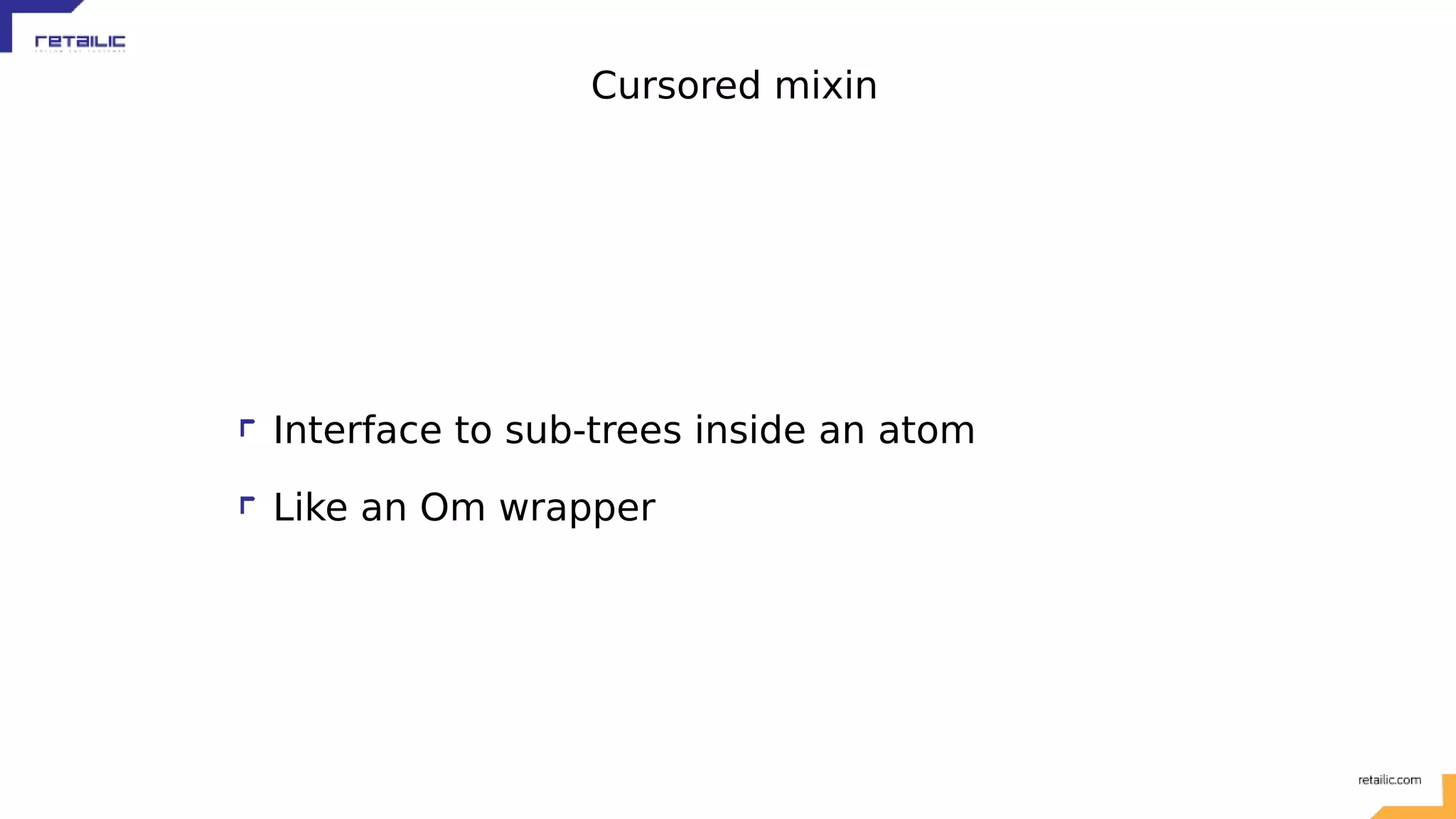
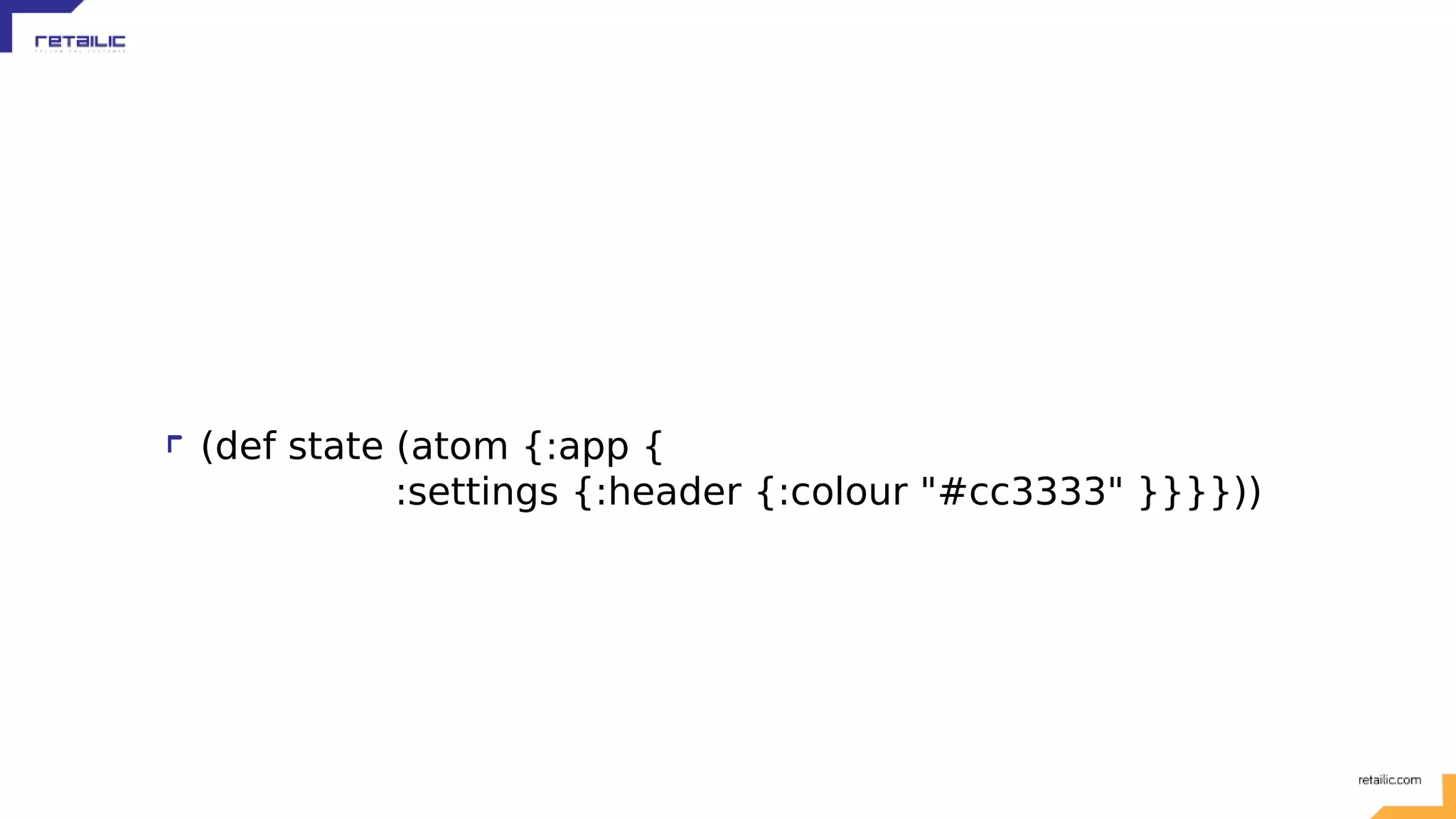
![(rum/defc label < rum/cursored [colour text] [:label {:style {:colour @colour}} text])](https://image.slidesharecdn.com/reactiveprogramminginclojurescriptusingreactjswrappers-160221140934/75/Reactive-programming-in-clojure-script-using-reactjs-wrappers-54-2048.jpg)
![(rum/defc body < rum/cursored [state] [:div (label (rum/cursor state [:app :settings :headers :colour]) "First label" )])](https://image.slidesharecdn.com/reactiveprogramminginclojurescriptusingreactjswrappers-160221140934/75/Reactive-programming-in-clojure-script-using-reactjs-wrappers-55-2048.jpg)
![(swap! state-cursor assoc-in [:app :settings :header :colour] "#cc56bb")](https://image.slidesharecdn.com/reactiveprogramminginclojurescriptusingreactjswrappers-160221140934/75/Reactive-programming-in-clojure-script-using-reactjs-wrappers-56-2048.jpg)
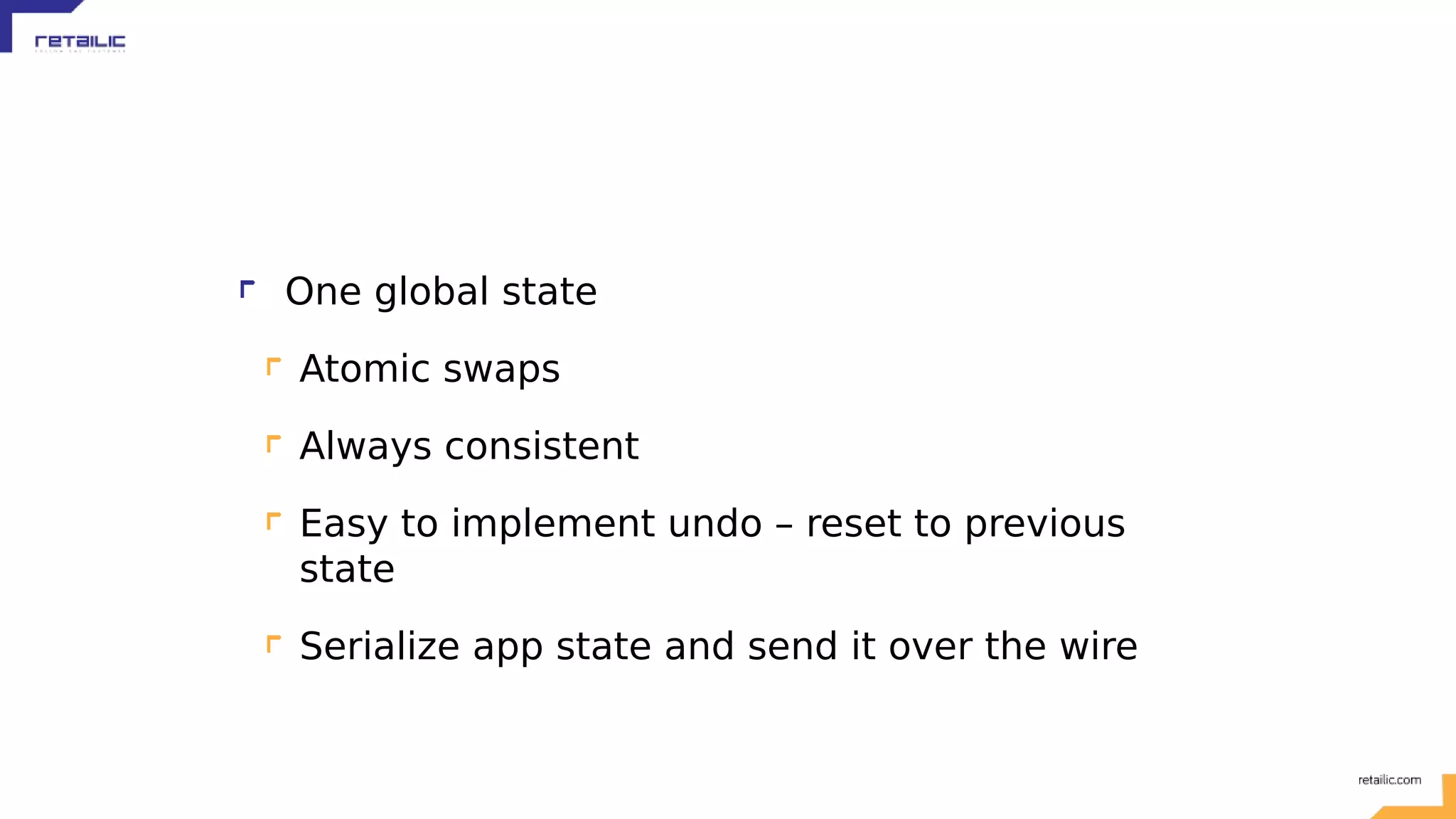
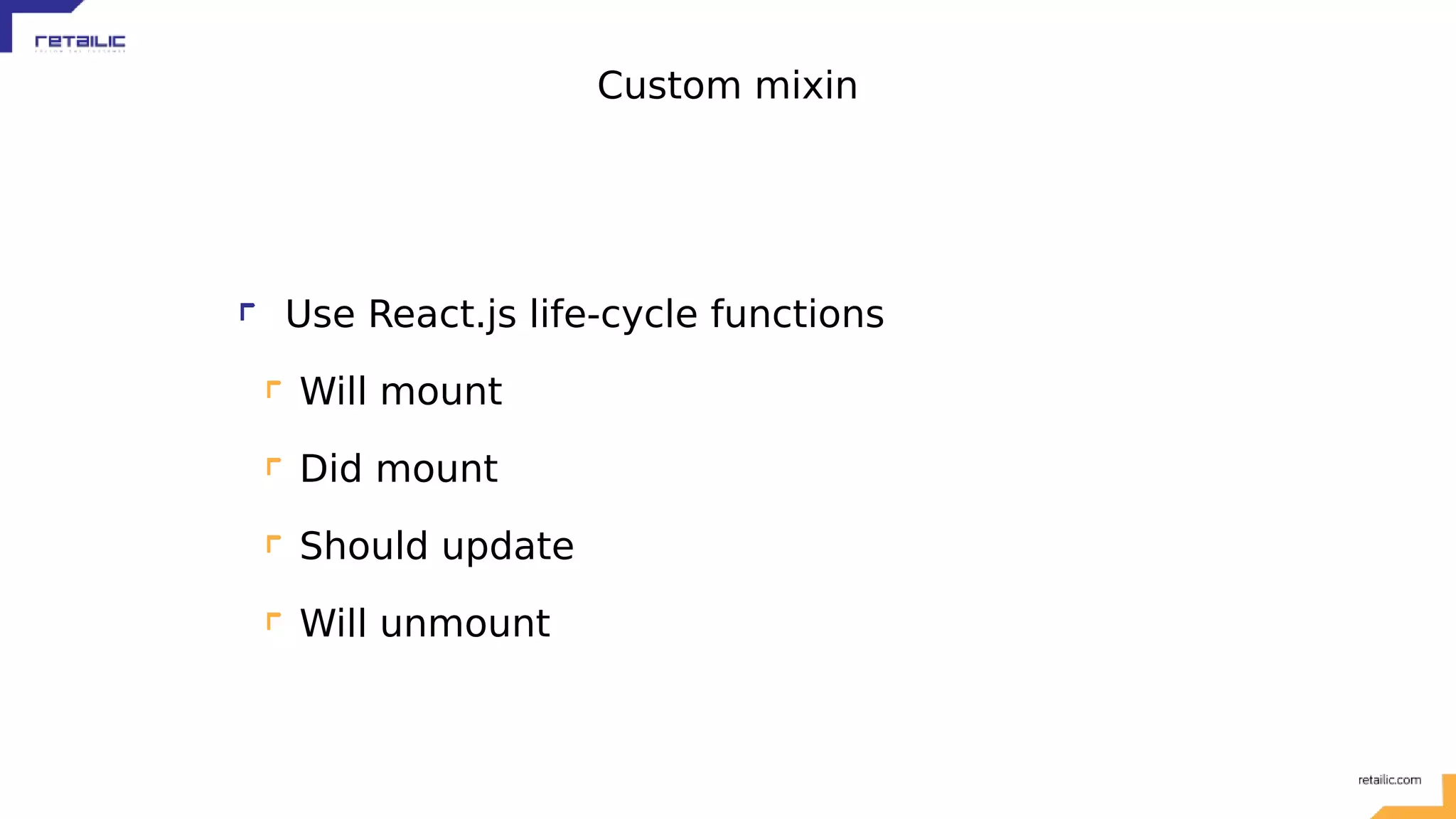

![(defn scroll-view [height] {:did-mount (fn [state] (if-not (::scrolled state) (do (set-scroll-top! height) (assoc state ::scrolled true)) state)) :transfer-state (fn [old new] (assoc new ::scrolled (::scrolled old) ::with-scroll-view true))})](https://image.slidesharecdn.com/reactiveprogramminginclojurescriptusingreactjswrappers-160221140934/75/Reactive-programming-in-clojure-script-using-reactjs-wrappers-60-2048.jpg)
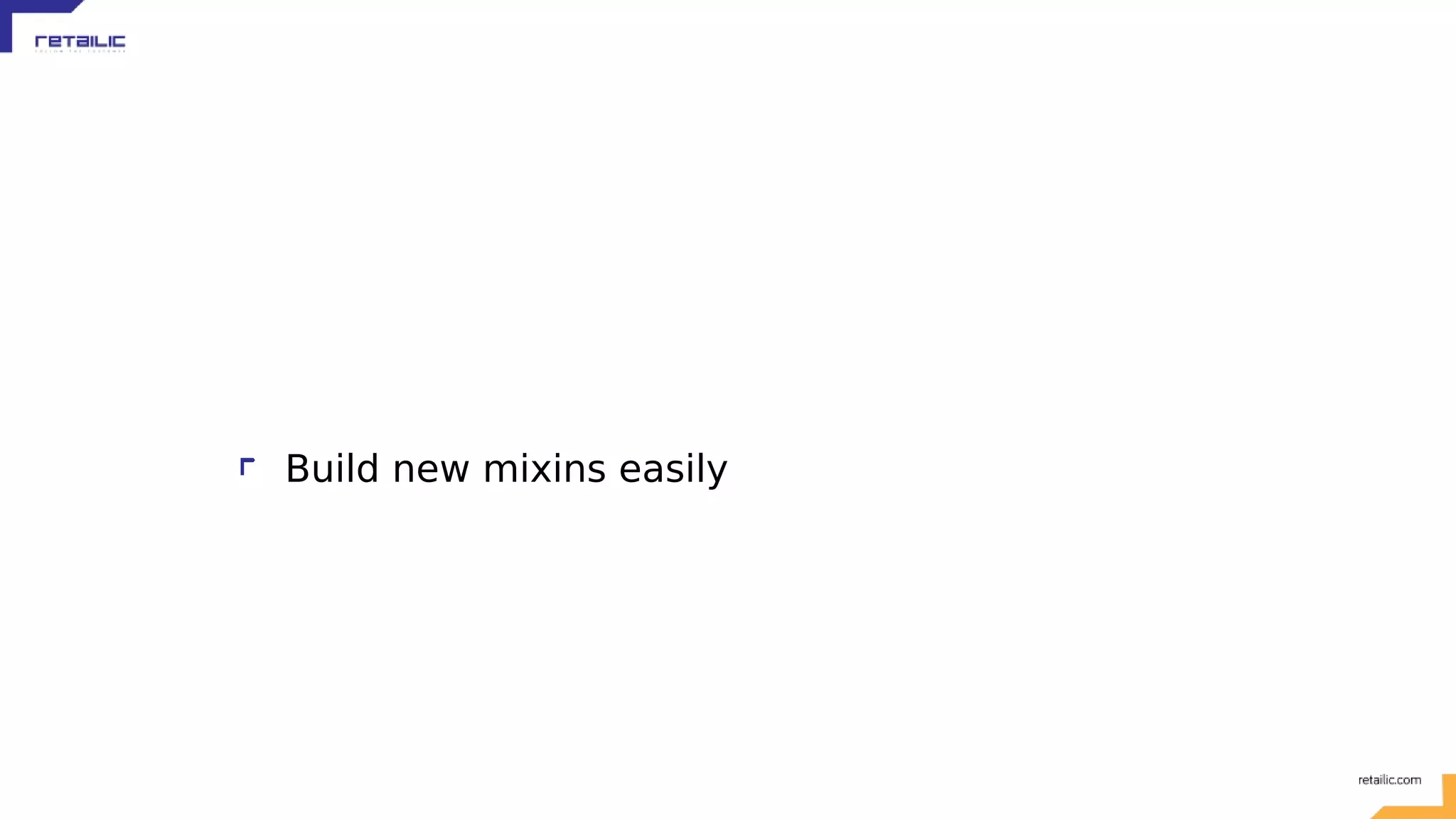
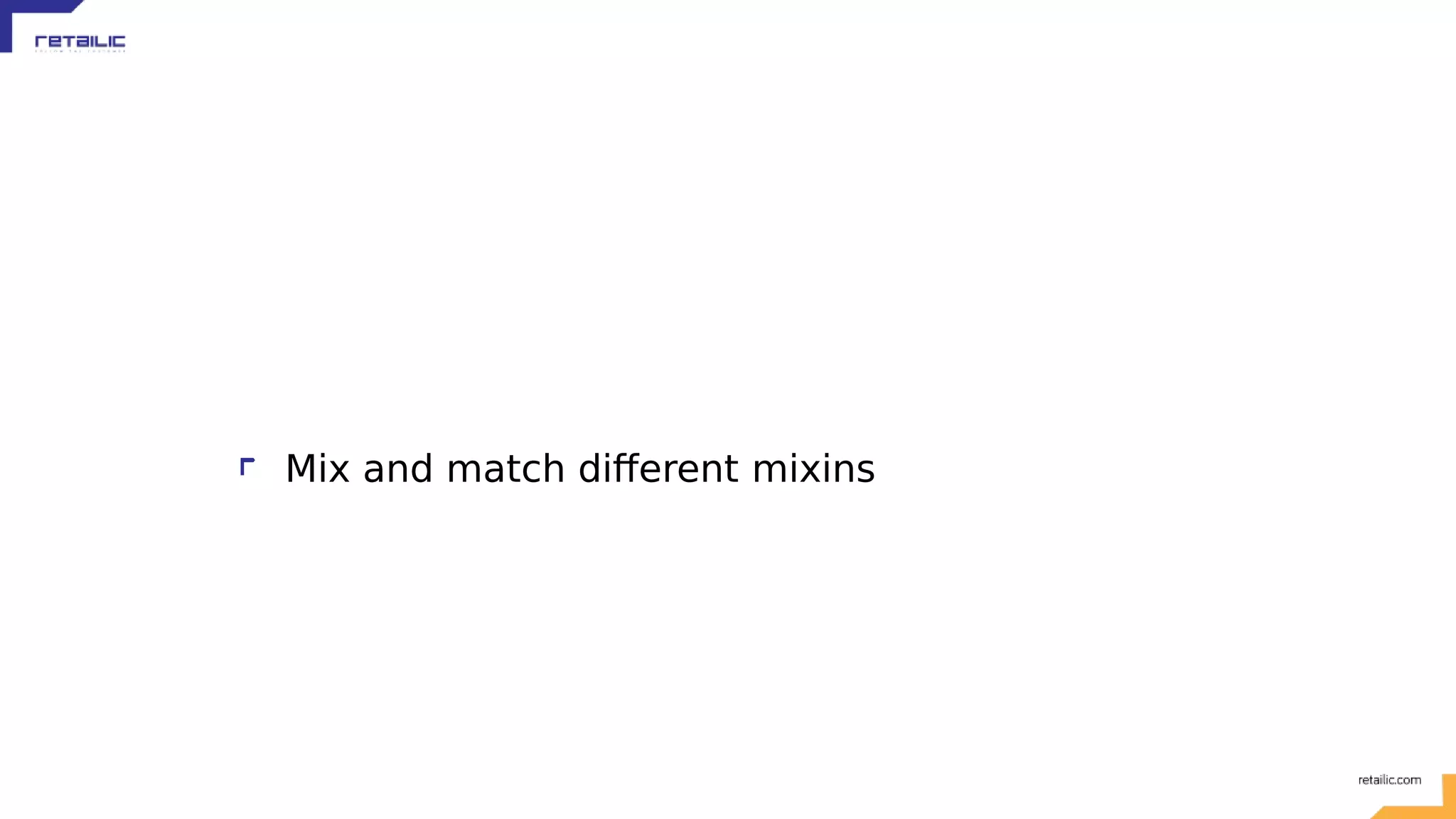
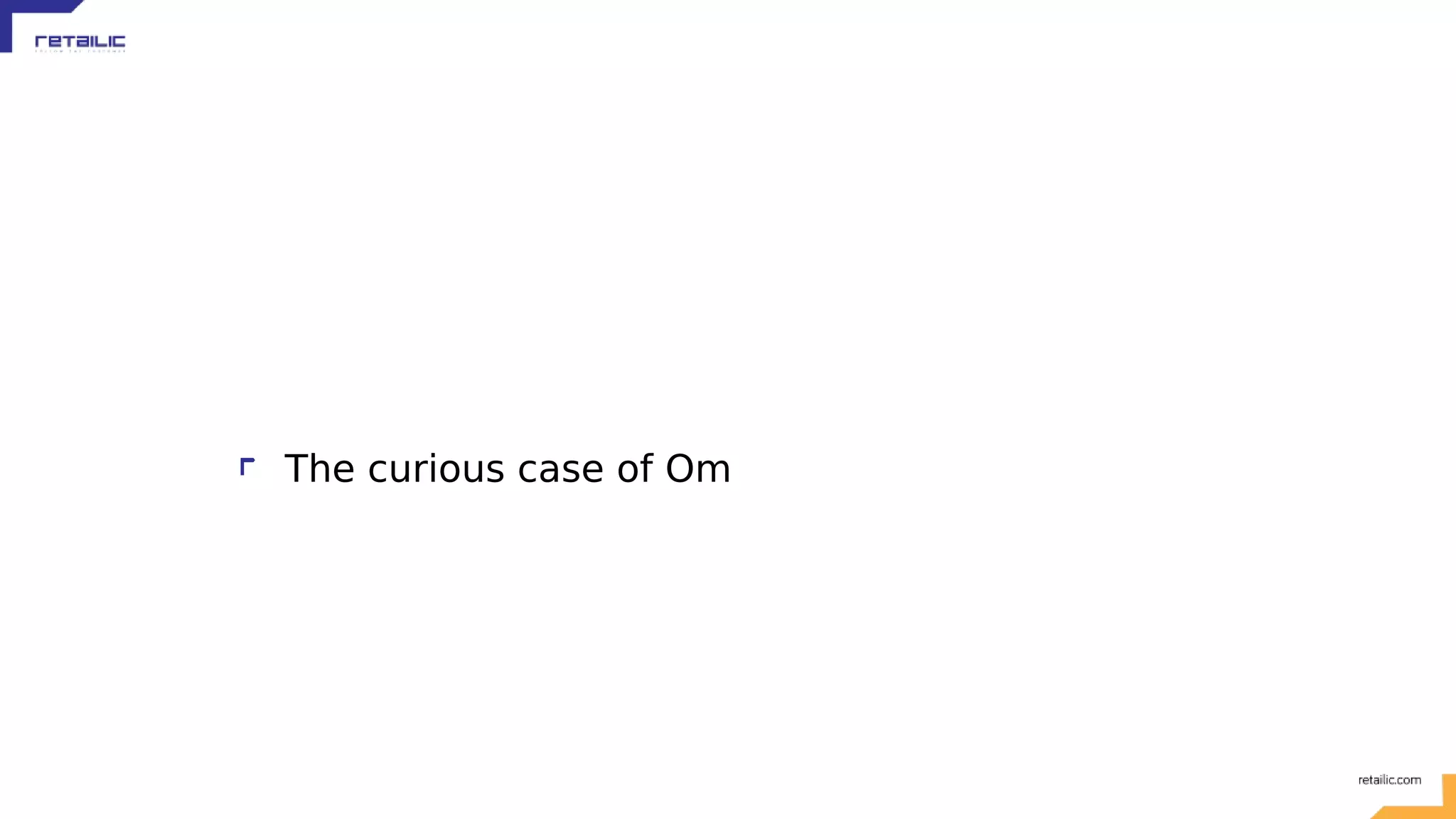
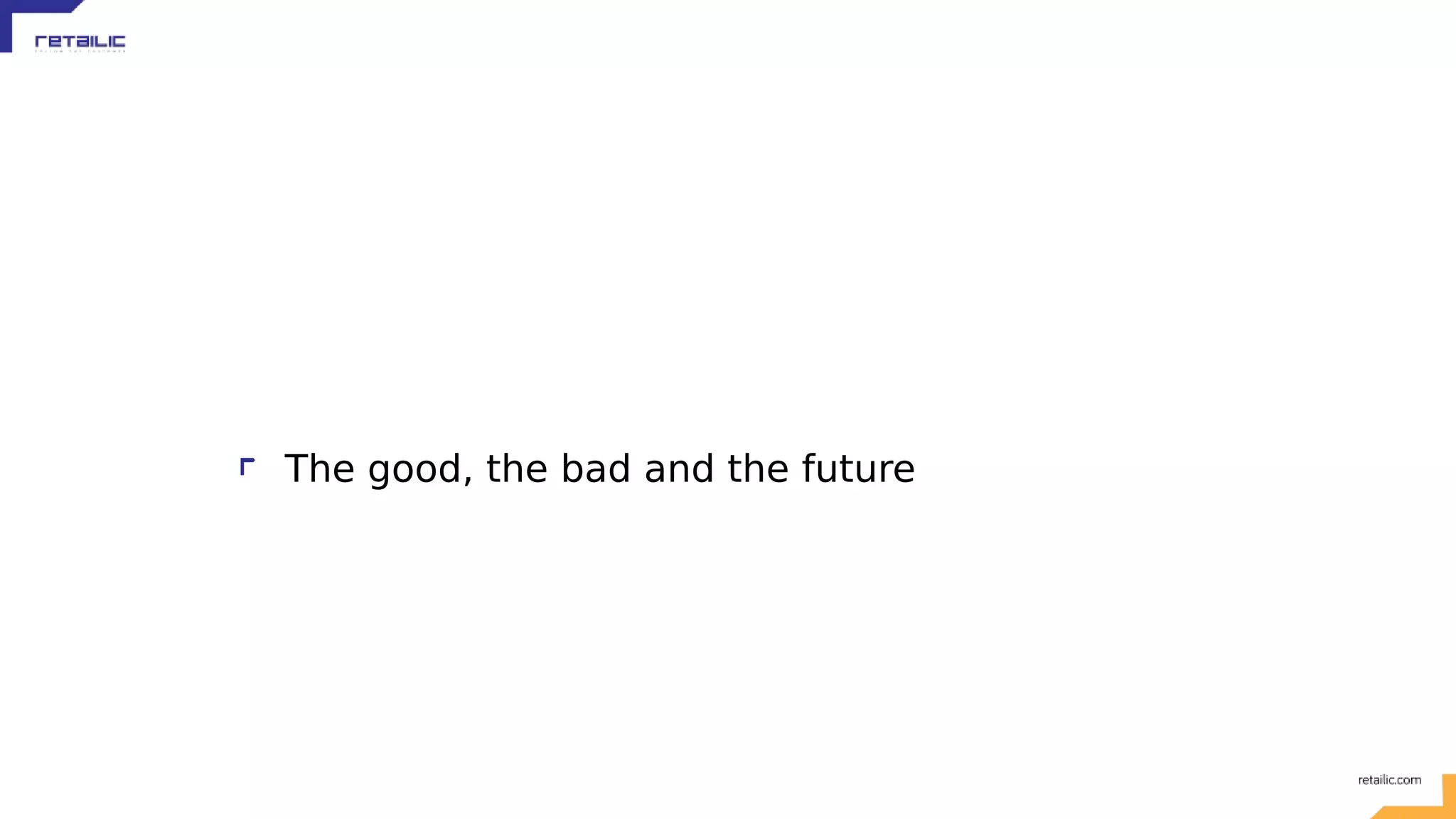
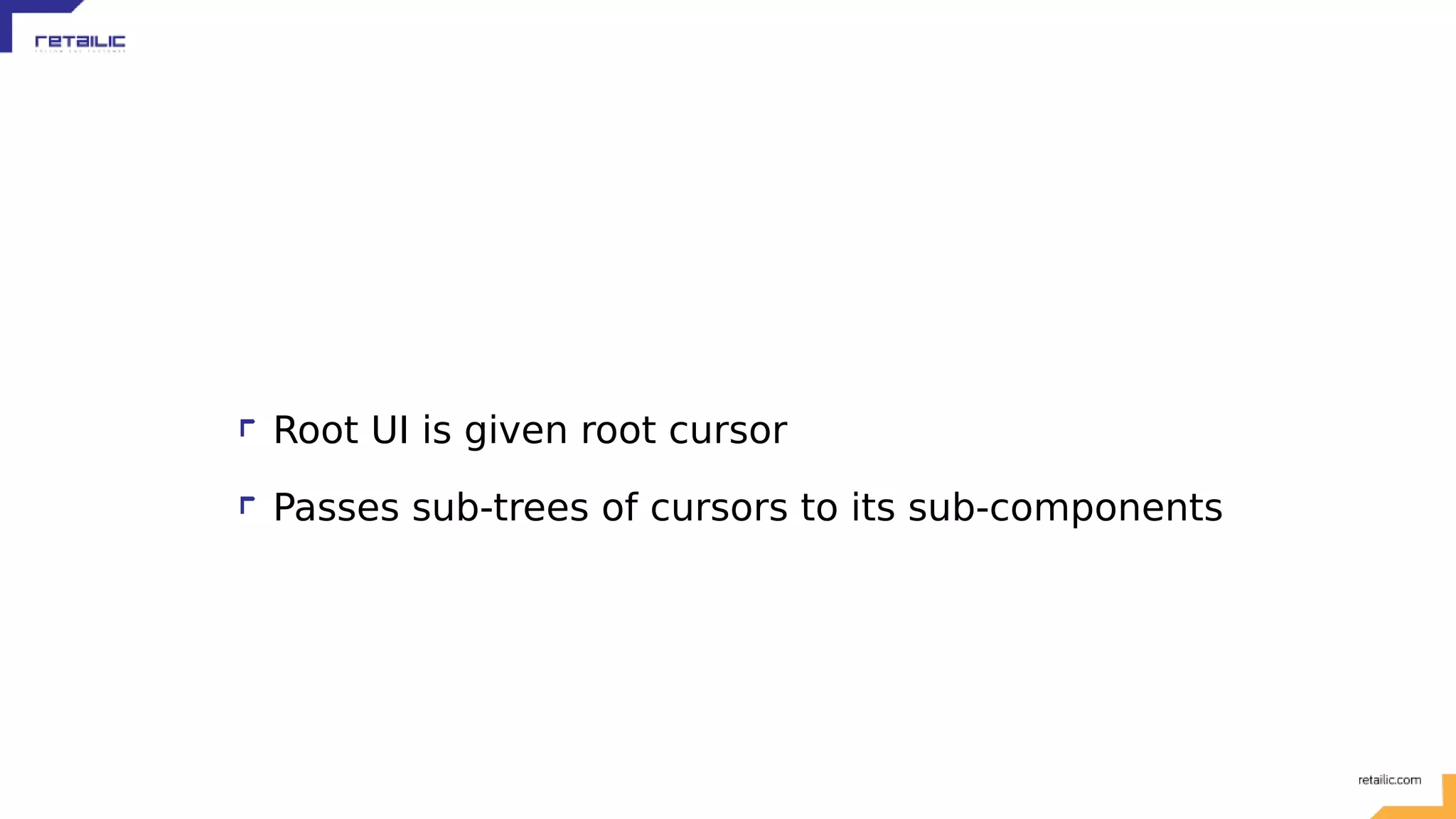
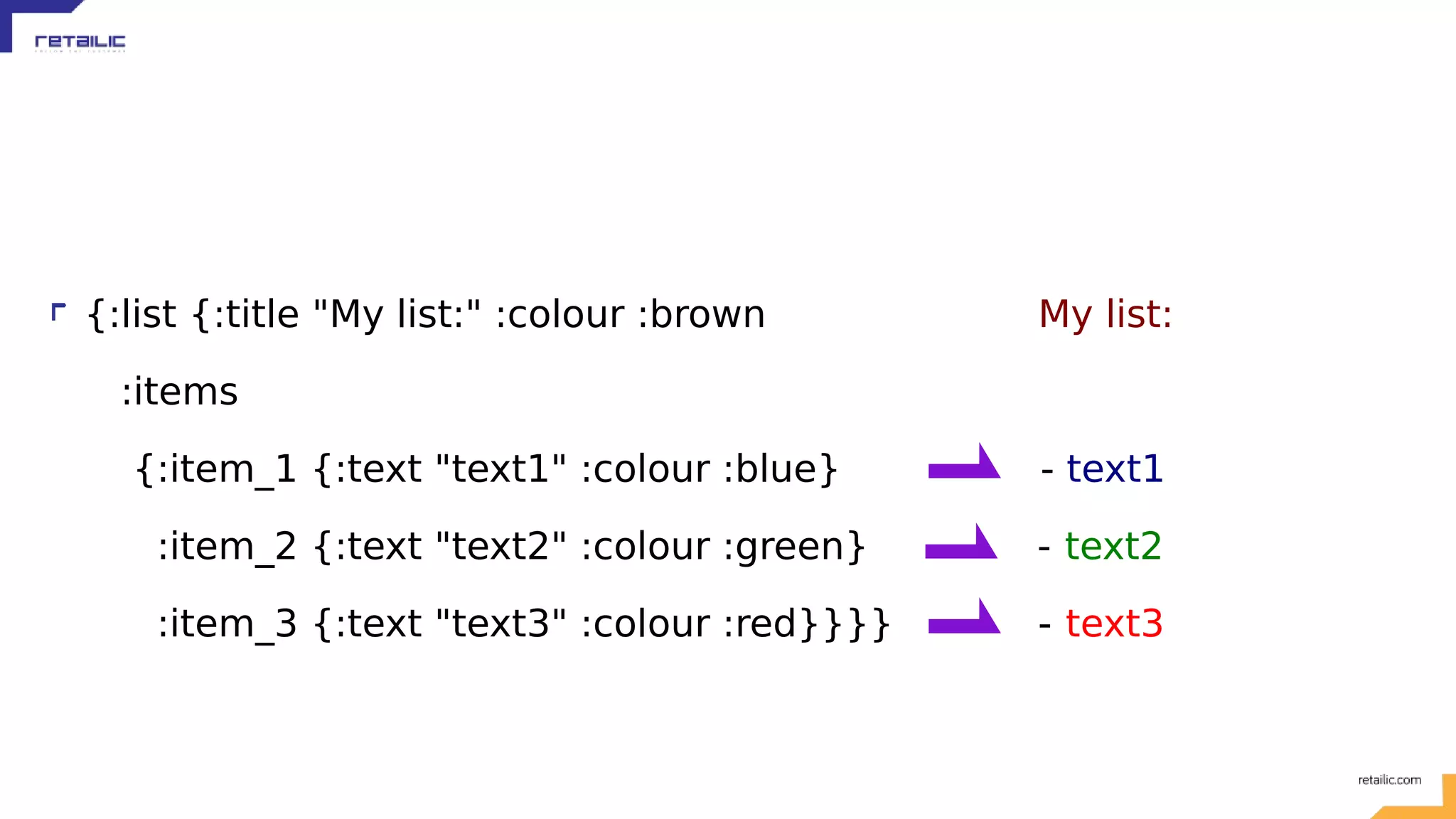
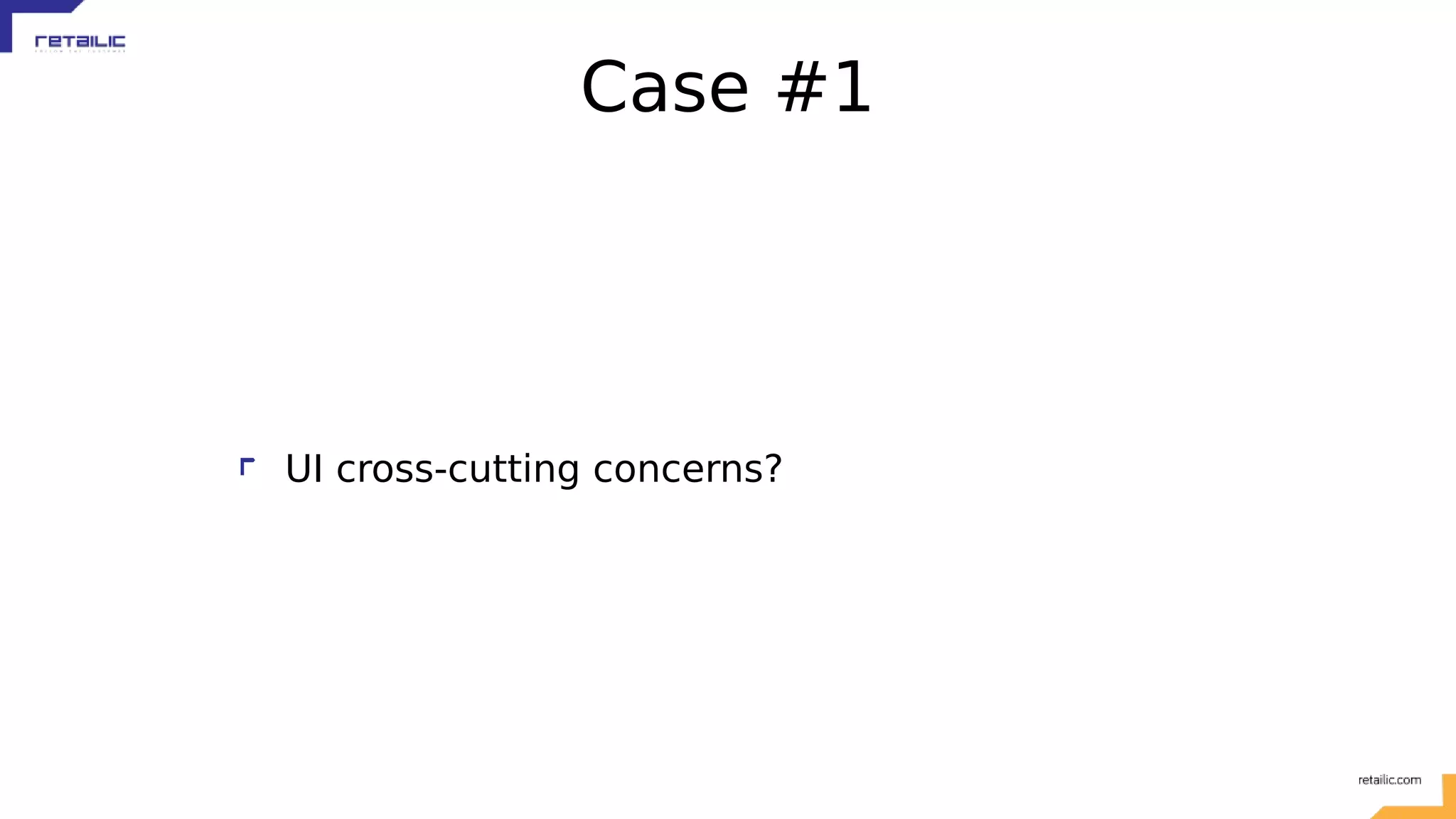
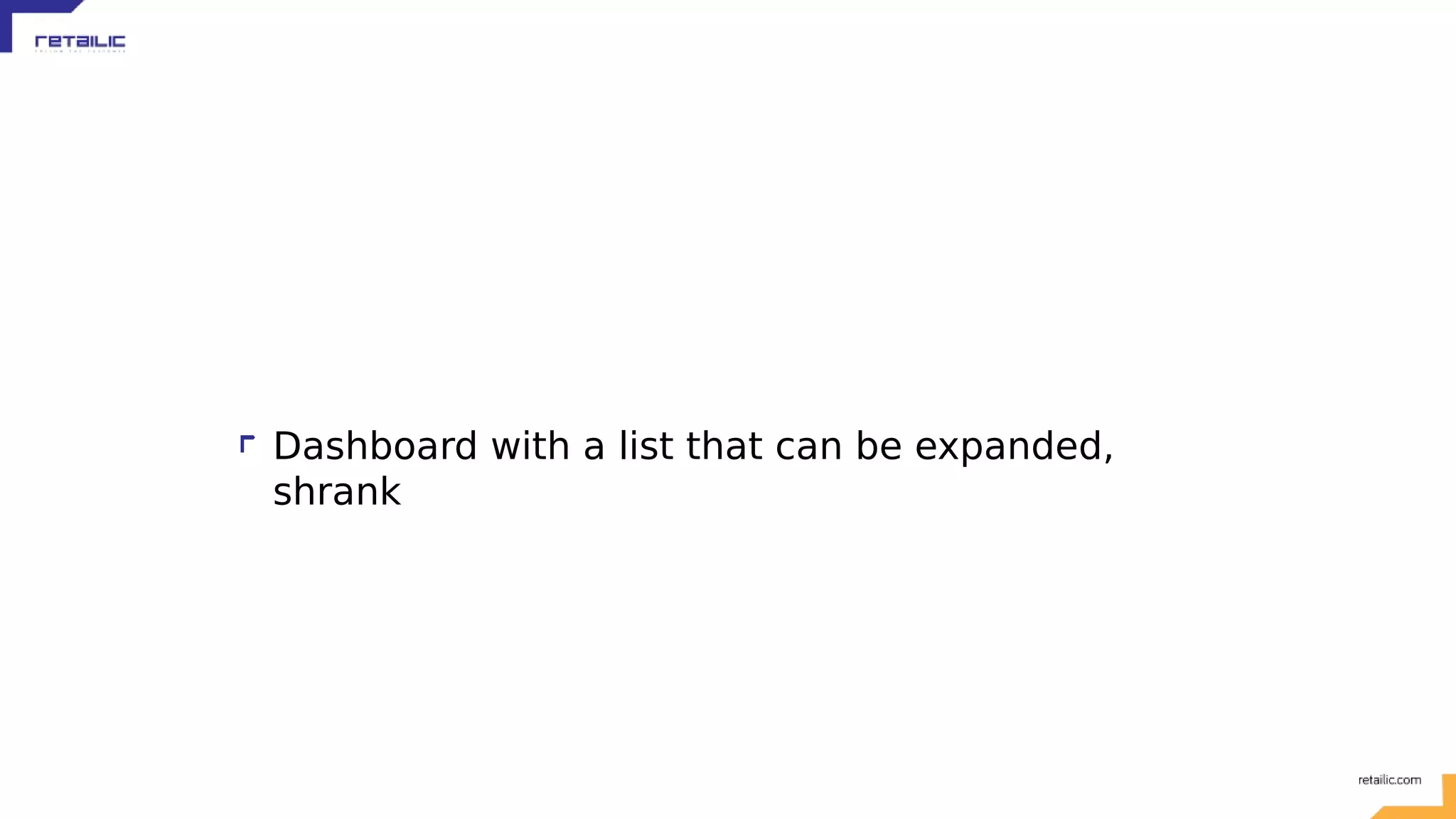

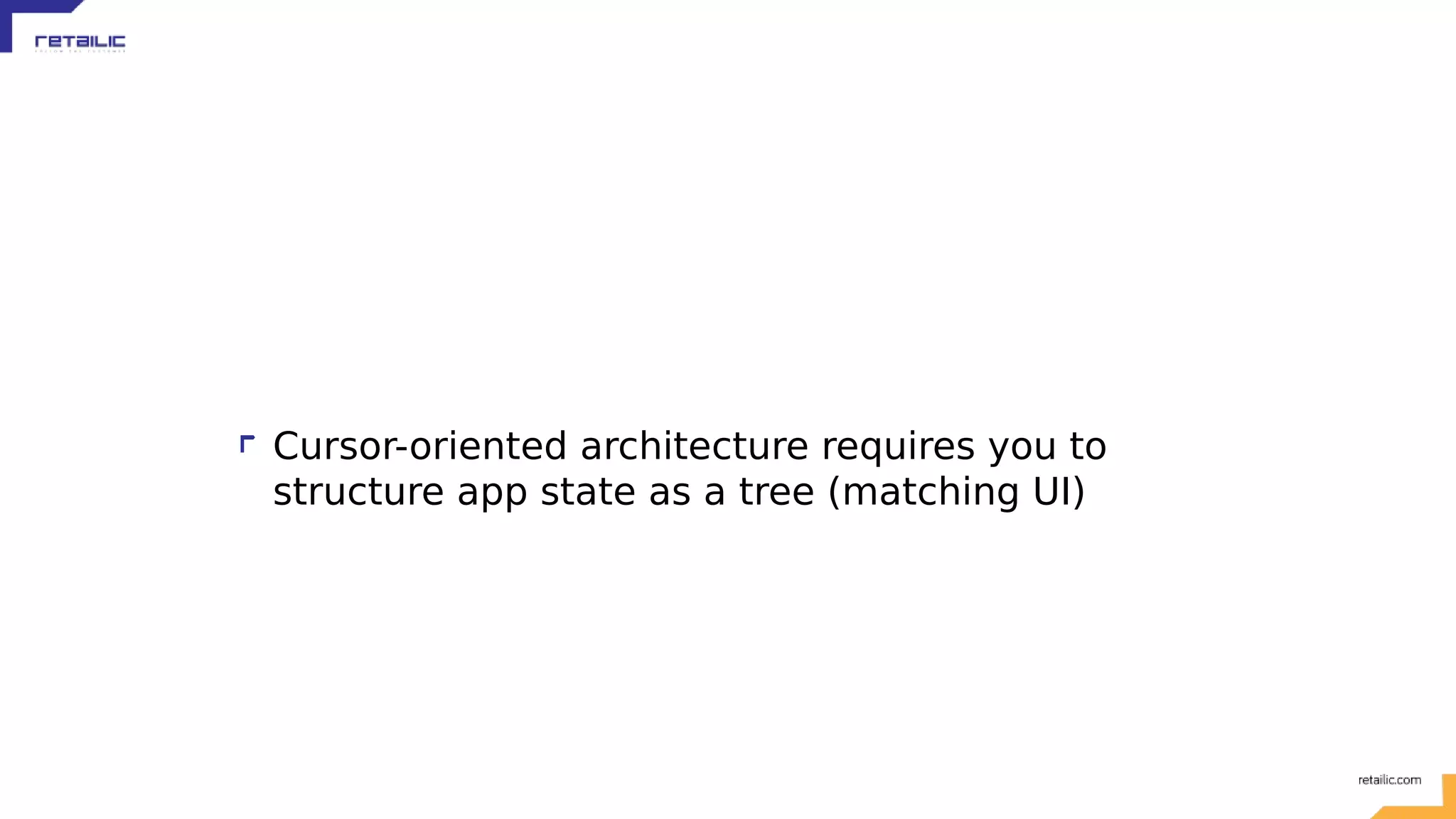
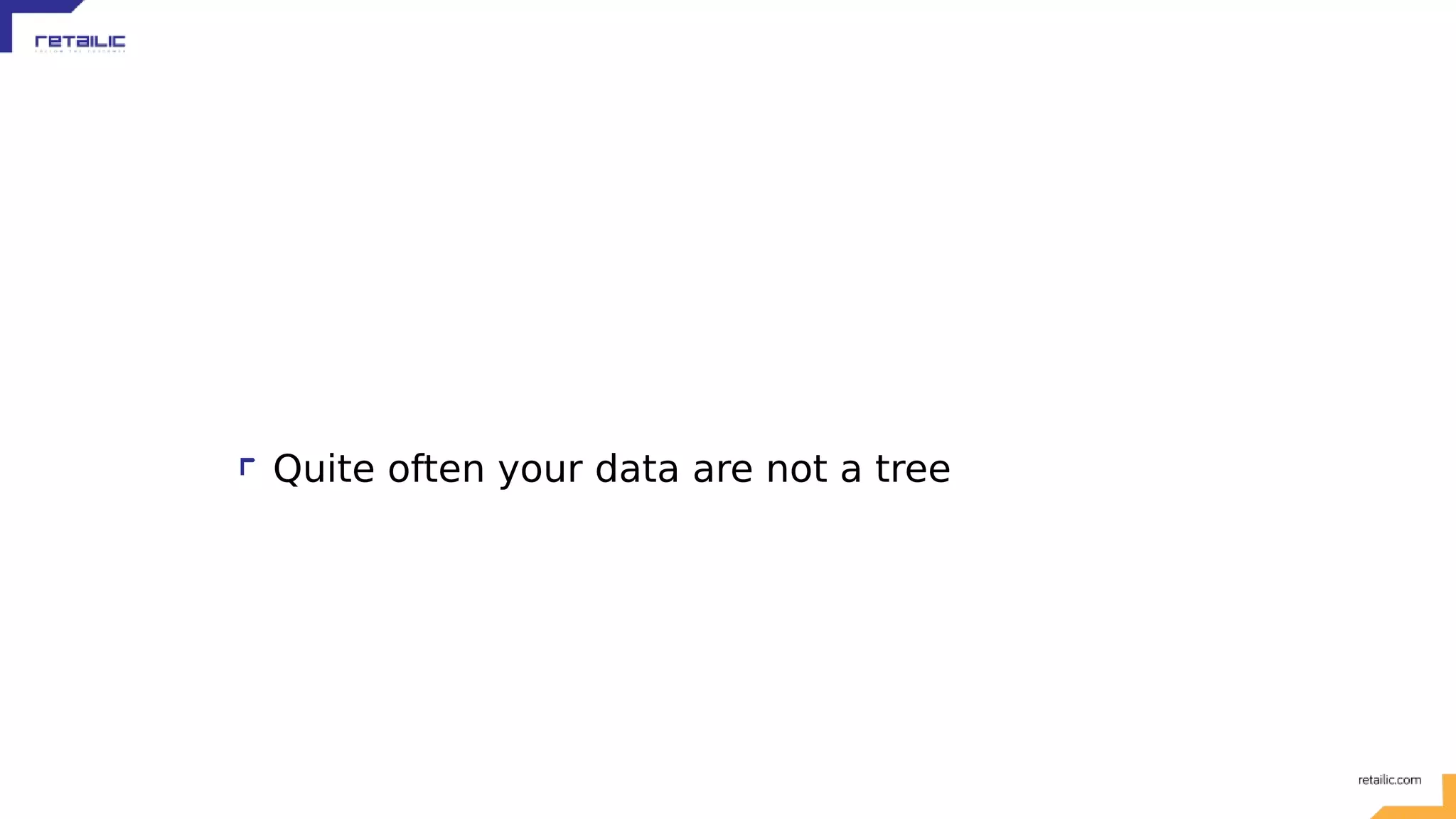
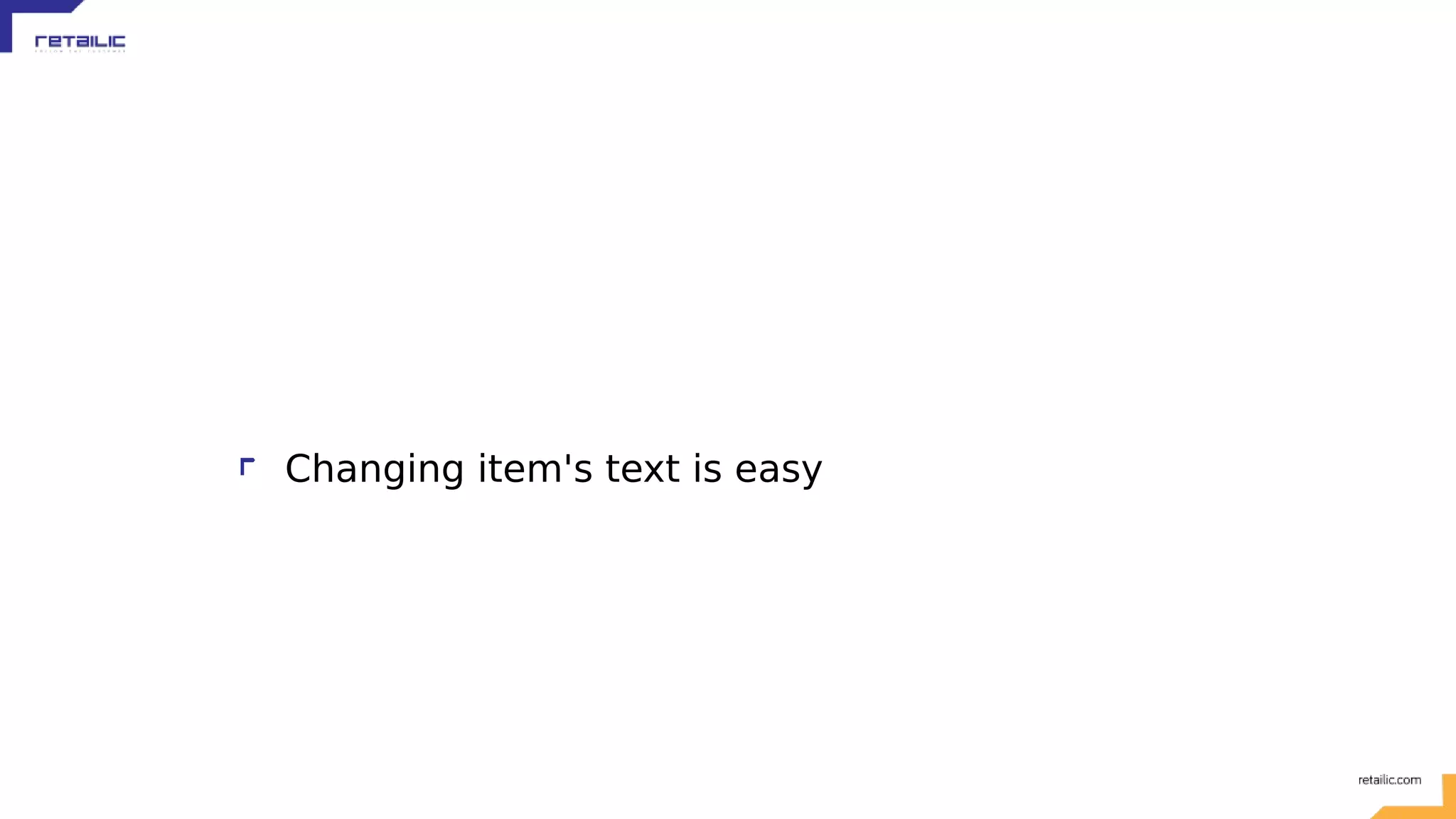
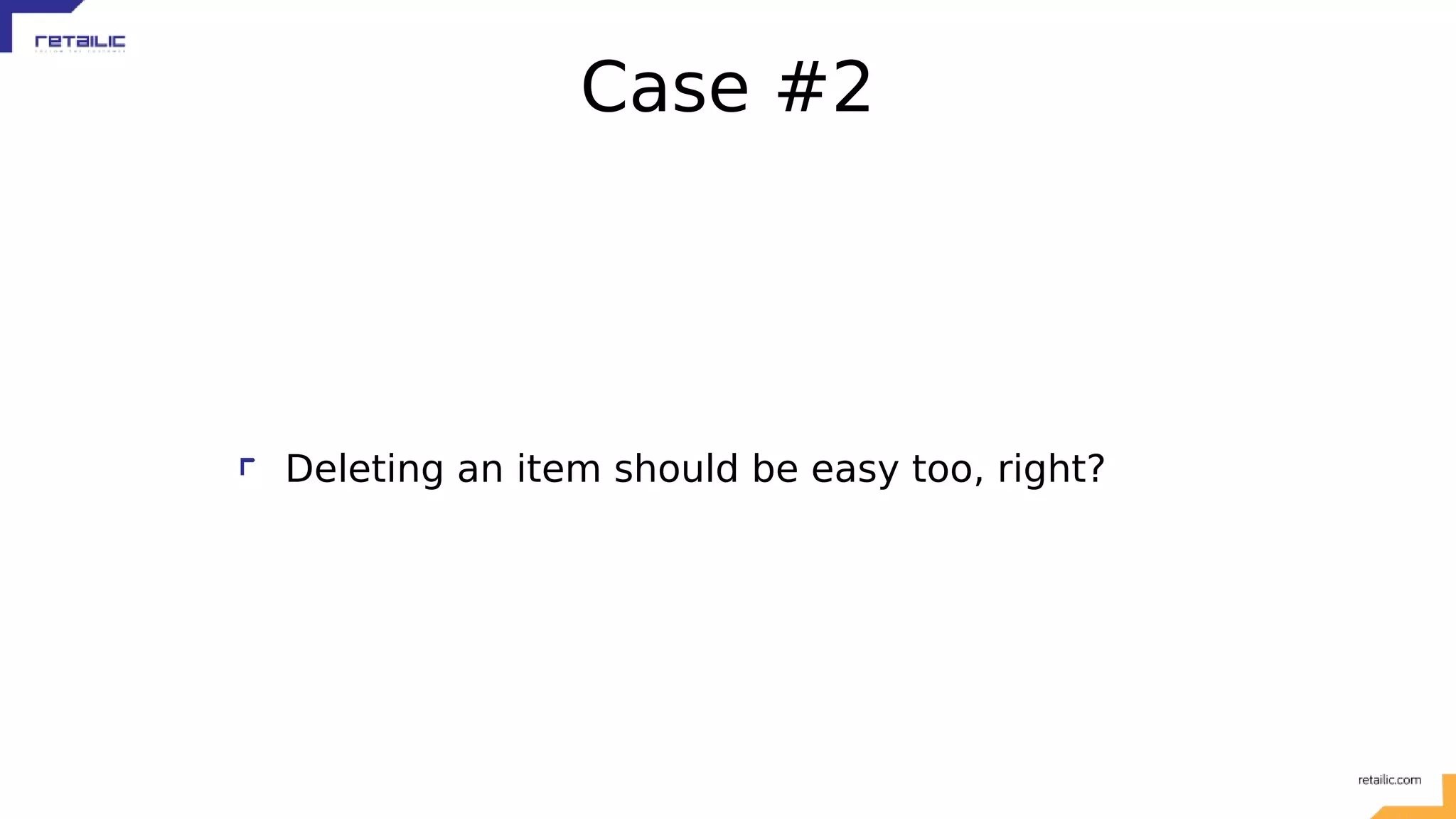
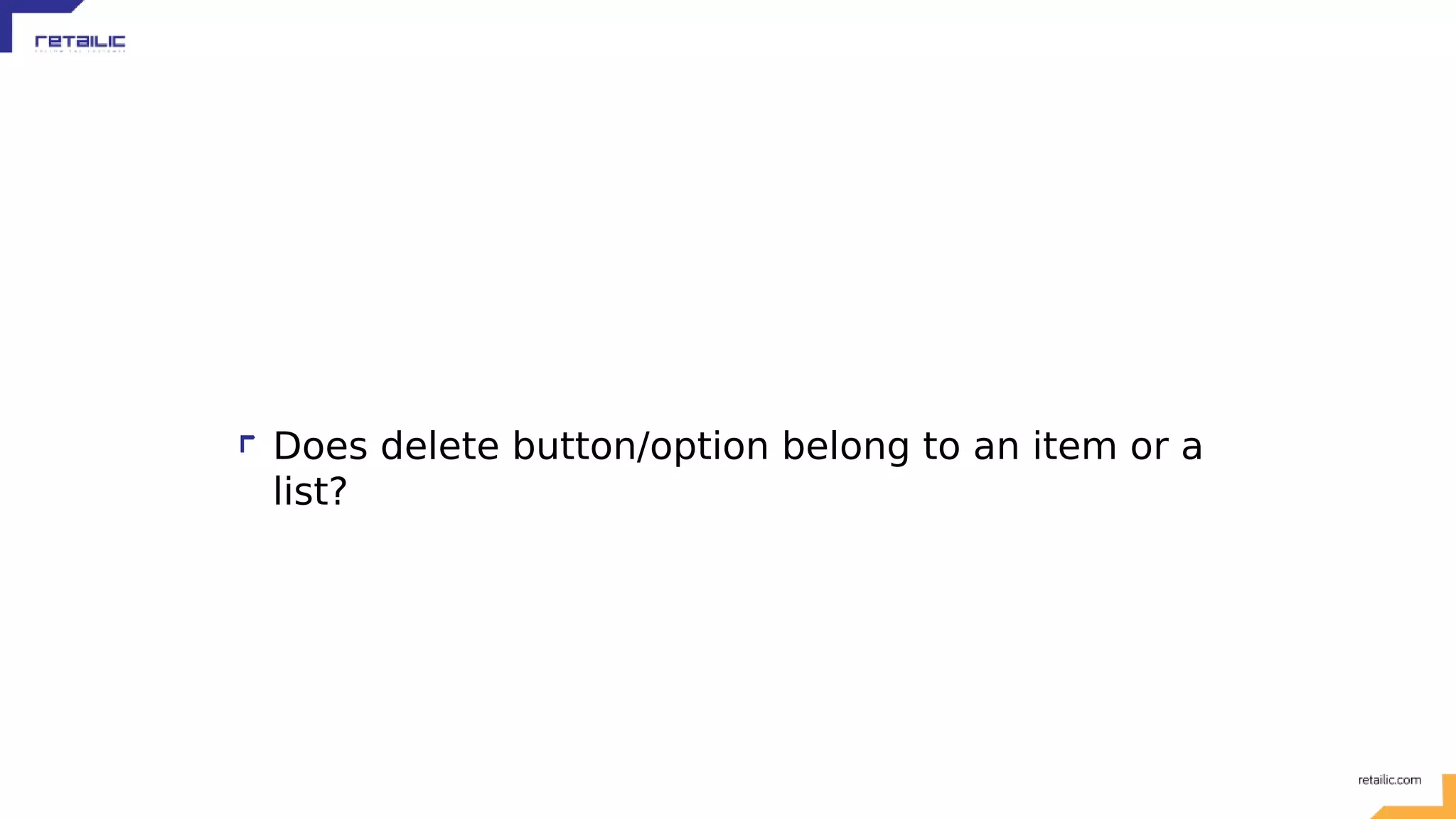
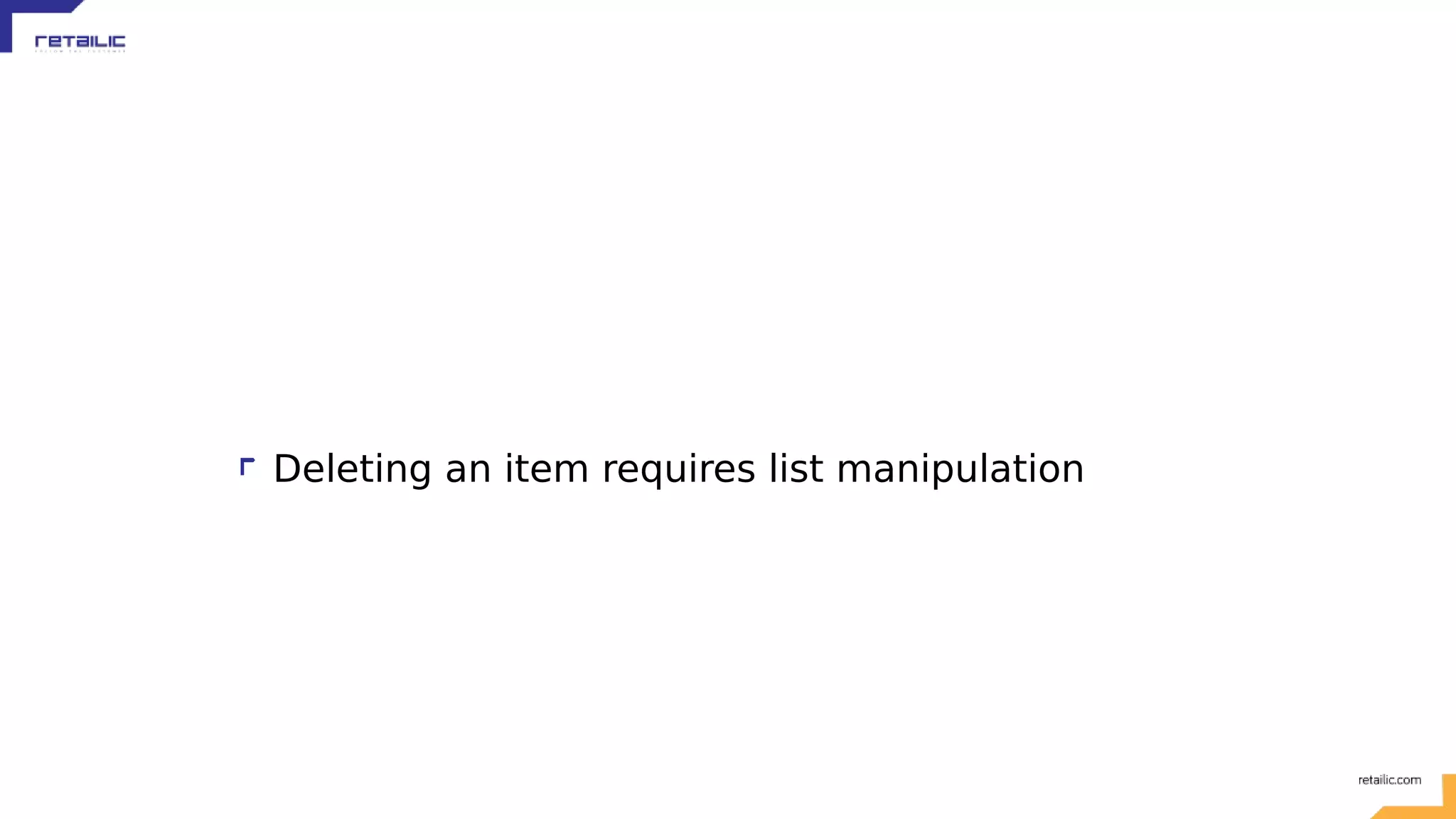
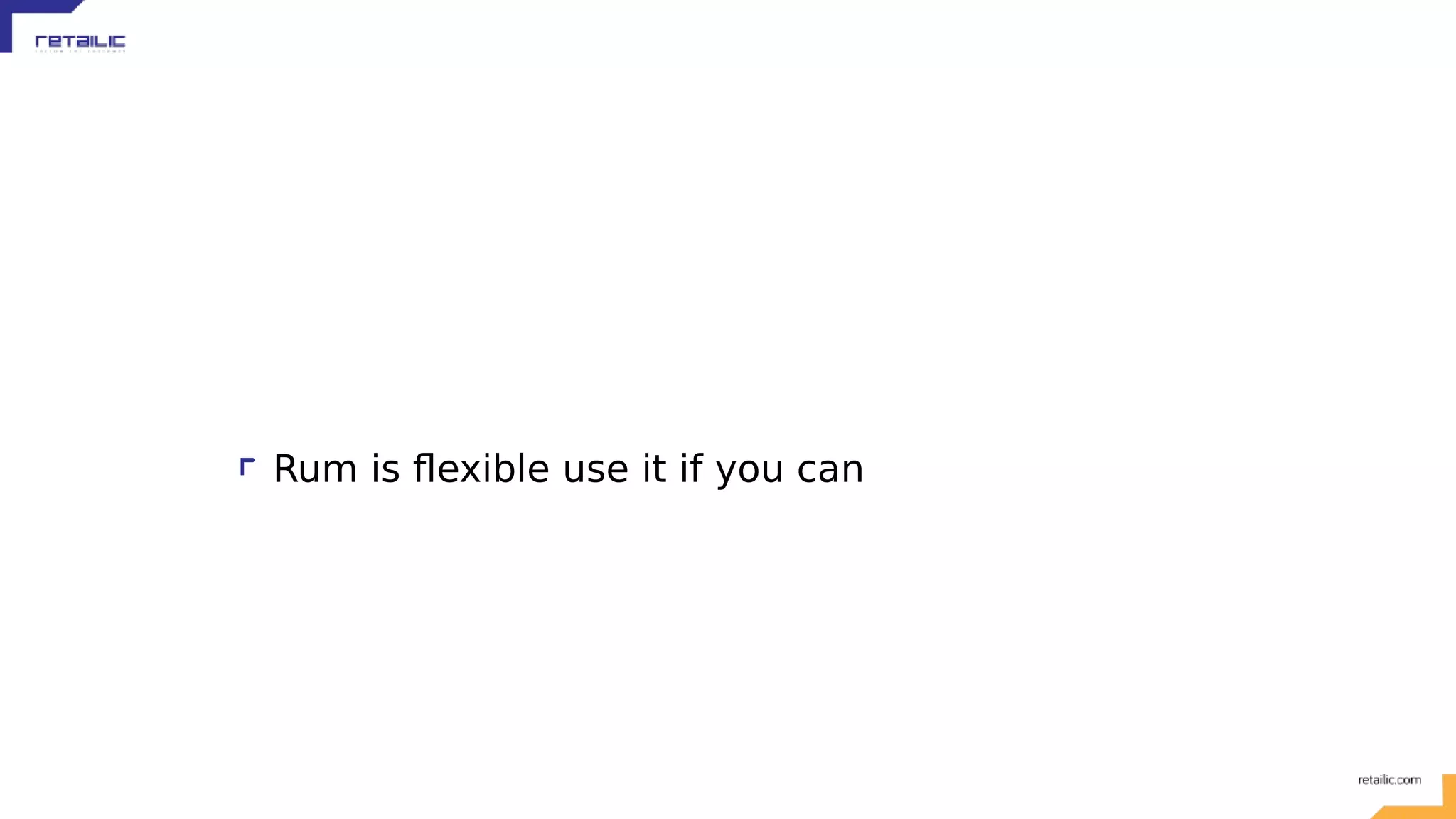
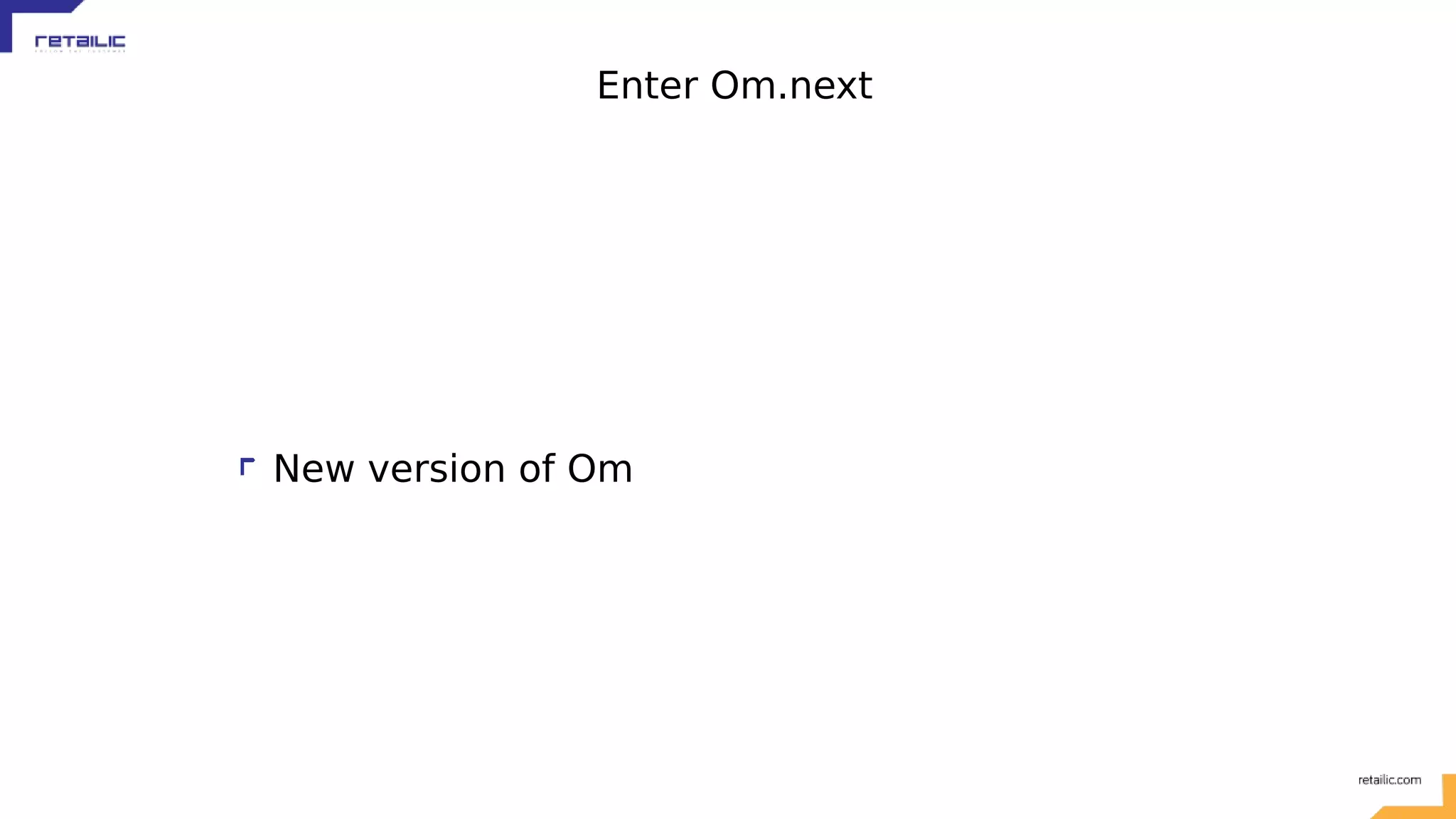
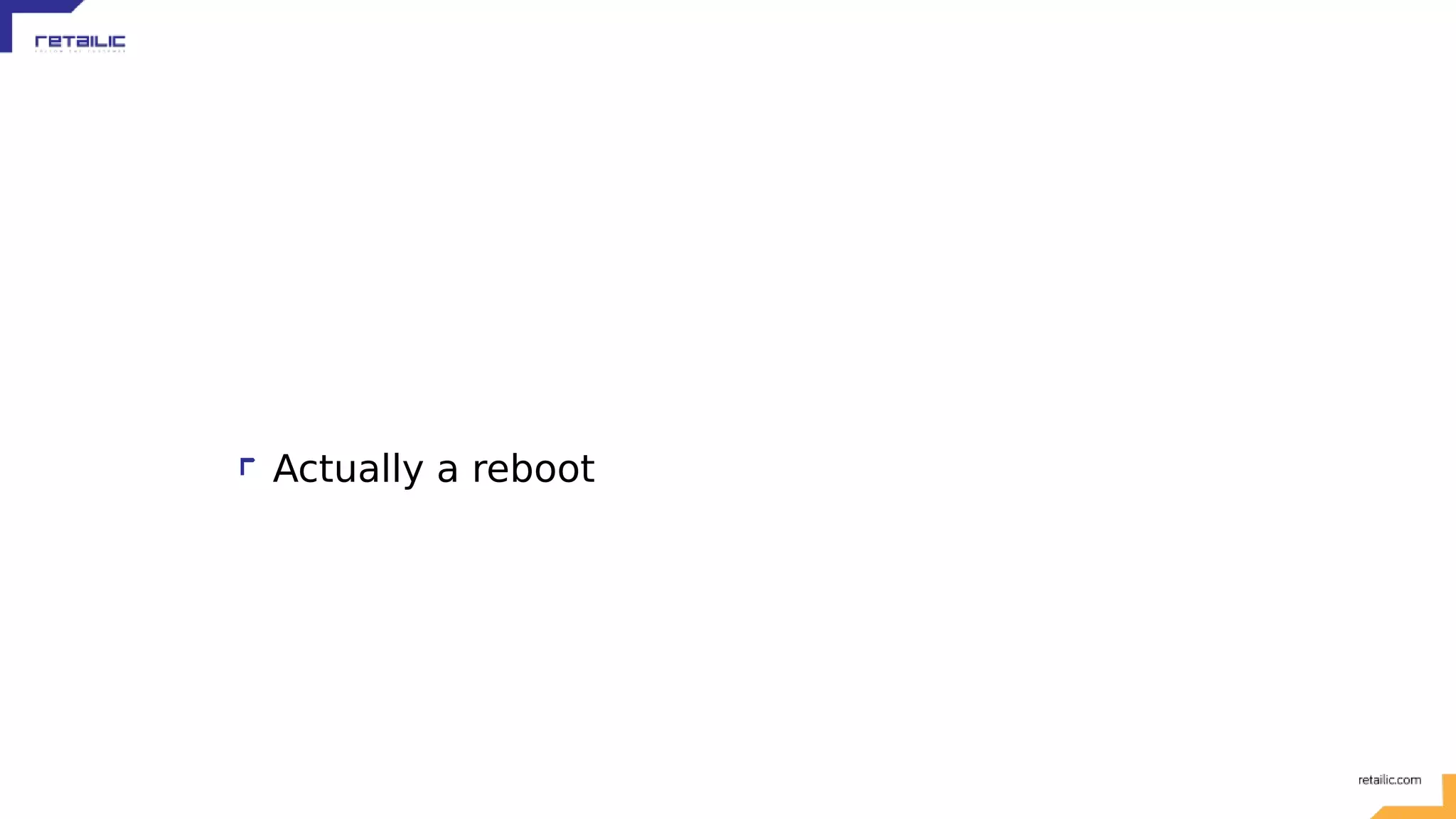
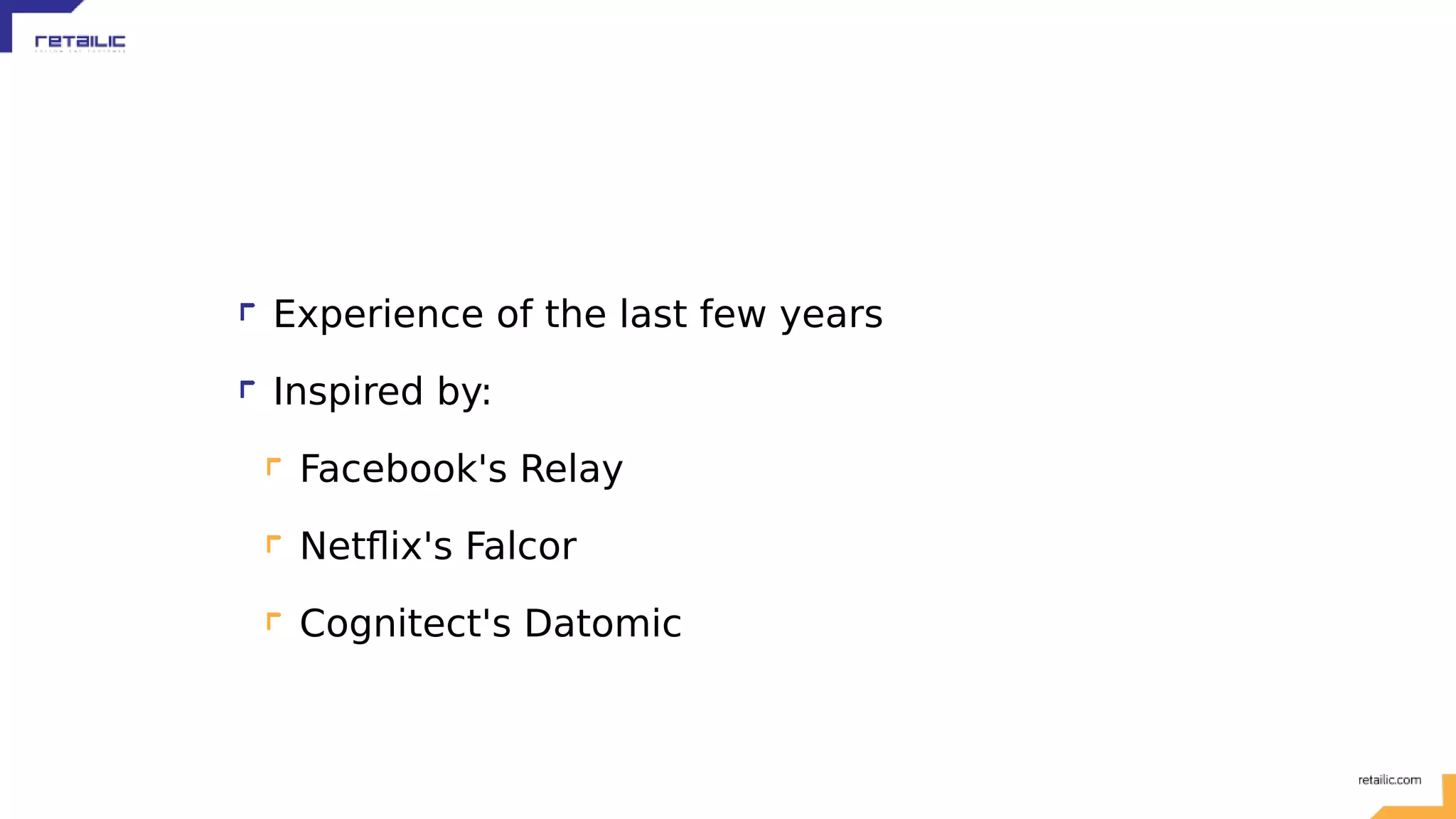
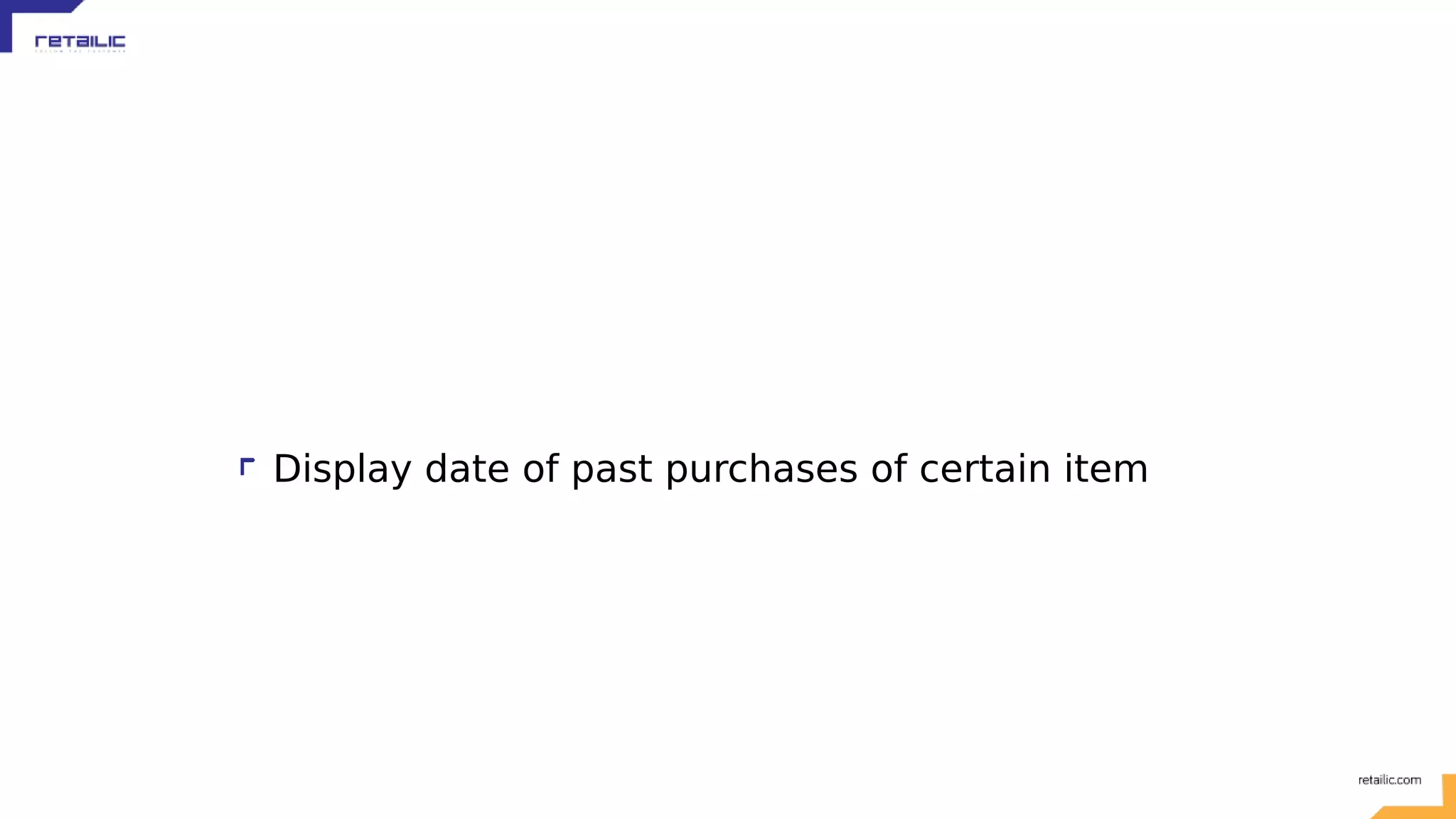
![{:current-user {:purchases [{:id 146 :product-name "organic rice" :date #inst "2015-12-17T17:13:59.167-00:00" :previous {:id 140 :product-name "organic rice" :date #inst "2015-12-14T17:05:58.144-00:00" :previous {:id 136 :product-name "organic rice" :date #inst "2015-12-10T17:05:13.512-00:00" :previous ; and so on... }}} {:id 145 :product-name "soy milk" :date #inst "2015-12-17T17:09:25.961-00:00" :previous {:id 141 :product-name "soy milk" :date #inst "2015-12-15T17:05:36.797-00:00" :previous {:id 128 :product-name "soy milk" :date #inst "2015-12-07T17:04:51.124-00:00" :previous ; and so on... }}}]}}](https://image.slidesharecdn.com/reactiveprogramminginclojurescriptusingreactjswrappers-160221140934/75/Reactive-programming-in-clojure-script-using-reactjs-wrappers-81-2048.jpg)
![{:current-user {:recent-purchases [[:purchase-id 146] [:purchase-id 145]]} :purchased-items {146 {:id 146 :product-name "organic rice" :date #inst "2015-12-17T17:13:59.167-00:00" :previous [:purchase-id 144]} 145 {:id 145 :product-name "soy milk" :date #inst "2015-12-17T17:09:25.961-00:00" :previous [:purchase-id 143]} 144 {:id 144 :product-name "organic rice" :date #inst "2015-12-17T17:05:58.144-00:00" :previous [:purchase-id 141]} 143 {:id 143 :product-name "soy milk" :date #inst "2015-12-17T17:05:36.797-00:00" :previous [:purchase-id 138]} ;; and so on... }}](https://image.slidesharecdn.com/reactiveprogramminginclojurescriptusingreactjswrappers-160221140934/75/Reactive-programming-in-clojure-script-using-reactjs-wrappers-82-2048.jpg)
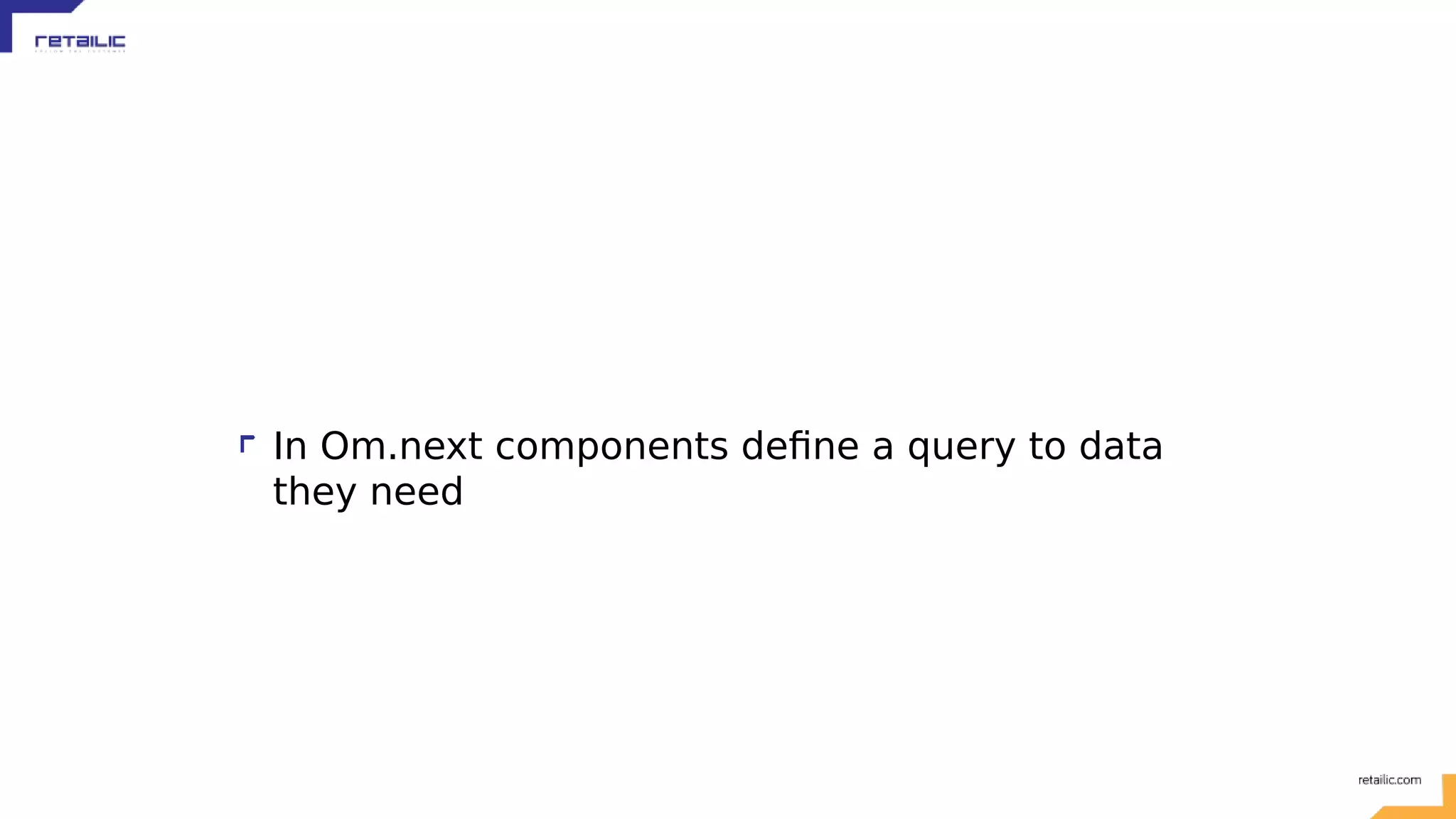
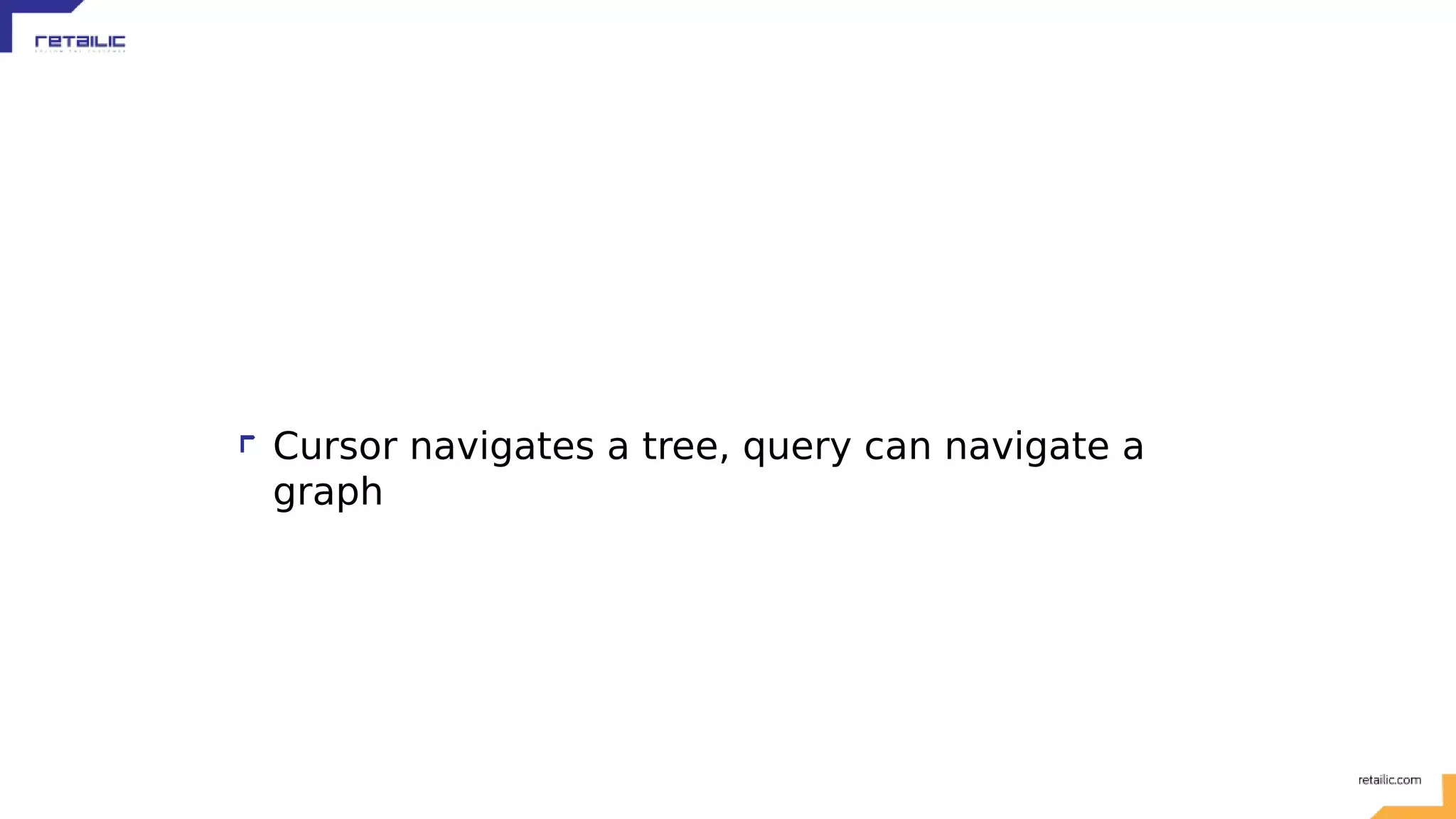
![[{:current-user [{:recent-purchases [{:previous [:date]}]}]}]](https://image.slidesharecdn.com/reactiveprogramminginclojurescriptusingreactjswrappers-160221140934/75/Reactive-programming-in-clojure-script-using-reactjs-wrappers-85-2048.jpg)
![{:current-user {:recent-purchases [{:previous {:date #inst "2015-12-17T17:05:58.144-00:00"}} {:previous {:date #inst "2015-12-17T17:05:36.797-00:00"}}]}}](https://image.slidesharecdn.com/reactiveprogramminginclojurescriptusingreactjswrappers-160221140934/75/Reactive-programming-in-clojure-script-using-reactjs-wrappers-86-2048.jpg)
![{:current-user {:recent-purchases [[:purchase-id 146] [:purchase-id 145]]} :purchased-items {146 {:id 146 :product-name "organic rice" :date #inst "2015-12-17T17:13:59.167-00:00" :previous [:purchase-id 144]} 145 {:id 145 :product-name "soy milk" :date #inst "2015-12-17T17:09:25.961-00:00" :previous [:purchase-id 143]} 144 {:id 144 :product-name "organic rice" :date #inst "2015-12-17T17:05:58.144-00:00" :previous [:purchase-id 141]} 143 {:id 143 :product-name "soy milk" :date #inst "2015-12-17T17:05:36.797-00:00" :previous [:purchase-id 138]} ;; and so on... }}](https://image.slidesharecdn.com/reactiveprogramminginclojurescriptusingreactjswrappers-160221140934/75/Reactive-programming-in-clojure-script-using-reactjs-wrappers-87-2048.jpg)
![{:current-user {:recent-purchases [{:previous {:date #inst "2015-12-17T17:05:58.144-00:00"}} {:previous {:date #inst "2015-12-17T17:05:36.797-00:00"}}]}}](https://image.slidesharecdn.com/reactiveprogramminginclojurescriptusingreactjswrappers-160221140934/75/Reactive-programming-in-clojure-script-using-reactjs-wrappers-88-2048.jpg)
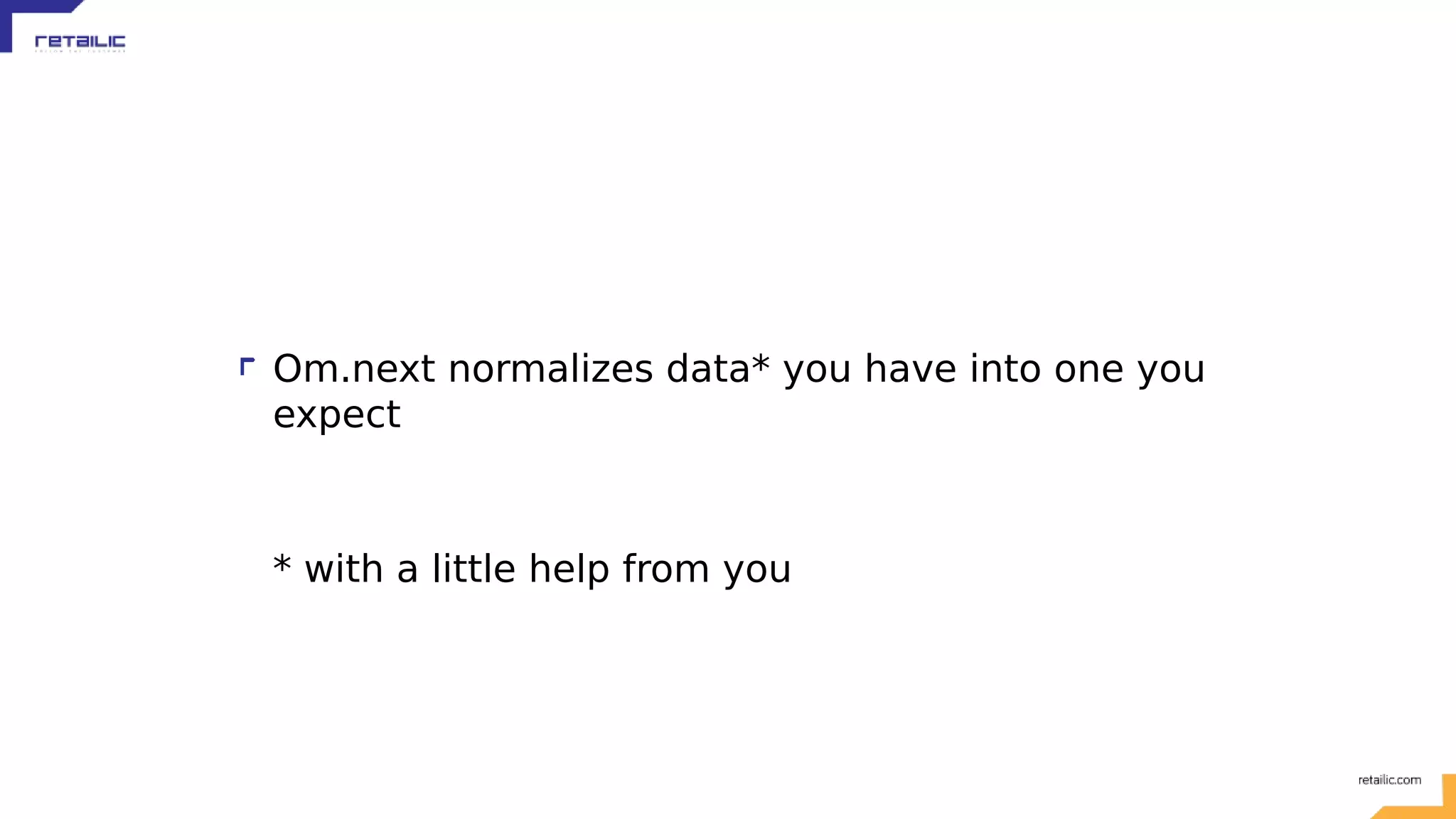
![{:list/one [{:product-name "soy milk" :price 10} {:product-name "eggs" :price 22} {:product-name "juice" :price 26}] :list/two [{:product-name "eggs" :price 22 :discount 7} {:product-name "apples" :price 8} {:product-name "cereals" :price 37 :discount 15}]}](https://image.slidesharecdn.com/reactiveprogramminginclojurescriptusingreactjswrappers-160221140934/75/Reactive-programming-in-clojure-script-using-reactjs-wrappers-90-2048.jpg)
![(defui Product static om/Ident (ident [this {:keys [product-name]}] [:product/by-name product-name]) static om/IQuery (query [this] '[:name :price :discount]) Object (render [this] ;; ... elided ...))](https://image.slidesharecdn.com/reactiveprogramminginclojurescriptusingreactjswrappers-160221140934/75/Reactive-programming-in-clojure-script-using-reactjs-wrappers-91-2048.jpg)
![(d{:list/one [[:product/by-name "soy milk"] [:product/by-name "eggs"] [:product/by-name "juice"]], :list/two [[:product/by-name "eggs"] [:product/by-name "apples"] [:product/by-name "cereals"]], :product/by-name {"soy milk" {:name "soy milk", :price 10}, "eggs" {:name "eggs", :price 22, :discount 7}, "juice" {:name "juice", :price 26}, "apples" {:name "apples", :price 8}, "cereals" {:name "cereals", :price 37, :discount 15}}](https://image.slidesharecdn.com/reactiveprogramminginclojurescriptusingreactjswrappers-160221140934/75/Reactive-programming-in-clojure-script-using-reactjs-wrappers-92-2048.jpg)
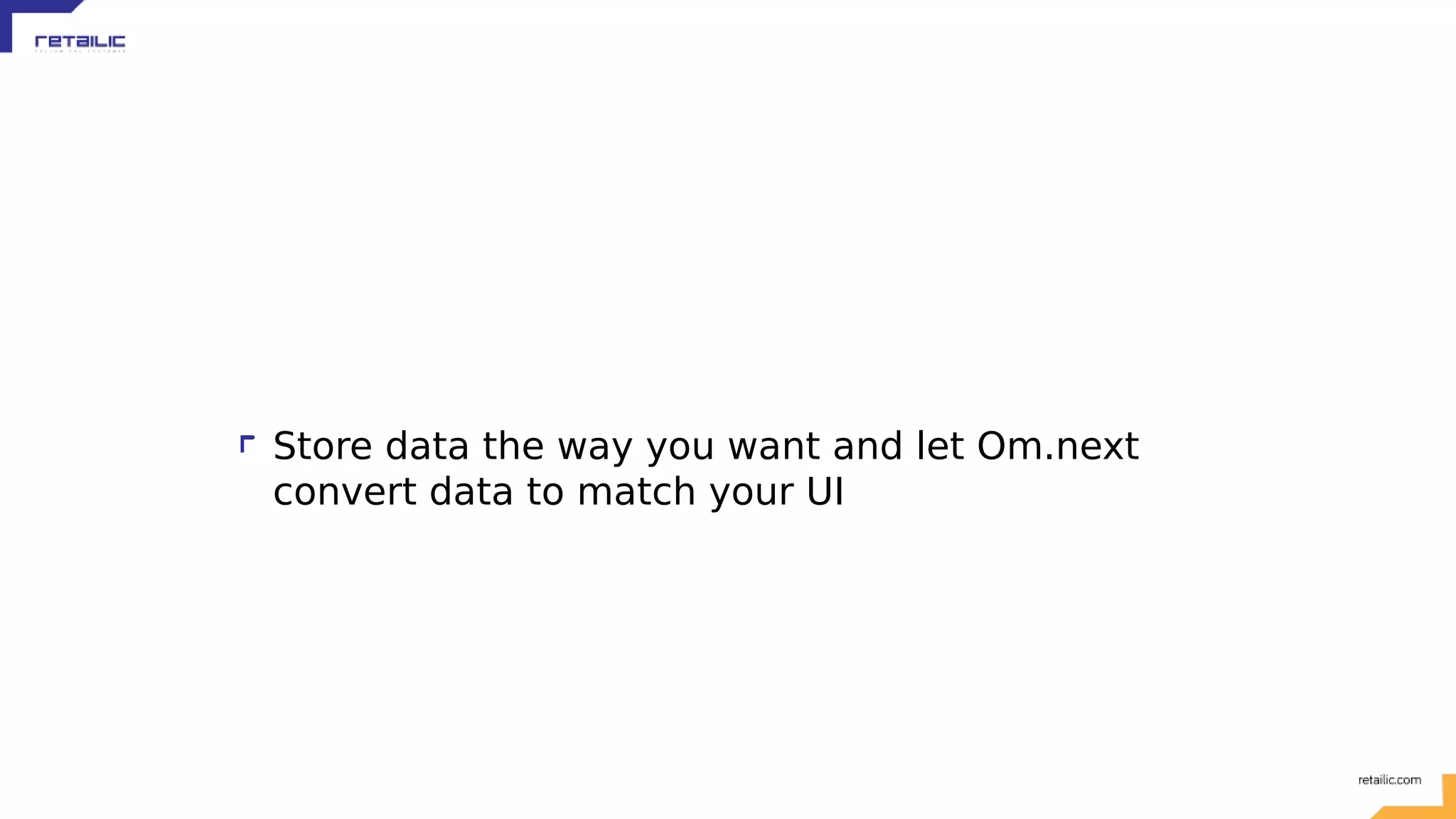
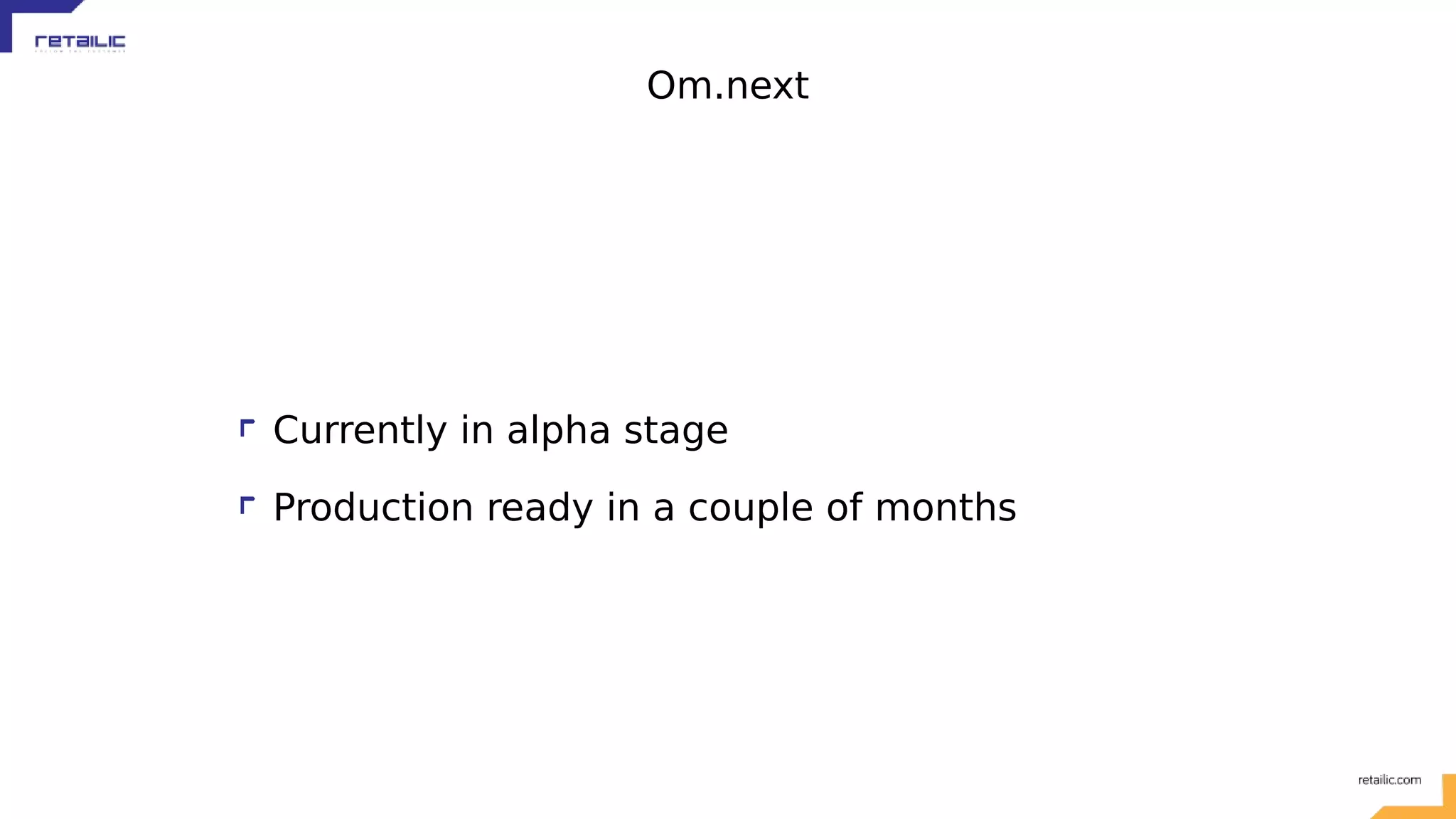
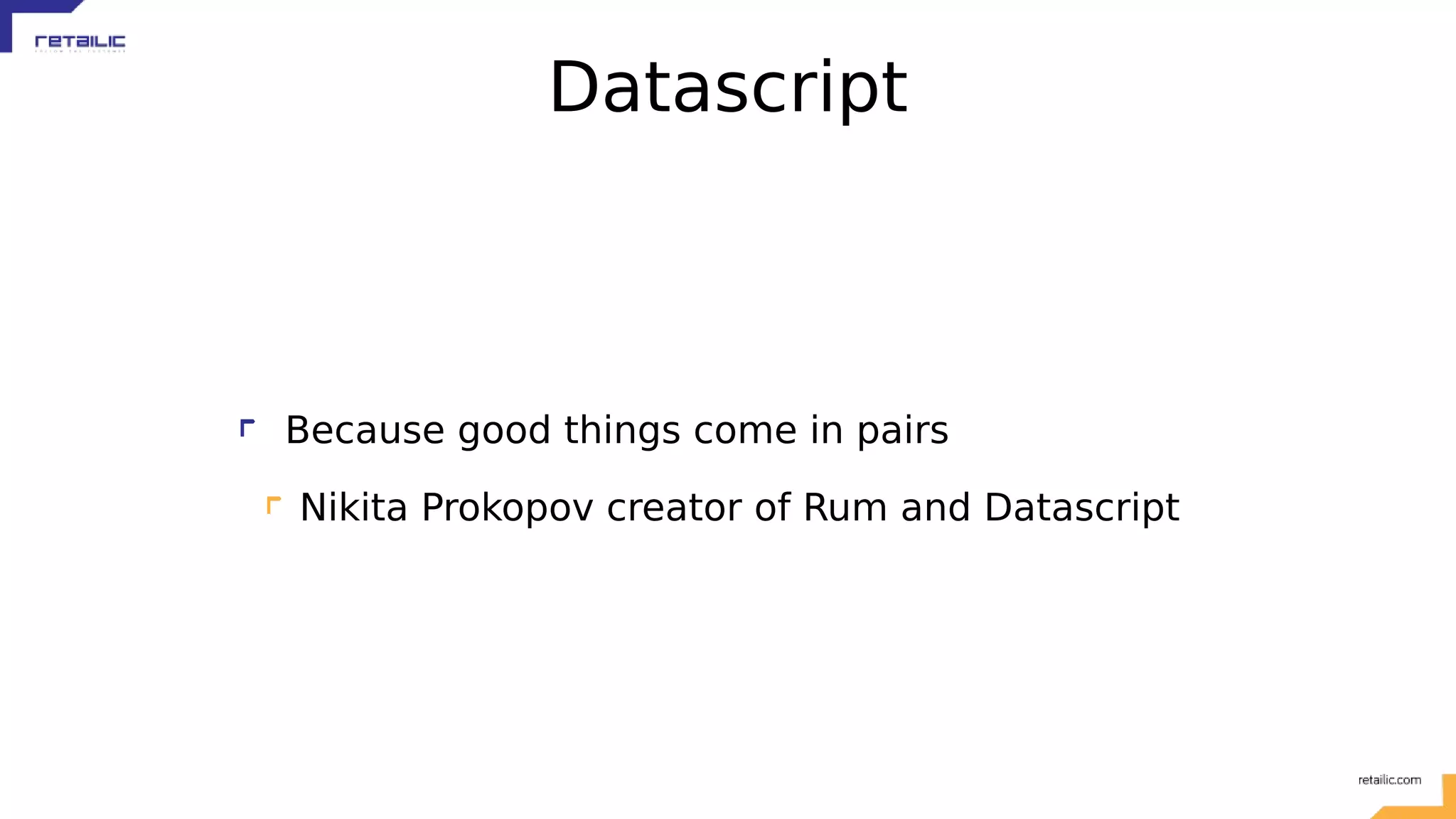
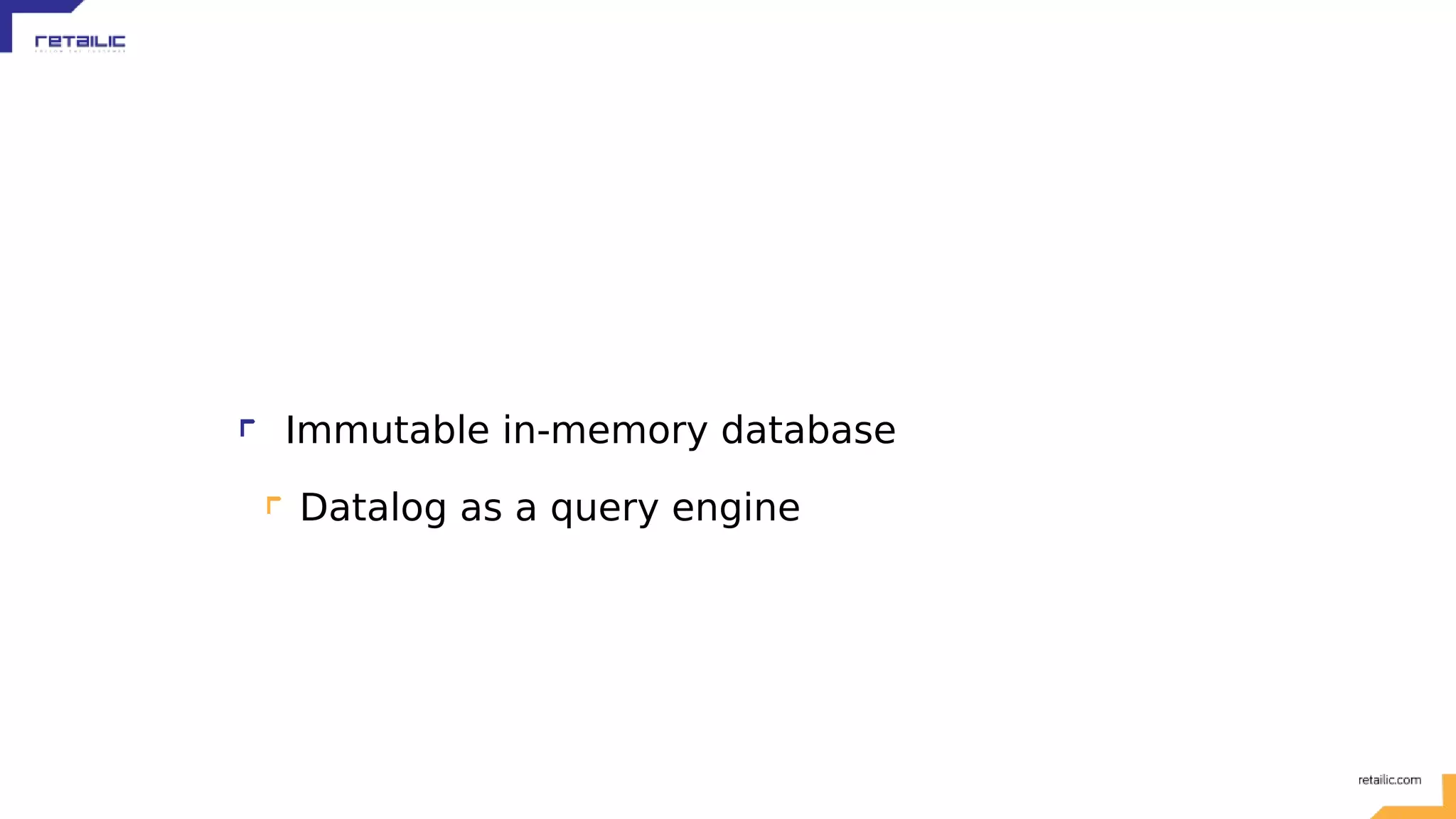
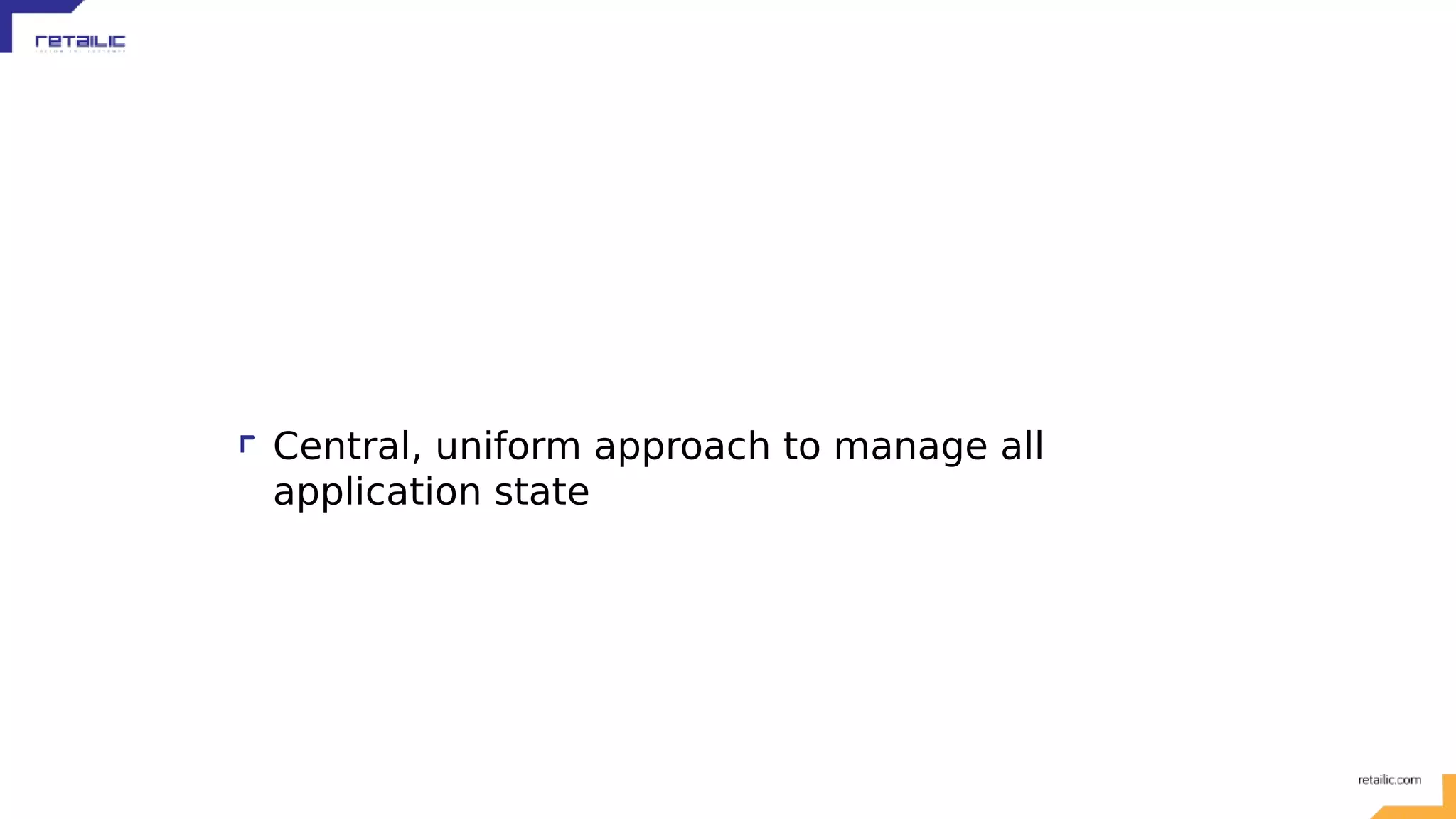
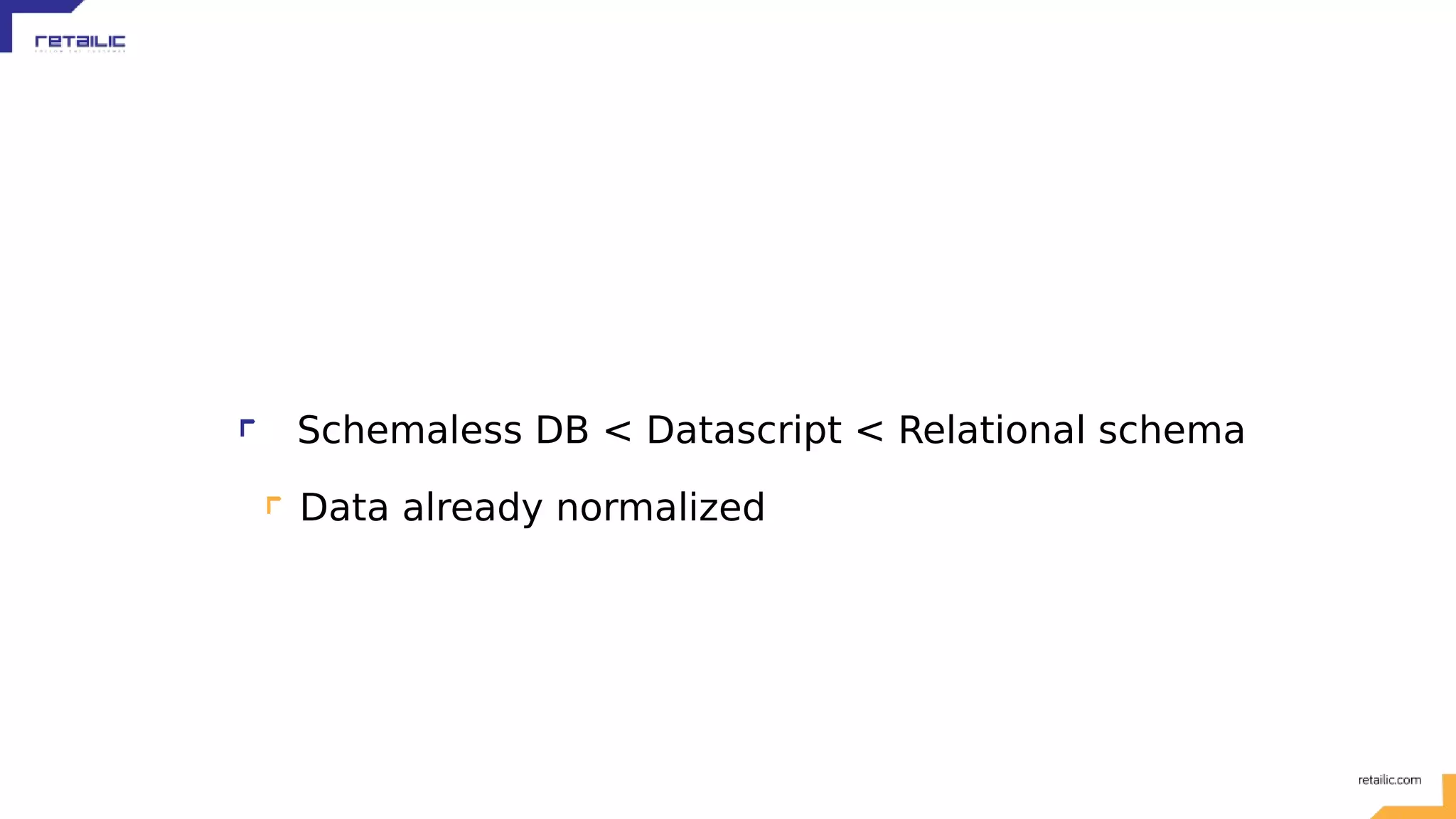
![{:db/id #db/id[:db.part/db] :db/ident :product/name :db/valueType :db.type/string :db/cardinality :db.cardinality/one :db/unique :db.unique/identity :db/doc "Product's name"} {:db/id #db/id[:db.part/db] :db/ident :product/price :db/valueType :db.type/number :db/cardinality :db.cardinality/one :db/doc "Product's price"}](https://image.slidesharecdn.com/reactiveprogramminginclojurescriptusingreactjswrappers-160221140934/75/Reactive-programming-in-clojure-script-using-reactjs-wrappers-99-2048.jpg)
![Datalog query [:find ?name ?price ?discount :where [?p :product/name ?name] [?p :product/price ?price] [?p :product/discount ?discount]]](https://image.slidesharecdn.com/reactiveprogramminginclojurescriptusingreactjswrappers-160221140934/75/Reactive-programming-in-clojure-script-using-reactjs-wrappers-100-2048.jpg)
![(defui Product static om/Ident (ident [this {:keys [product-name]}] [:product/by-name product-name]) static om/IQuery (query [this] '[:name :price :discount]) Object (render [this] ;; ... elided ...))](https://image.slidesharecdn.com/reactiveprogramminginclojurescriptusingreactjswrappers-160221140934/75/Reactive-programming-in-clojure-script-using-reactjs-wrappers-101-2048.jpg)
![Find specific item [:find ?name ?price ?discount :in $ ?name :where [?p :product/name ?name] [?p :product/price ?price] [?p :product/discount ?discount]]](https://image.slidesharecdn.com/reactiveprogramminginclojurescriptusingreactjswrappers-160221140934/75/Reactive-programming-in-clojure-script-using-reactjs-wrappers-102-2048.jpg)
![(rum/defc product-item [db name] (let [item (d/q '[:find ?name ?price ?discount :in $ ?name :where [?p :product/name ?name] [?p :product/price ?price] [?p :product/discount ?discount]] db name)] (when item [:p name "$" (:product/price item) "discount $" (:product/discount item)])))](https://image.slidesharecdn.com/reactiveprogramminginclojurescriptusingreactjswrappers-160221140934/75/Reactive-programming-in-clojure-script-using-reactjs-wrappers-103-2048.jpg)
